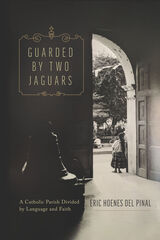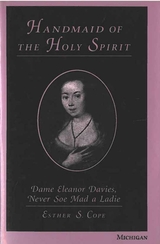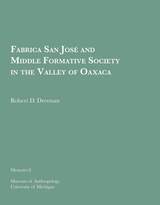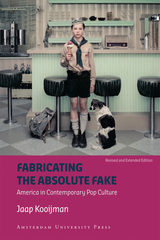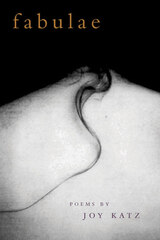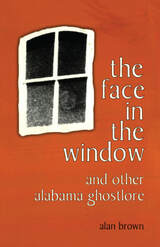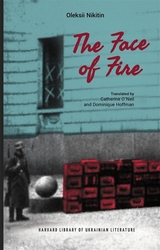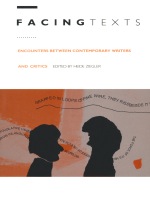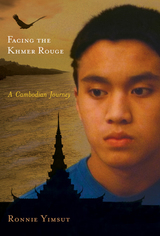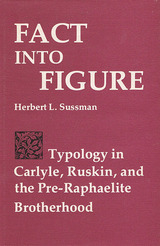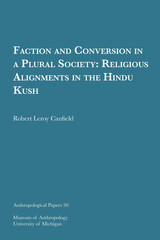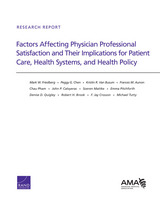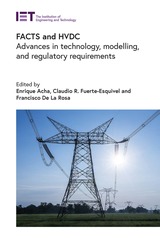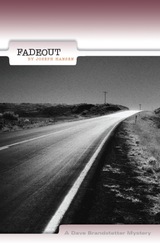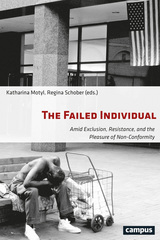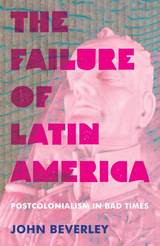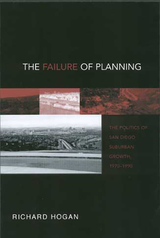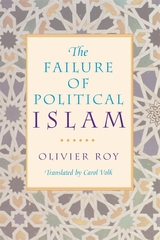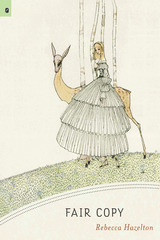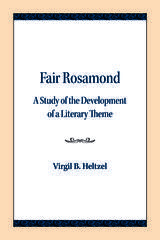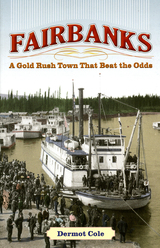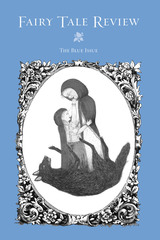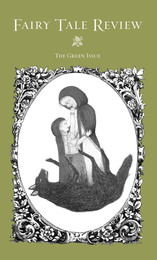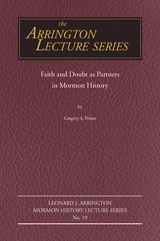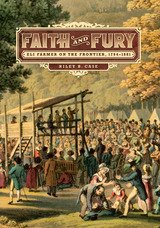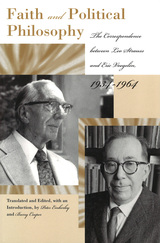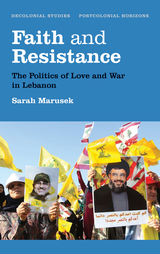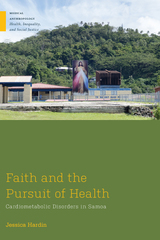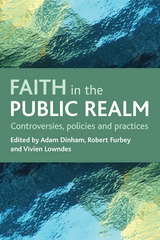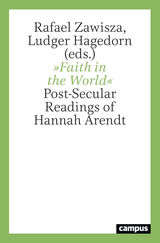 F. D. R. and the Press
Graham J. White
University of Chicago Press, 1979 Franklin D. Roosevelt's tempestuous, adversary relationship with the American press is celebrated in the literature of his administrations. Historians have documented the skill and virtuosity that he displayed in his handling and exploitation of the press. Graham J. White discovers the well of Roosevelt's excessive ardor: an intractable political philosophy that pitted him against a fierce (though imaginary) enemy, the written press.
White challenges and disproves Roosevelt's contention that the press was unusually severe and slanted in its treatment of the Roosevelt years. His original work traces FDR's hostile assessment of the press to his own political philosophy: an ideology that ordained him a champion of the people, whose task it was to preserve American democracy against the recurring attempt by Hamiltonian minorities (newspaper publishers and captive reporters) to wrest control of their destiny from the masses.
White recounts Roosevelt's initial victory over the press corps, and the effect his wily manipulations had on press coverage of his administrations and on his own public image. He believes Roosevelt's denunciation of the press was less an accurate description of the press's behavior towards his administrations than a product of his own preconceptions about the nature of the Presidency. White concludes that Roosevelt's plan was to disarm those he saw as the foes of democracy by accusing them of unfairly maligning him.
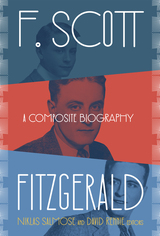 F. Scott Fitzgerald: A Composite Biography
Niklas Salmose
University of Minnesota Press, 2023 A comprehensive study of the life of F. Scott Fitzgerald, related in two-year chapters by twenty-three leading writers on the Jazz Age author
“There never was a good biography of a novelist,” F. Scott Fitzgerald wrote in The Crack-Up. “There couldn’t be. He is too many people, if he’s any good.” Fitzgerald, a good novelist by any measure, has tested this challenge to the biographer’s art. A new star illuminating the literary scene; a chronicler of the Jazz Age in all its brilliance and tarnish; a romantic symbol of the American century; an acute observer of society’s best and worst, and of his own star-crossed career; a midlife burnout at forty-four, leaving an unfinished masterpiece in his wake—he was a man of many aspects, a writer whose complexity and multitudes this composite biography finally aptly portrays. Bringing together twenty-three leading writers and scholars on Fitzgerald, each focusing on two years of his life, this volume takes its cue from Henry James’s remark, cited by preeminent Fitzgerald biographer Scott Donaldson: “The whole of anything is never told; you can only take what groups together.” F. Scott Fitzgerald: A Composite Biography presents a new way of “grouping together” biographical material and perspectives, considering from various angles the author's best-known works as well as understudied writings, including neglected stories and forays into autobiography such as “What I Think and Feel at 25” and “How to Live on $36,000 a Year.” The glamor and fame that made F. Scott and Zelda mythic figures of their time appear here alongside the personal experiences that he occasionally included in his writing: the beginnings as well as the poignant end; the literary relationships that informed and framed his work, set against solitary effort, fame, and failures. This remarkable study of F. Scott Fitzgerald reflects the multifaceted whole of a “life in many parts” in new and revelatory ways. Contributors: Jade Broughton Adams; Ronald Berman; William Blazek, Liverpool Hope U; Elisabeth Bouzonviller, Jean Monnet U; Jackson Bryer, U of Maryland; Kirk Curnutt, Troy U; Catherine Delesalle-Nancey, U Jean Moulin Lyon 3; Scott Donaldson; Kayla Forrest; Marie-Agnès Gay, U Jean Moulin Lyon 3; Joel Kabot, U of Maryland, Baltimore; Sara Kosiba; Arne Lunde, U of California, Los Angeles; Bryant Mangum, Virginia Commonwealth U; Martina Mastandrea; Philip McGowan, Queen’s U Belfast; David Page; Walter Raubicheck, Pace U; Ross Tangedal, U of Wisconsin–Stevens Point; Helen Turner, Linnaeus U; James L. W. West III, Pennsylvania State U.
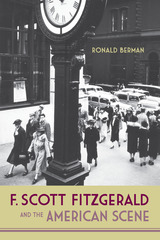 F. Scott Fitzgerald and the American Scene
Ronald Berman
University of Alabama Press, 2017 A 2018 CHOICE Outstanding Academic Title
A study of the philosophical, intellectual, and political influences on the artistic creations of Fitzgerald and key early American modernist writers
F. Scott Fitzgerald and the American Scene continues Ronald Berman’s lifelong study of the philosophical, intellectual, and political influences on the artistic creations of key early American modernist writers. Each chapter in this volume elaborates on a crucial aspect of F. Scott Fitzgerald’s depiction of American society, specifically through the lens of the social sciences that most influenced his writing and thinking.
Berman addresses, among other subjects, Fitzgerald’s use of philosophy, cultural analyses, and sociology—all enriched by the insights of his own experience living an American life. He was especially interested in how life had changed from 1910 to 1920. Many Americans were unable to navigate between the 1920s and their own memories of a very different world before the Great War; especially Daisy Buchanan who evolves from girlhood (as typified in sentimental novels of the time) to wifehood (as actually experienced in the new decade). There is a profound similarity between what happens to Fitzgerald’s characters and what happened to the nation.
Berman revisits classics like The Great Gatsby but also looks carefully at Fitzgerald’s shorter fictions, analyzing a stimulating spectrum of scholars from more contemporary critics like Thomas Piketty to George Santayana, John Maynard Keynes, John Dewey, and Walter Lippmann. This fascinating addition to F. Scott Fitzgerald scholarship, although broad in its content, is accessible to a wide audience. Scholars and students of Fitzgerald and twentieth-century American literature, as well as dedicated Fitzgerald readers, will enjoy Berman’s take on a long-debated and celebrated author.
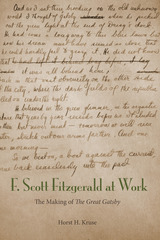 F. Scott Fitzgerald at Work: The Making of "The Great Gatsby"
Horst H. Kruse
University of Alabama Press, 2014 F. Scott Fitzgerald’s The Great Gatsby occupies a preeminent place in American letters. Scholars have argued that Jay Gatsby is, in fact, the embodiment of American cultural and social aspiration. Though The Great Gatsby has been studied in detail since its publication, both readers and scholars have continued to speculate about Fitzgerald’s sources of inspiration.
The essays in F. Scott Fitzgerald at Work examine fresh facts that illuminate the experiences and source materials upon which Fitzgerald based this quintessentially American masterpiece. They confirm author Horst Kruse’s view that Fitzgerald’s flights of fancy, even at their most spectacular, are firmly grounded in biographical experience as well as in the social, literary, and philosophical circumstances of his era.
In the first essay, Kruse reconstructs the life story of the individual who allegedly inspired the character of Jay Gatsby: Max von Gerlach. Kruse recounts his journeys to various archives and libraries in the United States as well as in Germany to unearth new facts about the genesis of the Gatsby characters. In another journey, readers travel with Kruse to Long Island to explore its physical and moral geography in relation to Fitzgerald, specifically the role of certain elite Long Island families in the advancement of the “science of eugenics” movement. The final two essays take Kruse across the globe to various destinations to consider the broader place of The Great Gatsby in American and international intellectual history.
Replete with fascinating discoveries and insights, F. Scott Fitzgerald at Work both corrects previous assumptions about The Great Gatsby and deepens our appreciation and understanding of Fitzgerald‘s imagination.
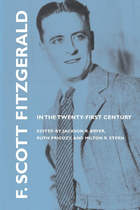 F. Scott Fitzgerald in the Twenty-First Century
Jackson R. Bryer
University of Alabama Press, 2003 This thought-provoking collection explores significant new facets of an American author of lasting international stature.
“Edited by three eminent Fitzgerald scholars, this fine book comprises nineteen incisive and provocative essays (most written for this collection) by . . . well-known Fitzgerald critics. The content is as varied as the international origins of its authors.” —Choice As the author of some of the most compelling short stories ever written, two of the central novels in American literature, and some of the most beautiful prose ever penned, F. Scott Fitzgerald is read and studied all over the world. Sixty-two years after his death, his works—protean, provocative, multilayered, and rich—continue to elicit spirited responses. This collection grew out of the F. Scott Fitzgerald Conference that convened in Princeton at the centennial of this author's birth. Bringing together dozens of the world's leading scholars and commentators, the conference and the book celebrate the ever-growing legacy of Fitzgerald's art. The subjects of these 19 essays reflect the contributors' wish to shine new light on less-frequently discussed aspects of Fitzgerald's work. Topics include Fitzgerald's Princeton influences and his expression of Catholic romanticism; his treatments of youth culture, the devil, and waste; parallels in the work of Mencken, Cather, and Murakami; and the ways gender, pastoral mode, humor, and the Civil War are variously presented in his work. One illustrated summary examines Fitzgerald's effect on popular culture through his appearance in the comics. Two broad overviews—one on Fitzgerald's career and another on the final developments in the author's style—round out the collection. The international scope of the contributors to this volume reflects Fitzgerald's worldwide reputation and appeal. With extensive treatments of This Side of Paradise, The Beautiful and Damned, The Last Tycoon, and the Pat Hobby stories, this collection makes an unusual and significant contribution to the field of Fitzgerald studies.
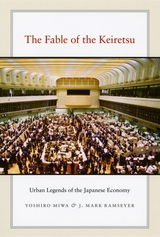 The Fable of the Keiretsu: Urban Legends of the Japanese Economy
Yoshiro Miwa and J. Mark Ramseyer
University of Chicago Press, 2006 For Western economists and journalists, the most distinctive facet of the post-war Japanese business world has been the keiretsu, or the insular business alliances among powerful corporations. Within keiretsu groups, argue these observers, firms preferentially trade, lend money, take and receive technical and financial assistance, and cement their ties through cross-shareholding agreements. In The Fable of the Keiretsu, Yoshiro Miwa and J. Mark Ramseyer demonstrate that all this talk is really just urban legend.
In their insightful analysis, the authors show that the very idea of the keiretsu was created and propagated by Marxist scholars in post-war Japan. Western scholars merely repatriated the legend to show the culturally contingent nature of modern economic analysis. Laying waste to the notion of keiretsu, the authors debunk several related “facts” as well: that Japanese firms maintain special arrangements with a “main bank,” that firms are systematically poorly managed, and that the Japanese government guided post-war growth. In demolishing these long-held assumptions, they offer one of the few reliable chronicles of the realities of Japanese business.
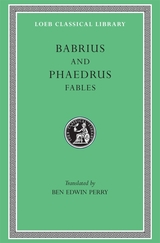 Fables
Babrius and Phaedrus
Harvard University Press Fabulous verse.
Babrius is the reputed author of a collection (discovered in the 19th century) of more than 125 fables based on those called Aesop’s, in Greek verse. He may have been a Hellenized Roman living in Asia Minor during the late first century of our era. The fables are all in one metre and in very good style, humorous and pointed. Some are original.
Phaedrus, born in Macedonia, flourished in the early half of the first century of our era. Apparently a slave set free by the emperor Augustus, he lived in Italy and began to write Aesopian fables. When he offended Sejanus, a powerful official of the emperor Tiberius, he was punished but not silenced. The fables, in five books, are in lively terse and simple Latin verse not lacking in dignity. They not only amuse and teach but also satirize social and political life in Rome.
This edition includes a comprehensive analytical Survey of Greek and Latin fables in the Aesopic tradition, as well as a historical introduction.
 Fables, Foibles, and Foobles
Carl Sandburg
University of Illinois Press, 1988 Carl Sandburg (1878-1967) is best known for his poetry (Chicago Poems, Smoke and Steel, and Good Morning, America), his books for children, including Rootabaga Country and Potato Face, and his six-volume biography of Abraham Lincoln. The Pulitzer Prize-winning Illinois author devoted his life to writing, lecturing, reading from his own works, and collecting and singing folk songs.
Sandburg often incorporated proverbs, riddles, aphorisms, and vernacular wisdom in lectures, poetry, children’s stories, and in his novel Remembrance Rock. Believing that silliness and fun helped preserve sanity and balance, he put together a collection of fanciful anecdotes - alive with alliteration - for his own amusement. Now, more than twenty years after his death, the publication of Fables, Foibles, and Foobles truly reveals, for perhaps the first time, the playful spirit of this great American poet.
George Hendrick has compiled the best of these never-before-published nonsensical pieces, which include Flies, Fleas, Flinyons, Flicks, Flooches, Flacks, Flatches, and assorted F-friends deep in dialogue about books and reading; the fascinating worlds of the curious hoomadooms, hongdorshes, and onkadonks; fables to rival Thurber; jokes about every conceivable type of nut; and cameo appearances by Hank the Honk and Flitty the Wid, among others. Robert Harvey’s whimsical drawings, scattered throughout the book, illuminate this charming cast of characters.
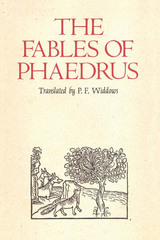 The Fables of Phaedrus
Translated by P. F. Widdows
University of Texas Press, 1992 Animal fables are said to have originated with Aesop, a semilegendary Samian slave, but the earliest surviving record of the fables comes from the Latin poet Phaedrus, who introduced the new genre to Latin literature. This verse translation of The Fables is the first in English in more than two hundred years. In addition to the familiar animal fables, about a quarter of the book includes such diverse material as prologues and epilogues, historical anecdotes, short stories, enlarged proverbs and sayings, comic episodes and folk wisdom, and many incidental glimpses of Greek and Roman life in the classical period. The Fables also sheds light on the personal history of Phaedrus, who seems to have been an educated slave, eventually granted his freedom by the emperor Augustus. Phaedrus' style is lively, clean, and sparse, though not at the cost of all detail and elaboration. It serves well as a vehicle for his two avowed purposes—to entertain and to give wise counsel for the conduct of life. Like all fabulists, Phaedrus was a moralist, albeit on a modest and popular level. An excellent introduction by P. F. Widdows provides information about Phaedrus, the history of The Fables, the metric style of the original and of this translation, and something of the place of these fables in Western folklore. The translation is done in a free version of Anglo-Saxon alliterative verse, a form used by W. H. Auden and chosen here to match the popular tone of Phaedrus' Latin verse.
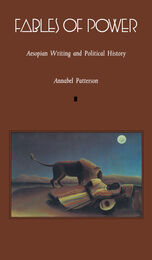 Fables of Power: Aesopian Writing and Political History
Annabel Patterson
Duke University Press, 1991 In this imaginative and illuminating work, Annabel Patterson traces the origins and meanings of the Aesopian fable, as well as its function in Renaissance culture and subsequently. She shows how the fable worked as a medium of political analysis and communication, especially from or on behalf of the politically powerless.
Patterson begins with an analysis of the legendary Life of Aesop, its cultural history and philosophical implications, a topic that involves such widely separated figures as La Fontaine, Hegel, and Vygotsky. The myth’s origin is recovered here in the saving myth of Aesop the Ethiopian, black, ugly, who began as a slave but become both free and influential, a source of political wisdom. She then traces the early modern history of the fable from Caxton, Lydgate, and Henryson through the eighteenth century, focusing on such figures as Spenser, Sidney, Lyly, Shakespeare, and Milton, as well as the lesser-known John Ogilby, Sir Roger L’Estrange, and Samuel Croxall.
Patterson discusses the famous fable of The Belly and the Members, which, because it articulated in symbolic terms some of the most intransigent problems in political philosophy and practice, was still going strong as a symbolic text in the mid-nineteenth century, where it was focused on industrial relations by Karl Marx and by George Eliot against electoral reform.
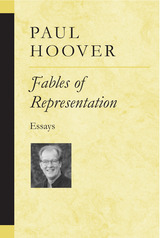 Fables of Representation: Essays
Paul Hoover
University of Michigan Press, 2004 From the acclaimed author of Winter (Mirror) and Rehearsal in Black, Fables of Representation is a powerful collection of essays on the state of contemporary poetry, free from the stultifying theoretical jargon of recent literary history.
With its title essay, "Fables of Representation," one of the most cogent studies ever written of the New York School of poets (a group that includes the influential poet John Ashbery), this book is required reading for anyone who seeks to understand the poetry and culture of the postmodern period.
Author Paul Hoover's wide-ranging subjects include African-American interdisciplinary studies; the position of poetry in the electronic age; the notion of doubleness in the work of Harryette Mullen and others; the lyricism of the New York School poets; and the role of reality in American poetry. Hoover also introduces two provocative essays sure to generate attention and discussion: "The Postmodern Era: A Final Exam" and "The New Millennium: Fifty Statements on Literature and Culture."
Paul Hoover is the editor of the anthology Postmodern American Poetry and author of nine poetry collections, including Totem and Shadow: New and Selected Poems and Viridian. His poetry has appeared in American Poetry Review, The New Republic, and The Paris Review, among others. He is Poet-in-Residence at Columbia College, Chicago.
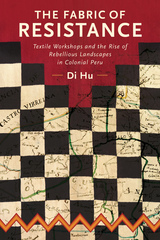 The Fabric of Resistance: Textile Workshops and the Rise of Rebellious Landscapes in Colonial Peru
Di Hu
University of Alabama Press, 2022 Examines the long-term social conditions that enabled large-scale rebellions in late Spanish colonial Peru
The Fabric of Resistance: Textile Workshops and the Rise of Rebellious Landscapes in Colonial Peru documents the impact of Spanish colonial institutions of labor on identity and social cohesion in Peru. Through archaeological and historical lines of evidence, Di Hu examines the long-term social conditions that enabled the large-scale rebellions in the late Spanish colonial period in Peru. Hu argues that ordinary people from different backgrounds pushed back against the top-down identity categories imposed by the Spanish colonial government and in the process created a cosmopolitan social landscape that later facilitated broader rebellion.
Hu’s case study is Pomacocha, the site of an important Spanish colonial hacienda (agricultural estate) and obraje (textile workshop). At its height, the latter had more than one hundred working families and sold textiles all over the Andes. Through analysis of this site, Hu explores three main long-term causes of rebellions against Spanish oppression. First, the Spanish colonial economy provided motivation and the social spaces for intercaste (indigenous, African, and mestizo) mixing at textile workshops. Second, new hybrid cultural practices and political solidarity arose there that facilitated the creation of new rebellious identities. Third, the maturation in the eighteenth century of popular folklore that reflected the harsh nature of Spanish labor institutions helped workers from diverse backgrounds gain a systemic understanding of exploitation.
This study provides a fresh archaeological and historical perspectives on the largest and most cosmopolitan indigenous-led rebellions of the Americas. Hu interweaves analyses of society at multiple scales including fine-grained perspectives of social networks, demography, and intimate details of material life in the textile workshop. She examines a wide range of data sources including artifacts, food remains, architectural plans, account books, censuses, court documents, contracts, maps, and land title disputes.
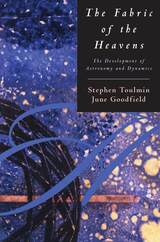 The Fabric of the Heavens: The Development of Astronomy and Dynamics
Stephen Toulmin and June Goodfield
University of Chicago Press, 1999 Conceived as three companion volumes that form an introduction to the central ideas of the modern natural sciences, these books—intelligent, informative, and accessible—are an excellent source for those who have no technical knowledge of the subject.
Praise for The Fabric of the Heavens:
"I cannot remember when I last went through a book, any book, with such all-devouring zest. What is more, even the most complex technicalities are reduced to a positively crystalline clarity: If I can understand them, anyone can. The Fabric of the Heavens is, in every sense of the word, an eye-opener."—Peter Green, The Yorkshire Post
"Not until the last chapter of the book is [the reader] allowed to think again wholly as a modern man has become accustomed, by common sense, to think. The discipline is admirably suited to the authors' task, and cunningly devised for the reader's edification—and, indeed, for his delight."—Physics Today
Praise for The Architecture of Matter:
"The Architecture of Matter is to be warmly recommended. It is that rare achievement, a lively book which at the same time takes the fullest possible advantage of scholarly knowledge."—Charles C. Gillespie, New York Times Book Review
"One is impressed by the felicity of the examples and by the lively clarity with which significant experiments and ideas are explained. . . . No other history of science is so consistently challenging."—Scientific American
Praise for The Discovery of Time:
"A subject of absorbing interest . . . is presented not as a history of science, but as a chapter in the history of ideas from the ancient Greeks to our own time."—Times Literary Supplement
Fabrica San Jose and Middle Formative Society in the Valley of Oaxaca
Robert D. Drennan
University of Michigan Press, 2019 In the early 1970s, Robert D. Drennan excavated the Middle Formative archaeological site Fábrica San José in the Valley of Oaxaca, Mexico. In this volume he presents the results of the excavations and provides a chronology of Middle Formative ceramics. Appendix on carbonized plant remains by Richard I. Ford.
Fabricating the Absolute Fake - revised edition
Jaap Kooijman
Amsterdam University Press, 2014 When rock star Bono told Oprah Winfrey that America is an ideal that is supposed to be contagious, the talk show host was moved to tears. Such an imagined America, rather than the nation-state USA, is the topic of Fabricating the Absolute Fake. Pop and politics become intertwined, as Hollywood, television, and celebrities spread the American Dream around the world. Using concepts such as the absolute fake and karaoke Americanism, the book examines this global mediation as well as the way America is appropriated in pop culture produced outside of the USA, as demonstrated by such diverse cultural icons as the Elvis-inspired crooner Lee Towers and the Moroccan-Dutch rapper Ali B. This revised and extended edition includes a new chapter on Barack Obama and Michael Jackson as global celebrities and a new afterword on teaching American pop culture.
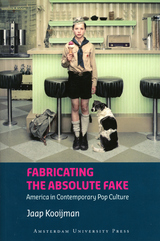 Fabricating the Absolute Fake: 'America' in Contemporary Pop Culture
Jaap Kooijman
Amsterdam University Press, 2008
From the pageantry of Oprah Winfrey’s daytime talk show to the Atlanta-based Coca-Cola empire, American “pop” culture—and the contemporary films, television programs, and cultural objects that determine it—dominates the rest of the world through its hegemonic presence. Does that make everyone a hybridized American or do these elements find mediation within the other cultures that consume them? Fabricating the Absolute Fake applies elements of postmodern theory—Jean Baudrillard’s hyperreality and Umberto Eco’s “absolute fake”, among others—to this globally mediated American pop culture in order to examine both the phenomenon itself and its specific appropriation in the Netherlands, as evidenced by diverse cultural icons like the Elvis-inspired crooner Lee Towers, the Moroccan-Dutch white rapper Ali B, musical tributes to an assassinated politician, and the Dutch reality soap opera scene.
A fascinating exploration of how global cultures struggle to create their own “America” within a post–September 11 media culture, Fabricating the Absolute Fake reflects on what it might mean to truly take part in American popular culture.
“A brilliant, thoroughly enjoyable work of cultural critique. . . . Jaap Kooijman takes seemingly exhausted concepts like “Americanization” and turns them on their head.”—Anne McCarthy, New York University
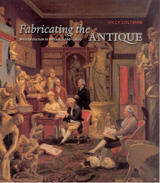 Fabricating the Antique: Neoclassicism in Britain, 1760-1800
Viccy Coltman
University of Chicago Press, 2006 Between 1760 and 1800, British aristocrats became preoccupied with the acquisition of ancient Greek and Roman artifacts. From marble busts to intricately painted vases, these antiquities were amassed in vast collections held in country houses and libraries throughout Britain. In Fabricating the Antique, Viccy Coltman examines these objects and their owners, as well as dealers, restorers, designers, and manufacturers. She provides a close look at the classical revival that resulted in this obsession with collecting antiques.
Looking at the theoretical foundations of neoclassicism, Coltman contends this reinvention of ancient material culture was more than a fabrication of style. Based in the strong emphasis on classical education during this time, neoclassicism, Coltman claims, could be more accurately described as a style of thought translated into material possessions. Fabricating the Antique is a new take on both well-known collections of ancient art and newly cataloged artifacts. This book also covers how these objects—once removed from their original context—were received, preserved, and displayed. Art historians, classicists, and archaeologists alike will benefit from this important examination of British eighteenth-century history.
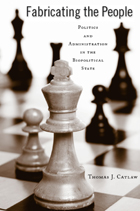 Fabricating the People: Politics and Administration in the Biopolitical State
Thomas J. Catlaw
University of Alabama Press, 2012 Since the 1960s, hostility and mistrust toward the U.S. government has risen precipitously. At the same time, the field of public administration has wrestled with its own crisis of legitimacy. What is at the root of current antigovernment sentiment? Conventionally, two explanations for this problem persist. Some see it primarily in moral terms, a deficit of Constitutional or democratic values in government. Others emphasize government’s performance failures and managerial inefficiency. Thomas J. Catlaw departs from both explanations in this groundbreaking study and demonstrates that the current crisis of government originates in the uncritical manner in which we have accepted the idea of “the People.” He contends that this unifying, foundational concept—and the notion of political representation it entails—have failed. While illuminating some of our most pressing social and political problems, Catlaw shows how the idea of the People, far from serving to unify, relies in fact on a distinctive logic of exclusion. True political power is the power to determine what constitutes the normal, natural life of the electorate. Today, the exclusionary practices that once made up or fabricated the People are increasingly contested. In turn, government and political power now appear more invasive, less legitimate, and our shared reality appears more fragmented and disconnected. In order to address this crisis and reinvigorate democracy, Catlaw argues, we must accept as bankrupt the premise of the People and the idea of representation itself. Fabricating the People boldly proposes post-representational governance that reframes the practice of modern democracy and reinvents the role of public administration.
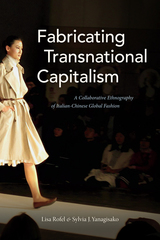 Fabricating Transnational Capitalism: A Collaborative Ethnography of Italian-Chinese Global Fashion
Lisa Rofel and Sylvia J. Yanagisako
Duke University Press, 2018 In this innovative collaborative ethnography of Italian-Chinese ventures in the fashion industry, Lisa Rofel and Sylvia J. Yanagisako offer a new methodology for studying transnational capitalism. Drawing on their respective linguistic and regional areas of expertise, Rofel and Yanagisako show how different historical legacies of capital, labor, nation, and kinship are crucial in the formation of global capitalism. Focusing on how Italian fashion is manufactured, distributed, and marketed by Italian-Chinese ventures and how their relationships have been complicated by China's emergence as a market for luxury goods, the authors illuminate the often-overlooked processes that produce transnational capitalism—including privatization, negotiation of labor value, rearrangement of accumulation, reconfiguration of kinship, and outsourcing of inequality. In so doing, Fabricating Transnational Capitalism reveals the crucial role of the state and the shifting power relations between nations in shaping the ideas and practices of the Italian and Chinese partners.
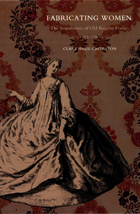 Fabricating Women: The Seamstresses of Old Regime France, 1675–1791
Clare Haru Crowston
Duke University Press, 2001 Winner of the 2002 Berkshire Prize, presented by the Berkshire Conference of Women Historians
Fabricating Women examines the social institution of the seamstresses’ guild in France from the time of Louis XIV to the Revolution. In contrast with previous scholarship on women and gender in the early modern period, Clare Haru Crowston asserts that the rise of the absolute state, with its centralizing and unifying tendencies, could actually increase women’s economic, social, and legal opportunities and allow them to thrive in corporate organizations such as the guild. Yet Crowston also reveals paradoxical consequences of the guild’s success, such as how its growing membership and visibility ultimately fostered an essentialized femininity that was tied to fashion and appearances.
Situating the seamstresses’ guild as both an economic and political institution, Crowston explores in particular its relationship with the all-male tailors’ guild, which had dominated the clothing fabrication trade in France until women challenged this monopoly during the seventeenth century. Combining archival evidence with visual images, technical literature, philosophical treatises, and fashion journals, she also investigates the techniques the seamstresses used to make and sell clothing, how the garments reflected and shaped modern conceptions of femininity, and guild officials’ interactions with royal and municipal authorities. Finally, by offering a revealing portrait of these women’s private lives—explaining, for instance, how many seamstresses went beyond traditional female boundaries by choosing to remain single and establish their own households—Crowston challenges existing ideas about women’s work and family in early modern Europe.
Although clothing lay at the heart of French economic production, social distinction, and cultural identity, Fabricating Women is the first book to investigate this immense and archetypal female guild in depth. It will be welcomed by students and scholars of French and European history, women’s and labor history, fashion and technology, and early modern political economy.
Fabrication of GaAs Devices
Albert G. Baca
The Institution of Engineering and Technology, 2005 This book provides fundamental and practical information on all aspects of GaAs processing and gives pragmatic advice on cleaning and passivation, wet and dry etching and photolithography. Other topics covered include device performance for HBTs (Heterojunction Bipolar Transistors) and FETs (Field Effect Transistors), how these relate to processing choices, and special processing issues such as wet oxidation, which are especially important in optoelectronic devices. This book is suitable for both new and practising engineers.
 The Fabrication of Social Order: A Critical Theory of Police Power
Mark Neocleous
Pluto Press, 2000 Anyone who considers questions of power cannot help but be struck by the ubiquitous nature, emotional force and political pull of the concept of order. The Fabrication of Social Order examines the role of policing in the fabrication of order.
After an initial exploration of the original relationship between police, state power and the question of order, Neocleous focuses on the ways in which eighteenth century liberalism refined and narrowed the concept of the police, a process which masked the power of capital and broader issues of social control. In doing so he challenges the way liberalism came to define policing solely in terms of the question of crime and the rule of law. This liberal definition created a limited and fundamentally misleading understanding of policing which remains in use today.
In contrast, Neocleous argues for an expanded concept of police, adequate to the expansive set of institutions through which policing takes place. These institutions are concerned not just with the maintenance or reproduction of order, but with its fabrication, especially the fabrication of a social order based on wage labour. This project, he argues, should be understood as the project of social security. Grasping this point allows a fuller understanding of the ways in which the state polices and secures civil society, and how order is fabricated through law and administration.
 Fabrications, Volume 11
Tina Mai Chen and Paola Zamperini, eds.
Duke University Press This special issue of positions deals at once with the concrete and abstract meaning of the word fabrication itself. In the concrete, fabrication refers to actual garments created and worn in a society. In the abstract, it alludes to the social characterizations of class, ethnicity, nationality, and gender attributed to fashion. This special issue explores the self-conscious efforts in cultural China and Japan to exert social position, using body and cloth as the crucial points in the construction of identity, modernity, and imagination. By focusing on clothing and body practices in East Asia, this collection delves into the dynamic interplay between global trade, images, products, and standards as mediated through and on individual bodies. It investigates what fashion means in the Asian context, past and present, and enters into the debate on fashion as a modern phenomenon predicated upon capitalism and consumerism. One contributor critically assesses ideas about the proper proportions and display of breasts—including implants and other nonsurgical practices for enhancement—in Japan and how such norms may be affected and altered by the spread of a global Euro-American beauty ideology. Another essay debates the influence of globalization and cultural localization on the emergence and popularity of exposed short stockings in China. Fabrications also features a translation of Eileen Chang’s classic article "Chronicle of Changing Clothes," which has defined thinking on Chinese fashion since the 1920s. Contributors. Peter Carroll, Tina Mai Chen, Matthew Chew, Antonia Finnane, Henrietta Harrison, Andrew Jones, Laura Miller, Henrietta Harrison, Paola Zamperini
Fabulae
Joy Katz
Southern Illinois University Press, 2002 In Fabulae, Joy Katz interrogates the physical world, constructing a sensual and striking autobiography. She turns to the familiarity and strangeness of the female body, its surfaces and inner workings, often, although her subjects range from Thomas Jefferson to an Adam and Eve plagued with obsessive-compulsive disorder to the streets of New York’s diamond district. The poems, by turns funny and philosophical, point to how we suffer from desire: the danger, she writes, is that we might love the world “like heaven and be lost.” But they come back to delight in a flawed world especially the palpable beauty of words, and even the erotic shapes of the letterforms that make them up.
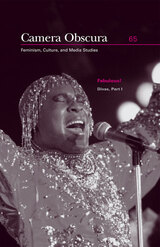 Fabulous! Divas, Part 1, Volume 22
Alexander Doty , ed.
Duke University Press From Josephine Baker to Judy Garland to Elton John, the figure of the diva occupies a fascinating place in American culture. This special issue of Camera Obscura explores the impact of divas (and divos) in film and popular culture and considers their fraught psychic and social positioning. Contributors examine how divas are frequently portrayed as both victims and villains and how they can be figures of worship as well as of ridicule for their attempts to confront, transcend, or carve a new space within the patriarchal dominant culture. This collection looks at how divas cause “category trouble” by refusing to stay in their proper culturally assigned roles—gender, race, and class—in order to live life on their own terms, making them important figures for other groups at the margins of the dominant culture. The contributors to Fabulous! Divas I (the first in a two-part series) address how Baker’s dual image as sexualized black woman and multicultural mother has been used to question and invert stereotypes, how the diva witches in the Broadway musical Wicked have developed a cult following among adolescent girls, and how fans mix irony and sincerity in their admiration of daytime soap divas. One contributor explores the cultural work of camp, while another considers hair as a fetish item for diva devotees. Among the diva appreciations are a look at the life of the cross-dressing black disco diva Sylvester, a reading of Garland as a lesbian diva par excellence, an examination of Courtney Love as a martyr diva, and a consideration of how loving Julie Andrews can make people queer. Contributors. Alexander Doty, Brett Farmer, Joshua Gamson, Chuck Jackson, Ramon Lobato, Edward R. O’Neill, Ann Pellegrini, Julie Levine Russo, Nick Salvato, Jeanne Scheper, Edward Baron Turk, Stacy Wolf
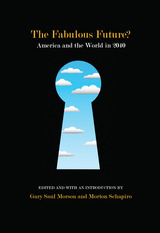 The Fabulous Future?: America and the World in 2040
Morton Schapiro and Gary Saul Morson
Northwestern University Press, 2015 Will the future be one of economic expansion, greater tolerance, liberating inventions, and longer, happier lives? Or do we face economic stagnation, declining quality of life, and a technologically enhanced totalitarianism worse than any yet seen? The Fabulous Future? America and the World in 2040 draws its inspiration from a more optimistic time, and tome, The Fabulous Future: America in 1980, in which Fortune magazine celebrated its twenty-fifth anniversary by publishing the predictions of thought leaders of its time. In the present volume, the world’s leading specialists from diverse fields project developments in their areas of expertise, from religion and the media to the environment and nanotechnology. Will we be happier, and what exactly does happiness have to do with our economic future? Where is higher education heading and how should it develop? And what is the future of prediction itself? These exciting essays provoke sharper questions, reflect unexpectedly on one another, and testify to our present anxieties about the surprising world to come.
 Face Boss: The Memoir of a Western Kentucky Coal Miner
Michael D. Guillerman
University of Tennessee Press, 2009 Face Boss tells a story that few people have heard: what it is really like to labor inside the dark and dangerous world of a vast underground coal mine. With unflinching honesty, as well as considerable humor and insight, Michael Guillerman recalls his nearly eighteen years of working as both a union miner and a salaried section foreman-or “face boss”-at the Peabody Coal Company's Camp No. 2 mine in Union County, Kentucky.
Guillerman undertook this memoir because of the many misconceptions about coal mining that were evidenced most recently in the media coverage of the 2006 Sago Mine disaster. Shedding some much-needed light on this little-understood topic, Face Boss is riveting, authentic, and often raw. Guillerman describes in stark detail the risks, dangers, and uncertainties of coal mining: the wildcat and contract strikes, layoffs, shutdowns, mine fires, methane ignitions, squeezes, and injuries. But he also discusses the good times that emerged despite perilous working conditions: the camaraderie and immense sense of accomplishment that came with mining hundreds of tons of coal every day. Along the way, Guillerman spices his narrative with numerous anecdotes from his many years on the job and discusses race relations within mining culture and the expanding role of women in the industry.
While the book contributes significantly to the general knowledge of contemporary mining, Face Boss is also a tribute to those men and women who toil anonymously beneath the rolling hills of western Kentucky and the other coal-rich regions of the United States. More than just the story of one man's life and career, it is a stirring testament to the ingenuity, courage, and perseverance of the American coal miner.
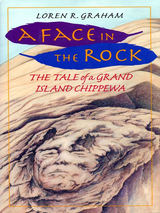 A Face in the Rock: The Tale Of A Grand Island Chippewa
Loren Graham
Island Press, 1995 Eight miles long and four miles wide, Grand Island lies off the south shore of Lake Superior. It was once home to a sizable community of Chippewa Indians who lived in harmony with the land and with each other. Their tragic demise began early in the nineteenth century when their fellow tribesmen from the mainland goaded them into waging war against rival Sioux. The war party was decimated; only one young brave, Powers of the Air, lived to tell the story that celebrated the heroism of his band and formed the basis of the legend that survives today. Distinguished historian Loren R. Graham has spent more than forty years researching and reconstructing the poignant tale of Powers of the Air and his people. A Face in the Rock is an artful melding of human history and natural history; it is a fascinating narrative of the intimate relation between place and people.
Powers of the Air lived to witness the desecration of Grand Island by the fur and logging industries, the Christianization of the tribe, and the near total loss of the Chippewa language, history, and culture. Graham charts the plight of the Chippewa as white culture steadily encroaches, forcing the native people off the island and dispersing their community on the mainland. The story ends with happier events of the past two decades, including the protection of Grand Island within the National Forest system, and the resurgence of Chippewa culture.
The Face in the Window and Other Alabama Ghostlore
Alan Brown
University of Alabama Press, 1996 The first scholarly collection of ghostlore from throughout the state of Alabama
Both enlightening and entertaining, The Face in the Window and Other Alabama Ghostlore is the first scholarly collection of ghostlore from throughout the state of Alabama. Alan Brown has traveled the state collecting sotries and photographs illustrating the places that gave rise to the eerie tales.
Brown recreates the experience of actually hearing the tales by reproducing each story as it was told. Additionally, he includes an analysis of the folk motifs and themes that run through the ghostlore commonly found in Alabama and examines their contributions to folk traditions, especially in those stories told by young people.
The Face of Fire
Oleksii Nikitin
Harvard University Press In the wake of the horrors of civil war, the Holodomor, and Stalin’s purges, the young Jewish boxer Ilya Goldinov and his wife, Feliksa, are looking ahead to a brighter future in Kyiv. Ilya, the top heavyweight boxer of the Ukrainian Soviet Republic, is primed for victory as champion of the entire Soviet Union. Feliksa, a country girl and a star athlete in track, is deep in training for a major race. Then the Nazi invasion in the summer of 1941 changes everything.
The Face of Fire offers a tapestry of Ukrainian life under the brutal Soviet and Nazi regimes—all based on declassified People’s Commissariat for Internal Affairs (NKVD) files and Oleksii Nikitin’s family archive.
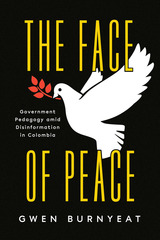 The Face of Peace: Government Pedagogy amid Disinformation in Colombia
Gwen Burnyeat
University of Chicago Press, 2022 A multi-scale ethnography of government pedagogy in Colombia and its impact on peace.
Colombia’s 2016 peace agreement with the FARC guerrillas sought to end fifty years of war and won President Juan Manuel Santos the Nobel Peace Prize. Yet Colombian society rejected it in a polarizing referendum, amid an emotive disinformation campaign. Gwen Burnyeat joined the Office of the High Commissioner for Peace, the government institution responsible for peace negotiations, to observe and participate in an innovative “peace pedagogy” strategy to explain the agreement to Colombian society. Burnyeat’s multi-scale ethnography reveals the challenges government officials experienced communicating with skeptical audiences and translating the peace process for public opinion. She argues that the fatal flaw in the peace process lay in government-society relations, enmeshed in culturally liberal logics and shaped by the politics of international donors. The Face of Peace offers the Colombian case as a mirror to the global crisis of liberalism, shattering the fantasy of rationality that haunts liberal responses to “post-truth” politics.
 The Face on the Screen: Death, Recognition & Spectatorship
Therese Davis
Intellect Books, 1995 There was a time in screen culture when the facial close-up was a spectacular and mysterious image…
The constant bombardment of the super-enlarged, computer-enhanced faces of advertising, the endless 'talking heads' of television and the ever-changing array of film stars' faces have reduced the face to a banal image, while the dream of early film theorists that the 'giant severed heads' of the screen could reveal 'the soul of man' to the masses is long since dead. And yet the end of this dream opens up the possibility for a different view of the face on the screen. The aim of the book is to seize this opportunity to rethink the facial close-up in terms other than subjectivity and identity by shifting the focus to questions of death and recognition.
In doing so, the book proposes a dialectical reversal or about-face. It suggests that we focus our attention on the places in contemporary media where the face becomes unrecognisable, for it is here that the facial close-up expresses the powers of death. Using Walter Benjamin's theory of the dialectical image as a critical tool, the book provides detailed studies of a wide range of media spectacles of faces becoming unrecognisable. It shows how the mode of recognition enabled by these faces is a shock experience that can open our eyes to the underside of the mask of self - the unrecognisable mortal face of self we spend our lives trying not to see. Turning on itself, so to speak, the face exposes the fragile relationship between social recognition and facial recognizability in the images-cultures of contemporary media.
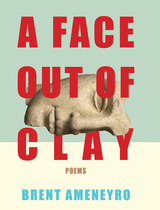 A Face Out of Clay
Brent Ameneyro
University Press of Colorado, 2024 Written at the convergence of imagination and memory, A Face Out of Clay delves deep into childhood experiences and cultural identity. Through eloquent verses and poignant imagery, alternating between narrative and lyric poems, the book paints a complicated portrait of a bi-national speaker. The poems navigate the interplay between Mexican roots and the American experience, seeking to reconcile both cultural identities. They present themes of social justice, family bonds, and the power of cultural traditions, highlighting both difficult truths and everyday beauty. The poems transport readers back in time, reliving childhood innocence, natural disasters, and political oppressors. They serve as a reminder of the power of nostalgia along with the challenges that come with recreating memories. A Face Out of Clay is a profound exploration of the human experience, inviting readers to reflect, celebrate, and connect with the transformative power of poetry.
Face Recognition Technologies: Designing Systems that Protect Privacy and Prevent Bias
Douglas Yeung
RAND Corporation, 2020 Face recognition technologies (FRTs) have many practical security-related purposes, but advocacy groups and individuals have expressed apprehensions about their use. This report highlights the high-level privacy and bias implications of FRT systems. The authors propose a heuristic with two dimensions -- consent status and comparison type -- to help determine a proposed FRT's level of privacy and accuracy. They also identify privacy and bias concerns.
 Face to Face with Everything: How Philosophy Looks at the World and What It Sees
Scott Randall Paine
St. Augustine's Press, 2025 An introduction to philosophy often approaches the branches of philosophy to describe this particular science, but what about approaching it from the more general and obvious areas of human knowledge? And one not meant for polymaths, but vigorous seekers that can't help crossing boundaries along the way? Scott Randall Paine writes for the committed of heart and the specialist who feels constrained. As he suggests, "Inside every specialist there is a generalist trying to get out."
Among a myriad of books on philosophy, Paine celebrates the true philosopher: the reader who seeks to know that which has a bearing on everything. This is a book unlike any other. The reality we live in has a kind of 'face', and philosophy is a way of engaging this entity. "Who are you? What can you tell me about being human?" Can certain encounters in science and other branches of knowledge be like seeing the half-smile of Mona Lisa? What a tease and yet how much to be discovered upon the right inquiry! Philosophy in this regard can be incredibly daunting, as it brings us face to face not just with particulars, but with everything.
Paine's trajectory is captured in his table of contents. First, he approaches synoptic and cenoscopic philosophy, and then he deals with philosophy and the following categories: humanities, production and liberal arts, physical sciences, life sciences, social sciences, religion, modernity, idioscopy, and the range of the cenoscopic. Paine is successful in his attempt to be exemplary more than strictly conclusive. This is a book for highly engaged (but not necessarily technical) individuals who need to remember to stay hungry.
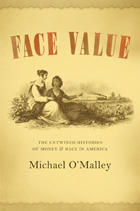 Face Value: The Entwined Histories of Money and Race in America
Michael O'Malley
University of Chicago Press, 2012 From colonial history to the present, Americans have passionately, even violently, debated the nature and the character of money. They have painted it and sung songs about it, organized political parties around it, and imprinted it with the name of God—all the while wondering: is money a symbol of the value of human work and creativity, or a symbol of some natural, intrinsic value? In Face Value, Michael O’Malley provides a deep history and a penetrating analysis of American thinking about money and the ways that this ambivalence unexpectedly intertwines with race. Like race, money is bound up in questions of identity and worth, each a kind of shorthand for the different values of two similar things. O’Malley illuminates how these two socially constructed hierarchies are deeply rooted in American anxieties about authenticity and difference. In this compelling work of cultural history, O’Malley interprets a stunning array of historical sources to evaluate the comingling of ideas about monetary value and social distinctions. More than just a history, Face Value offers us a new way of thinking about the present culture of coded racism, gold fetishism, and economic uncertainty.
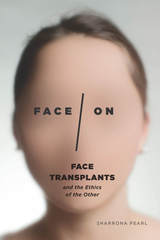 Face/On: Face Transplants and the Ethics of the Other
Sharrona Pearl
University of Chicago Press, 2017 Are our identities attached to our faces? If so, what happens when the face connected to the self is gone forever—or replaced? In Face/On, Sharrona Pearl investigates the stakes for changing the face–and the changing stakes for the face—in both contemporary society and the sciences.
The first comprehensive cultural study of face transplant surgery, Face/On reveals our true relationships to faces and facelessness, explains the significance we place on facial manipulation, and decodes how we understand loss, reconstruction, and transplantation of the face. To achieve this, Pearl draws on a vast array of sources: bioethical and medical reports, newspaper and television coverage, performances by pop culture icons, hospital records, personal interviews, films, and military files. She argues that we are on the cusp of a new ethics, in an opportune moment for reframing essentialist ideas about appearance in favor of a more expansive form of interpersonal interaction. Accessibly written and respectfully illustrated, Face/On offers a new perspective on face transplant surgery as a way to consider the self and its representation as constantly present and evolving. Highly interdisciplinary, this study will appeal to anyone wishing to know more about critical interventions into recent medicine, makeover culture, and the beauty industry.
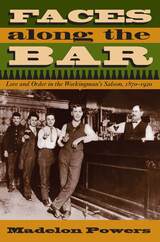 Faces along the Bar: Lore and Order in the Workingman's Saloon, 1870-1920
Madelon Powers
University of Chicago Press, 1998 In this lively and engaging history, Madelon Powers recreates the daily life of the barroom, exploring what it was like to be a "regular" in the old-time saloon of pre-prohibition industrial America. Through an examination of saloongoers across America, her investigation offers a fascinating look at rich lore of the barroom—its many games, stories, songs, free lunch customs, and especially its elaborate system of drinking rituals that have been passed on for decades.
"A free-pouring blend of astonishing facts, folklore and firsthand period observations. . . . It's the rich details that'll inspire the casual reader to drink deep from this tap of knowledge."—Don Waller, USA Today recommended reading
"A surprise on every page."—Publishers Weekly
"Here we get social history that appreciates the bar talk even while dissecting its marvelous rituals."—Library Journal, starred review
"Careful scholarship with an anecdotal flair to please even the most sober of readers."—Nina C. Ayoub, Chronicle of Higher Education
Faces in the Forest: The Endangered Muriqui Monkeys of Brazil
Karen B. Strier
Harvard University Press, 1999 The woolly spider monkey, or muriqui, is one of the most threatened primate species in the world. Because of deforestation in their natural habitat—the Atlantic coastal forests of southeastern Brazil—the muriquis are confined to less than 3 percent of their original range. As of 1987, there were only a dozen forest fragments known to support a total muriqui population of about 500. As of 1998, at least 20 forests are known to support at least 1,000 muriquis. This book traces the natural history of the muriqui from its scientific discovery in 1806 to its current, highly endangered status.
Karen Strier provides a case study of this scientifically important primate species by balancing field research and ecological issues. Through her accessible presentation, readers gain a broad understanding of primate behavior and tropical conservation.
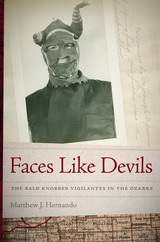 Faces Like Devils: The Bald Knobber Vigilantes in the Ozarks
Matthew J. Hernando
University of Missouri Press, 2019 In the twenty-first century, the word vigilante usually conjures up images of cinematic heroes like Batman, Zorro, the Lone Ranger, or Clint Eastwood in just about any film he’s ever been in. But in the nineteenth century, vigilantes roamed the country long before they ever made their way onto the silver screen. In Faces Like Devils, Matthew J. Hernando closely examines one of the most famous of these vigilante groups—the Bald Knobbers. Hernando sifts through the folklore and myth surrounding the Bald Knobbers to produce an authentic history of the rise and fall of Missouri’s most famous vigilantes. He details the differences between the modernizing Bald Knobbers of Taney County and the anti-progressive Bald Knobbers of Christian County, while also stressing the importance of Civil War-era violence with respect to the foundation of these vigilante groups. Despite being one of America’s largest and most famous vigilante groups during the nineteenth century, the Bald Knobbers have not previously been examined in depth. Hernando’s exhaustive research, which includes a plethora of state and federal court records, newspaper articles, and firsthand accounts, remedies that lack. This account of the Bald Knobbers is vital to anyone not wanting to miss out on a major part of Missouri’s history.
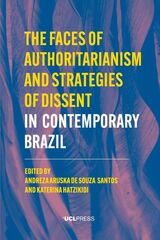 The Faces of Authoritarianism and Strategies of Dissent in Contemporary Brazil
Edited by Andreza de Souza Santos and Katerina Hatzikidi
University College London, 2025 A powerful analysis of Brazil’s authoritarian resurgence and the dynamic strategies of dissent that redefined political resistance.
Faces of Authoritarianism and Strategies of Dissent in Contemporary Brazil dissects the Bolsonaro era as a critical moment in Brazil’s long history of democratic struggle, outlining how authoritarianism took shape and how it was challenged. Rather than viewing Bolsonaro’s presidency as an anomaly, this volume situates it within broader historical and political continuities and highlights the ways state and non-state actors alike engaged in battles over democracy’s meaning.
Interlacing interdisciplinary perspectives, the book explores key arenas of contestation, from institutions under siege to grassroots resistance, providing theoretical depth and rich ethnographic accounts. With a focus on repression and resistance and the shifting boundaries of democratic governance, Faces of Authoritarianism displays a crucial framework for understanding Brazil’s political landscape and its global implications. Required reading for scholars of authoritarianism, democracy, and Latin American politics, this book offers a nuanced view of how democratic backsliding is met with acts of defiance and negotiation.
 Faces of Contemporary Russia: Advanced Russian Language and Culture
Olga M. Mesropova
Georgetown University Press, 2023 eTextbooks are now available to purchase or rent through VitalSource.com! Please visit VitalSource for more information on pricing and availability. Faces of Contemporary Russia is a one-semester textbook for high-intermediate to advanced level Russian students that aims to develop students' linguistic proficiency by examining significant personalities in current Russian culture. In addition to introductory and concluding chapters, the book features twelve individuals (one per chapter), drawing from a range of areas such as arts, sports, journalism, and business. While upper-level Russian textbooks tend to emphasize grammar and reading more traditional works of Russian literature, this book instead seeks to primarily engage students in learning about and discussing the breadth of contemporary Russian culture while weaving the study of grammar and vocabulary into those discussions. In addition to readings and in-class communicative activities, the book also features guided research assignments that encourage students to make use of the many personality interviews and YouTube clips available online. For Instructors: Exam copies of the textbook are available free of charge to instructors and can be ordered on this page. To request a print sample, please use the "print" exam copy button. To request a digital sample, instructors should log onto VitalSource.com, select "Faculty Sampling" in the upper right-hand corner, and select the desired product.
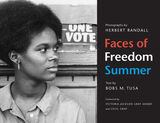 Faces of Freedom Summer
Herbert Randall and Bobs M. Tusa
University of Alabama Press, 2001 Affirms, validates, and reiterates the yearning for an orderly, peaceful and just world
The old adage “One picture is worth ten thousand words” is definitely true for Faces of Freedom Summer. There are simply not enough words to describe the period in our history that is recorded by the pictures in this book.
As this book afirms, the resurgence of overt activities by hate groups—both the old traditional ones (e.g., the Ku Klux Klan) and the new ones (e.g., the Skin Heads)—however much the hard work and sacrifices of the modern civil rights movement humanized American society, much still remains to be done. The modern civil rights movement associated with the 1960s was not in vain, yet it did not eradicate from our society the evils of racism and sexism. While we activists made the United States more of an open society than it has ever been in its history, our vision and desire for the beloved community did not reach into all sectors of American society. “Freedom,” it has been said, “is a constant struggle, a work of eternal vigilance.”
Faces of Freedom Summer brings to life that there was such a time and there were such people and, if such a people were once, then they are still among us. Yet, they may only become aware of themselves when they are confronted with visible evidence, such as the evidence contained in the pictures of Herbert Randall.
 Faces of Internationalism: Public Opinion and American Foreign Policy
Eugene R. Wittkopf
Duke University Press, 1990 In Faces of Internationalism, Eugene R. Wittkopf examines the changing nature of public attitudes toward American foreign policy in the post-Vietnam era and the role that public opinion plays in the American foreign policymaking process. Drawing on new data—four mass and four elite opinion surveys undertaken by the Chicago Council of Foreign Relations from 1974 to 1986—combined with sophisticated analysis techniques, Wittkopf offers a pathbreaking study that addresses the central question of the relationship of a democracy to its foreign policy.
The breakdown of the “consensus” approach to American foreign policy after the Cold War years has become the subject of much analysis. This study contributes to revisionist scholarship by describing the beliefs and preferences that have emerged in the wake of this breakdown. Wittkopf counters traditional views by demonstrating the persistence of U.S. public opinion defined by two dominant and distinct attitudes in the post-Vietnam war years—cooperative and militant internationalism.
The author explores the nature of these two “faces” of internationalism, focusing on the extent to which elites and masses share similar opinions and the political and sociodemographic correlates of belief systems. Wittkopf also offers an original examination of the relationship between beliefs and preferences.
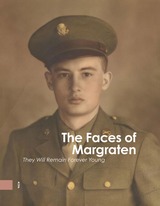 The Faces of Margraten: They Will Remain Forever Young
Amsterdam University Press, 2023 In the rolling hills of the Limburg Province, near the village of Margraten, they slowly loom up, row after row: thousands of white marble crosses and Stars of David. They mark the final resting place of American soldiers who died fighting to liberate the Netherlands during World War II. While the headstones provide the names and ages of those lost, they cannot tell us who these soldiers were, what their lives were like, or who they left behind. Nor can the peace and quiet at the only American military cemetery in the Netherlands reflect the harrowing experience and violent final moments of the men and women who forever rest here.
Through hundreds of personal photographs and more than 250 stories, The Faces of Margraten gives these soldiers faces and voices again, telling not only the history of World War II and the ending of the German occupation of the Netherlands, but also revealing how and why the Dutch people have never forgotten their liberators. Concluding with a list of all the soldiers’ names, this commemorative book stands as a testament to the service and sacrifice of the more than 10,000 Americans buried or memorialized as missing in Margraten.
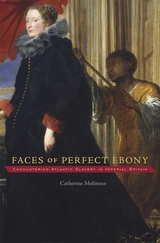 Faces of Perfect Ebony: Encountering Atlantic Slavery in Imperial Britain
Catherine Molineux
Harvard University Press, 2012 Though blacks were not often seen on the streets of seventeenth-century London, they were already capturing the British imagination. For two hundred years, as Britain shipped over three million Africans to the New World, popular images of blacks as slaves and servants proliferated in London art, both highbrow and low. Catherine Molineux assembles a surprising array of sources in her exploration of this emerging black presence, from shop signs, tea trays, trading cards, board games, playing cards, and song ballads to more familiar objects such as William Hogarth’s graphic satires. By idealizing black servitude and obscuring the brutalities of slavery, these images of black people became symbols of empire to a general populace that had little contact with the realities of slave life in the distant Americas and Caribbean.
The earliest images advertised the opulence of the British Empire by depicting black slaves and servants as minor, exotic characters who gazed adoringly at their masters. Later images showed Britons and Africans in friendly gatherings, smoking tobacco together, for example. By 1807, when Britain abolished the slave trade and thousands of people of African descent were living in London as free men and women, depictions of black laborers in local coffee houses, taverns, or kitchens took center stage.
Molineux’s well-crafted account provides rich evidence for the role that human traffic played in the popular consciousness and culture of Britain during the seventeenth and eighteenth centuries and deepens our understanding of how Britons imagined their burgeoning empire.
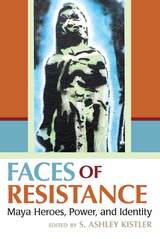 Faces of Resistance: Maya Heroes, Power, and Identity
Edited by S. Ashley Kistler
University of Alabama Press, 2018 Fosters a holistic understanding of the roles of Maya heroic figures as cornerstones of cultural identity and political resistance and power
In the sixteenth century, Q’eqchi’ Maya leader Aj Poop B’atz’ changed the course of Q’eqchi’ history by welcoming Spanish invaders to his community in peace to protect his people from almost certain violence. Today, he is revered as a powerful symbol of Q’eqchi’ identity. Aj Poop B’atz’ is only one of many indigenous heroes who has been recognized by Maya in Mexico and Guatemala throughout centuries of subjugation, oppression, and state-sponsored violence.
Faces of Resistance: Maya Heroes, Power, and Identity explores the importance of heroes through the analyses of heroic figures, some controversial and alternative, from the Maya area. Contributors examine stories of hero figures as a primary way through which Maya preserve public memory, fortify their identities, and legitimize their place in their country’s historical and political landscape. Leading anthropologists, linguists, historians, and others incorporate ethnographic, ethnohistoric, and archival material into their chapters, resulting in a uniquely interdisciplinary book for scholars as well as students.
The essays offer the first critical survey of the broad significance of these figures and their stories and the ways that they have been appropriated by national governments to impose repressive political agendas. Related themes include the role of heroic figures in the Maya resurgence movement in Guatemala, contemporary Maya concepts of “hero,” and why some assert that all contemporary Maya are heroes.
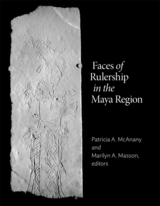 Faces of Rulership in the Maya Region
Patricia A. McAnany and Marilyn A. Masson
Harvard University Press Authority—whether royal, divine, material, fleeting, or enduring—varied across space and time in the Maya region, from its Preclassic dynastic origins through the colonial encounters of the sixteenth century. The changing faces of Maya rulership and their foundational ties to symbolic material objects, architecture, ancestral beings, deities, and written monuments are fully explored in the fifteen chapters of Faces of Rulership in the Maya Region. The contributors track rulership—beyond the prevalent paradigm of divine kingship—by considering the power of queens and unravelling codes embedded in art and public buildings. Through the close study of the agency of rulers who often sought to distinguish themselves from other dynasts, the contributors come to an enhanced understanding of the relational dynamics between rulers and subject peoples. The book reveals that rulership was perpetually challenged in ways that impacted adjacent institutions of nobles and literati. Applying concepts of rulership outlined in On Kings by David Graeber and Marshall Sahlins, this volume brings Maya history and archaeology into the current, anthropological conversation about rulership in premodern times.
 Faces of the Fremont: Anthropomorphic Figurines in Fremont Society
David T. Yoder
University of Utah Press, 2025 A comprehensive catalogue of every known figurine from the Fremont culture
The Fremont culture is famous for its anthropomorphic figurines—small clay figures occasionally dressed in clothing and decorated with jewelry—but surprisingly, archaeologists know very little about these important artifacts and their place in Fremont society. In Faces of the Fremont, the largest study of the subject ever undertaken, David T. Yoder takes a straightforward approach to cultural commentary through artifactual analysis as he interprets over 800 figurines and anthropomorphic objects.
Unlike previous research on the subject, this volume explores neglected topics within Fremont studies, including sex and gender, clothing and body decoration, hairstyles, and childhood. Complete with in-depth analysis and interpretation of the significance of the figurines to the Fremont people, as well as hundreds of beautiful color photographs, Faces of the Fremont provides a nuanced understanding of figurine manufacture, formalizes a classification system for figurine traits, and documents new and interesting geographic and temporal patterns.
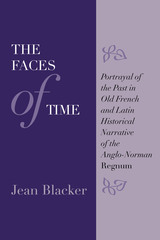 The Faces of Time: Portrayal of the Past in Old French and Latin Historical Narrative of the Anglo-Norman Regnum
Jean Blacker
University of Texas Press, 1994 The twelfth century witnessed the sudden appearance and virtual disappearance of an important literary genre—the Old French verse chronicle. These poetic histories of the British kings, which today are treated as fiction, were written contemporaneously with Latin prose narratives, which are regarded as historical accounts. In this pathfinding study, however, Jean Blacker asserts that twelfth-century authors and readers viewed both genres as factual history. Blacker examines four Old French verse chronicles—Gaimar's Estoire des Engleis (c. 1135), Wace's Roman de Brut (c. 1155) and Roman de Rou (c. 1160–1174), and Benoît de Sainte-Maure's Chronique des Ducs de Normandie (c. 1174–1180) and four Latin narratives—William of Malmesbury's Gesta Regum (c. 1118–1143) and Historia Novella (c. 1140–1143), Orderic Vitalis's Historia Ecclesiastica (c. 1118–1140), and Geoffrey of Monmouth's Historia Regum Britanniae (c. 1138). She compares their similarity in three areas—the authors' stated intentions, their methods of characterization and narrative development, and the possible influences of patronage and audience expectation on the presentation of characters and events. This exploration reveals remarkable similarity among the texts, including their idealization of historical and even legendary figures, such as King Arthur. It opens fruitful lines of inquiry into the role these writers played in the creation of the Anglo-Norman regnum and suggests that the Old French verse chronicles filled political, psychic, and aesthetic needs unaddressed by Latin historical writing of the period.
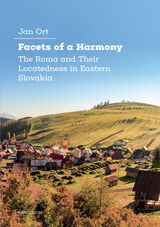 Facets of a Harmony: The Roma and Their Locatedness in Eastern Slovakia
Jan Ort
Karolinum Press, 2022 A crucial contribution to Romani studies focuses on a single Slovak village to explore universal issues of belonging.
In this important contribution to contemporary Romani studies, Jan Ort focuses his anthropological research on a village in eastern Slovakia reputed for the ostensibly seamless coexistence of its ethnically and linguistically heterogeneous inhabitants. Ort offers an ethnographic critique of this idyllic view, showing how historical shifts, as well as the naturalization of inequality and hierarchies, have led to the present situation between the village’s Roma inhabitants and other ethnic populations. However, he also shows examples and methods of subversion and resistance to the village’s current power dynamics. Based primarily on participant observation within Roma families, Ort’s long-term research results in a fascinating book replete with ethnographic descriptions that allow readers to understand local experiences, contexts, and divisions. These insights about the village lead to the key question of the book: Who actually is a local?
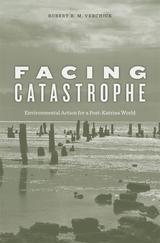 Facing Catastrophe: Environmental Action for a Post-Katrina World
Robert R. M. Verchick
Harvard University Press, 2012 As Hurricane Katrina vividly revealed, disaster policy in the United States is broken and needs reform. What can we learn from past disasters—storms, floods, earthquakes, tsunamis, landslides, and wildfires—about preparing for and responding to future catastrophes? How can these lessons be applied in a future threatened by climate change?
In this bold contribution to environmental law, Robert Verchick argues for a new perspective on disaster law that is based on the principles of environmental protection. His prescription boils down to three simple commands: Go Green, Be Fair, and Keep Safe. “Going green” means minimizing exposure to hazards by preserving natural buffers and integrating those buffers into artificial systems like levees or seawalls. “Being fair” means looking after public health, safety, and the environment without increasing personal and social vulnerabilities. “Keeping safe” means a more cautionary approach when confronting disaster risks.
Verchick argues that government must assume a stronger regulatory role in managing natural infrastructure, distributional fairness, and public risk. He proposes changes to the federal statutes governing environmental impact assessments, wetlands development, air emissions, and flood control, among others. Making a strong case for more transparent governmental decision-making, Verchick offers a new vision of disaster law for the next generation.
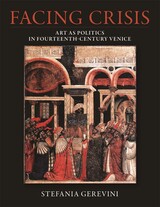 Facing Crisis: Art as Politics in Fourteenth-Century Venice
Stefania Gerevini
Harvard University Press Though Venice emerged as a leading Mediterranean power in the Trecento, the city faced a series of crises during a brief but cataclysmic period coinciding with Andrea Dandolo’s dogeship (1343–1354): earthquakes, disease, fierce military conflicts, and dramatic political and institutional tensions had the republic on edge. It was nevertheless precisely at this time that the government sponsored the ambitious and sumptuous artistic campaigns in San Marco that are at the heart of this book: a reliquary-chapel, a new baptistery, and a folding altarpiece, all masterpieces crafted with unparalleled technical skill, blending Byzantine and Italianate visual forms.
Far from being mere artistic commissions, these works were affirmative political interventions that interrogated the meaning of community, authority, and (shared) political leadership at a time when those notions were unsettled. Looking beyond established concepts of triumph and imperialism, Facing Crisis situates the artistic interactions between Byzantium and Venice into ongoing processes of state formation and attests to the power of images to inform—and transform—political imaginations in troubled times. This study thus offers new insights into how medieval communities across the Mediterranean understood and responded to uncertainty through the visual, and, in doing so, probes the value of “crisis” as a methodological framework.
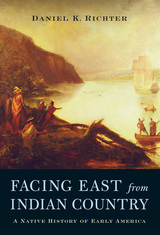 Facing East from Indian Country: A Native History of Early America
Daniel K. Richter
Harvard University Press, 2003 In the beginning, North America was Indian country. But only in the beginning. After the opening act of the great national drama, Native Americans yielded to the westward rush of European settlers. Or so the story usually goes. Yet, for three centuries after Columbus, Native people controlled most of eastern North America and profoundly shaped its destiny. In Facing East from Indian Country, Daniel K. Richter keeps Native people center-stage throughout the story of the origins of the United States.
Viewed from Indian country, the sixteenth century was an era in which Native people discovered Europeans and struggled to make sense of a new world. Well into the seventeenth century, the most profound challenges to Indian life came less from the arrival of a relative handful of European colonists than from the biological, economic, and environmental forces the newcomers unleashed. Drawing upon their own traditions, Indian communities reinvented themselves and carved out a place in a world dominated by transatlantic European empires. In 1776, however, when some of Britain’s colonists rebelled against that imperial world, they overturned the system that had made Euro-American and Native coexistence possible. Eastern North America only ceased to be an Indian country because the revolutionaries denied the continent’s first peoples a place in the nation they were creating.
In rediscovering early America as Indian country, Richter employs the historian’s craft to challenge cherished assumptions about times and places we thought we knew well, revealing Native American experiences at the core of the nation’s birth and identity.
 Facing Georgetown's History: A Reader on Slavery, Memory, and Reconciliation
Adam Rothman and Elsa Barraza Mendoza, Editors. Foreword by Lauret Savoy
Georgetown University Press, 2023 A microcosm of the history of American slavery in a collection of the most important primary and secondary readings on slavery at Georgetown University and among the Maryland Jesuits Georgetown University’s early history, closely tied to that of the Society of Jesus in Maryland, is a microcosm of the history of American slavery: the entrenchment of chattel slavery in the tobacco economy of the Chesapeake in the seventeenth and eighteenth centuries; the contradictions of liberty and slavery at the founding of the United States; the rise of the domestic slave trade to the cotton and sugar kingdoms of the Deep South in the nineteenth century; the political conflict over slavery and its overthrow amid civil war; and slavery’s persistent legacies of racism and inequality. It is also emblematic of the complex entanglement of American higher education and religious institutions with slavery. Important primary sources drawn from the university's and the Maryland Jesuits' archives document Georgetown’s tangled history with slavery, down to the sizes of shoes distributed to enslaved people on the Jesuit plantations that subsidized the school. The volume also includes scholarship on Jesuit slaveholding in Maryland and at Georgetown, news coverage of the university’s relationship with slavery, and reflections from descendants of the people owned and sold by the Maryland Jesuits. These essays, articles, and documents introduce readers to the history of Georgetown's involvement in slavery and recent efforts to confront this troubling past. Current efforts at recovery, repair, and reconciliation are part of a broader contemporary moment of reckoning with American history and its legacies. This reader traces Georgetown’s “Slavery, Memory, and Reconciliation Initiative” and the role of universities, which are uniquely situated to conduct that reckoning in a constructive way through research, teaching, and modeling thoughtful, informed discussion.
 Facing It: AIDS Diaries and the Death of the Author
Ross Chambers
University of Michigan Press, 2001 For a generation or more, literary theorists have used the metaphor of "the death of the author" in considering the observation that to write is to abdicate control over the meanings one's text is capable of generating. But in the case of AIDS diaries, the metaphor can be literal. Facing It examines the genre not in classificatory terms but pragmatically, as the site of a social interaction. Through a detailed study of three such diaries, originating respectively in France, the United States, and Australia, Ross Chambers demonstrates that issues concerning the politics of AIDS writing and the ethics of reading are linked by a common concern with the problematics of survivorhood. Two of the diaries chosen for special attention in this light are video diaries: La Pudeur ou l'impudeur by Hervé Guibert (author of To the Friend Who Did Not Save My Life), and Silverlake Life, by the American videomaker Tom Joslin (aided by his lover and friends, notably Peter Friedman). The third is a defiant but anxious text, Unbecoming, by an American anthropologist, Eric Michaels, who died in Brisbane, Australia, in 1988. Other authors more briefly examined include Pascal de Duve, Bertrand Duquénelle, Alain Emmanuel Dreuilhe, David Wojnarowicz, Gary Fisher, and the filmmaker (not a diarist) Laurie Lynd. Finally, Facing It takes on the issue of its own relevance, asking what contributions literary criticism can make in the midst of an epidemic.
"Groundbreaking in its approach and potentially wide in its appeal. . . . The rigor of the ideas, their dramatic nature, and the political drive of the rhetoric all should win Facing It a large readership that could extend far beyond students of narrative or queer theory." --David Bergman, Towson University, editor of Camp Grounds: Style and Homosexuality
Ross Chambers is Distinguished University Professor of French and Comparative Literature, University of Michigan, and author of Room for Maneuver: Reading (the) Oppositional (in) Narrative and Story and Situation: Narrative Seduction and the Power of Fiction.
 Facing It: AIDS Diaries and the Death of the Author
Ross Chambers
University of Michigan Press, 1999 For a generation or more, literary theorists have used the metaphor of "the death of the author" in considering the observation that to write is to abdicate control over the meanings one's text is capable of generating. But in the case of AIDS diaries, the metaphor can be literal. Facing It examines the genre not in classificatory terms but pragmatically, as the site of a social interaction. Through a detailed study of three such diaries, originating respectively in France, the United States, and Australia, Ross Chambers demonstrates that issues concerning the politics of AIDS writing and the ethics of reading are linked by a common concern with the problematics of survivorhood. Two of the diaries chosen for special attention in this light are video diaries: La Pudeur ou l'impudeur by Hervé Guibert (author of To the Friend Who Did Not Save My Life), and Silverlake Life, by the American videomaker Tom Joslin (aided by his lover and friends, notably Peter Friedman). The third is a defiant but anxious text, Unbecoming, by an American anthropologist, Eric Michaels, who died in Brisbane, Australia, in 1988. Other authors more briefly examined include Pascal de Duve, Bertrand Duquénelle, Alain Emmanuel Dreuilhe, David Wojnarowicz, Gary Fisher, and the filmmaker (not a diarist) Laurie Lynd. Finally, Facing It takes on the issue of its own relevance, asking what contributions literary criticism can make in the midst of an epidemic.
"Groundbreaking in its approach and potentially wide in its appeal. . . . The rigor of the ideas, their dramatic nature, and the political drive of the rhetoric all should win Facing It a large readership that could extend far beyond students of narrative or queer theory." --David Bergman, Towson University, editor of Camp Grounds: Style and Homosexuality
Ross Chambers is Distinguished University Professor of French and Comparative Literature, University of Michigan, and author of Room for Maneuver: Reading (the) Oppositional (in) Narrative and Story and Situation: Narrative Seduction and the Power of Fiction.
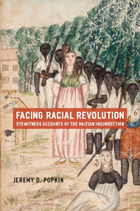 Facing Racial Revolution: Eyewitness Accounts of the Haitian Insurrection
Jeremy D. Popkin
University of Chicago Press, 2008 The only truly successful slave uprising in the Atlantic world, the Haitian Revolution gave birth to the first independent black republic of the modern era. Inspired by the revolution that had recently roiled their French rulers, black slaves and people of mixed race alike rose up against their oppressors in a bloody insurrection that led to the burning of the colony’s largest city, a bitter struggle against Napoleon’s troops, and in 1804, the founding of a free nation.
Numerous firsthand narratives of these events survived, but their invaluable insights into the period have long languished in obscurity—until now. In Facing Racial Revolution, Jeremy D. Popkin unearths these documents and presents excerpts from more than a dozen accounts written by white colonists trying to come to grips with a world that had suddenly disintegrated. These dramatic writings give us our most direct portrayal of the actions of the revolutionaries, vividly depicting encounters with the uprising’s leaders—Toussaint Louverture, Boukman, and Jean-Jacques Dessalines—as well as putting faces on many of the anonymous participants in this epochal moment. Popkin’s expert commentary on each selection provides the necessary background about the authors and the incidents they describe, while also addressing the complex question of the witnesses’ reliability and urging the reader to consider the implications of the narrators’ perspectives.
Along with the American and French revolutions, the birth of Haiti helped shape the modern world. The powerful, moving, and sometimes troubling testimonies collected in Facing Racial Revolution significantly expand our understanding of this momentous event.
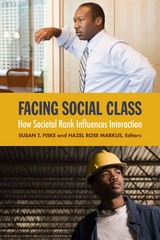 Facing Social Class: How Societal Rank Influences Interaction
Susan T. Fiske
Russell Sage Foundation, 2012 Many Americans, holding fast to the American Dream and the promise of equal opportunity, claim that social class doesn't matter. Yet the ways we talk and dress, our interactions with authority figures, the degree of trust we place in strangers, our religious beliefs, our achievements, our senses of morality and of ourselves—all are marked by social class, a powerful factor affecting every domain of life. In Facing Social Class, social psychologists Susan Fiske and Hazel Rose Markus, and a team of sociologists, anthropologists, linguists, and legal scholars, examine the many ways we communicate our class position to others and how social class shapes our daily, face-to-face interactions—from casual exchanges to interactions at school, work, and home. Facing Social Class exposes the contradiction between the American ideal of equal opportunity and the harsh reality of growing inequality, and it shows how this tension is reflected in cultural ideas and values, institutional practices, everyday social interactions, and psychological tendencies. Contributor Joan Williams examines cultural differences between middle- and working-class people and shows how the cultural gap between social class groups can influence everything from voting practices and political beliefs to work habits, home life, and social behaviors. In a similar vein, Annette Lareau and Jessica McCrory Calarco analyze the cultural advantages or disadvantages exhibited by different classes in institutional settings, such as those between parents and teachers. They find that middle-class parents are better able to advocate effectively for their children in school than are working-class parents, who are less likely to challenge a teacher's authority. Michael Kraus, Michelle Rheinschmidt, and Paul Piff explore the subtle ways we signal class status in social situations. Conversational style and how close one person stands to another, for example, can influence the balance of power in a business interaction. Diana Sanchez and Julie Garcia even demonstrate that markers of low socioeconomic status such as incarceration or unemployment can influence whether individuals are categorized as white or black—a finding that underscores how race and class may work in tandem to shape advantage or disadvantage in social interactions. The United States has one of the highest levels of income inequality and one of the lowest levels of social mobility among industrialized nations, yet many Americans continue to buy into the myth that theirs is a classless society. Facing Social Class faces the reality of how social class operates in our daily lives, why it is so pervasive, and what can be done to alleviate its effects.
Facing Texts: Encounters Between Contemporary Writers and Critics
Heide Ziegler, ed.
Duke University Press, 1988 This selection of fiction by many of America's best writers, each coupled with a distinguished critic's response, is designed to defy the chronological secondariness of critical interpretation. During the creation of this book the majority of the contributions, chosen by the writers themselves, were as yet unpublished, providing an unmediated encounter between author and critic. Every reader extends what editors, authors, and critics have begun by adding to the imaginary space in which all texts may be woven together. This process serves as metaphor for the changing nature of any latter-day encounter with one's own literary tradition. The interfacing of texts not only illuminates the fiction, and the relationship of fiction to critics, but also informs our conceptions of text, criticism, and fiction itself.
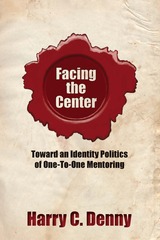 Facing the Center: Toward an Identity Politics of One-to-One Mentoring
Harry C. Denny
Utah State University Press, 2010 In the diversity of their clients as well as their professional and student staff, writing centers present a complicated set of relationships that inevitably affect the instruction they offer. In Facing the Center, Harry Denny unpacks the identity matrices that enrich teachable moments, and he explores the pedagogical dynamics and implications of identity within the writing center.
The face of the writing center, be it mainstream or marginal, majority or miority, orthodox or subversive, always has implications for teaching and learning. Facing the Center will extend current research in writing center theory to bring it in touch with theories now common in cultural studies curricula. Denny takes up issues of power, agency, language, and meaning, and pushes his readers to ask how they themselves, or the centers in which they work, might be perpetuating cultures that undermine inclusive, progressive education.
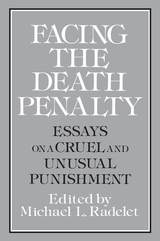 Facing the Death Penalty: Essays on a Cruel and Unusual Punishment
edited by Michael L. Radelet, foreword by Henry Schwarzschild
Temple University Press, 1990 "These essays...show us the human and inhuman realities of capital punishment through the eyes of the condemned and those who work with them. By focusing on those awaiting death, they present the awful truth behind the statistics in concrete, personal terms."
--William J. Bowers, author of Legal Homicide
Between 1930 and 1967, there were 3,859 executions carried out under state and civil authority in the United States. Since the ten-year moratorium on capital punishment ended in 1977, more than one hundred prisoners have been executed. There are more than two thousand men and women now living on death row awaiting their executions. Facing the Death Penalty offers an in-depth examination of what life under a sentence of death is like for condemned inmates and their families, how and why various professionals assist them in their struggle for life, and what these personal experiences with capital punishment tell us about the wisdom of this penal policy.
The contributors include historians, attorneys, sociologists, anthropologists, criminologists, a minister, a philosopher, and three prisoners. One of the prisoner-contributors is Willie Jasper Darden, Jr., whose case and recent execution after fourteen years on death row drew international attention. The inter-disciplinary perspectives offered in this book will not solve the death penalty debate, but they offer important and unique insights on the full effects of American capital punishment provisions. While the book does not set out to generate sympathy for those convicted of horrible crimes, taken together, the essays build a case for abolition of the death penalty.
"This work stands with the best of what's been written. It represents the best of those who have seen the worst."
--Colman McCarthy, The Washington Post Book World
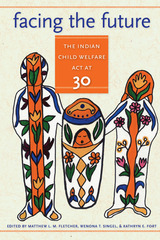 Facing the Future: The Indian Child Welfare Act at 30
Matthew L.M. Fletcher
Michigan State University Press, 2009 The U.S. Congress is charged with responsibility for the protection and preservation of American Indian tribes, including Indian children. In 1978, Congress enacted the Indian Child Welfare Act (ICWA), with the intent to "protect the best interests of Indian children and to promote the stability and security of Indian tribes and families." ICWA sets federal requirements that apply to state child custody proceedings involving an Indian child who is a member of or eligible for membership in a federally recognized tribe. ICWA also sets out federal requirements regarding removal of Indian children and their placement in foster or adoptive homes, and it allows the child's tribe to intervene in the case.
The history of the Act is a tangle of legal, social, and emotional complications. Some state courts have found unusual legal arguments to avoid applying the law, while some states have gone beyond the terms of the Act to provide greater protections for Indian people. This collection brings together for the first time a multidisciplinary assessment of the law—with scholars, practitioners, lawyers, and social workers all offering perspectives on the value and importance of the Indian Child Welfare Act.
Facing the Khmer Rouge: A Cambodian Journey
Ronnie Yimsut
Rutgers University Press, 2011 As a child growing up in Cambodia, Ronnie Yimsut played among the ruins of the Angkor Wat temples, surrounded by a close-knit community. As the Khmer Rouge gained power and began its genocidal reign of terror, his life became a nightmare. In this stunning memoir, Yimsut describes how, in the wake of death and destruction, he decides to live. Escaping the turmoil of Cambodia, he makes a perilous journey through the jungle into Thailand, only to be sent to a notorious Thai prison. Fortunately, he is able to reach a refugee camp and ultimately migrate to the United States, where he attended the University of Oregon and became an influential leader in the community of Cambodian immigrants. Facing the Khmer Rouge shows Ronnie Yimsut’s personal quest to rehabilitate himself, make a new life in America, and then return to Cambodia to help rebuild the land of his birth.
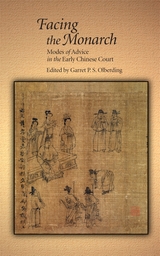 Facing the Monarch: Modes of Advice in the Early Chinese Court
Garret P. S. Olberding
Harvard University Press, 2013 In the popular consciousness, manipulative speech pervades politicized discourse, and the eloquence of politicians is seen as invariably rooted in cunning and prevarication. Rhetorical flourishes are thus judged corruptive of the substance of political discourse because they lead to distortion and confusion. Yet the papers in Facing the Monarch suggest that separating style from content is practically impossible. Focused on the era between the Spring and Autumn period and the later Han dynasty, this volume examines the dynamic between early Chinese ministers and monarchs at a time when ministers employed manifold innovative rhetorical tactics. The contributors analyze discrete excerpts from classical Chinese works and explore topics of censorship, irony, and dissidence highly relevant for a climate in which ruse and misinformation were the norm. What emerges are original and illuminating perspectives on how the early Chinese political circumstance shaped and phrased—and prohibited—modes of expression.
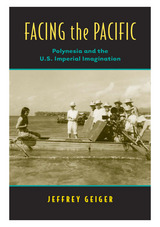 Facing the Pacific: Polynesia and the U.S. Imperial Imagination
Jeffrey Geiger
University of Hawaii Press, 2007 The enduring popularity of Polynesia in western literature, art, and film attests to the pleasures that Pacific islands have, over the centuries, afforded the consuming gaze of the west—connoting solitude, release from cares, and, more recently, self-renewal away from urbanized modern life. Facing the Pacific is the first study to offer a detailed look at the United States’ intense engagement with the myth of the South Seas just after the First World War, when, at home, a popular vogue for all things Polynesian seemed to echo the expansion of U.S. imperialist activities abroad.
Jeffrey Geiger looks at a variety of texts that helped to invent a vision of Polynesia for U.S. audiences, focusing on a group of writers and filmmakers whose mutual fascination with the South Pacific drew them together—and would eventually drive some of them apart. Key figures discussed in this volume are Frederick O’Brien, author of the bestseller White Shadows in the South Seas; filmmaker Robert Flaherty and his wife, Frances Hubbard Flaherty, who collaborated on Moana; director W. S. Van Dyke, who worked with Robert Flaherty on MGM’s adaptation of White Shadows; and Expressionist director F. W. Murnau, whose last film, Tabu, was co-directed with Flaherty.
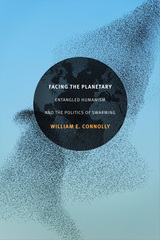 Facing the Planetary: Entangled Humanism and the Politics of Swarming
William E. Connolly
Duke University Press, 2017 In Facing the Planetary William E. Connolly expands his influential work on the politics of pluralization, capitalism, fragility, and secularism to address the complexities of climate change and to complicate notions of the Anthropocene. Focusing on planetary processes—including the ocean conveyor, glacier flows, tectonic plates, and species evolution—he combines a critical understanding of capitalism with an appreciation of how such nonhuman systems periodically change on their own. Drawing upon scientists and intellectuals such as Lynn Margulis, Michael Benton, Alfred North Whitehead, Anna Tsing, Mahatma Gandhi, Wangari Maathai, Pope Francis, Bruno Latour, and Naomi Klein, Connolly focuses on the gap between those regions creating the most climate change and those suffering most from it. He addresses the creative potential of a "politics of swarming" by which people in different regions and social positions coalesce to reshape dominant priorities. He also explores how those displaying spiritual affinities across differences in creed can energize a militant assemblage that is already underway.
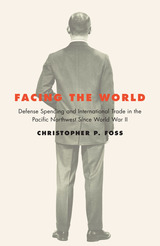 Facing the World: Defense Spending and International Trade in the Pacific Northwest Since World War II
Christopher P. Foss
Oregon State University Press, 2020 Before the Second World War, the states of Washington and Oregon were thinly populated economic backwaters of the United States. Even the major cities of Portland and Seattle were dependent on agricultural industries, especially timber, for their economic health. That all changed during World War II and the Cold War.
By the dawn of the twenty-first century, the Pacific Northwest boasted a more diversified economy. Beer, tourism, and high tech moved in alongside timber and wheat as the region’s mainstay industries. In Washington, especially, a Cold War–driven military and national security state set up shop as an economic behemoth even as debates over the costs and consequences of the new Atomic Age raged.
Facing the World highlights these changes, as well as the politicians, business leaders, and ordinary people who helped bring them about. At the center of the story, Senators Henry Jackson, Wayne Morse, Slade Gorton, and Mark Hatfield; Congressman Tom Foley; and Governor Vic Atiyeh worked diligently for a generation to transform the region from insular and backward to cosmopolitan and forward-looking. Aligning the region with national security and international trade policies, these politicians made the Pacific Northwest economy what it is today.
Through extensive research in congressional and federal archives, historian Christopher P. Foss vividly brings to life the discussions, conflicts, and controversies that shaped this political era. Though it wasn’t perfect, its fading legacy of leadership is a lesson for our own time. Facing the World will prove a valuable resource to historians, political scientists, and civic-minded residents of the Pacific Northwest.
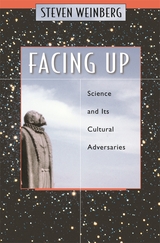 Facing Up: Science and Its Cultural Adversaries
Steven Weinberg
Harvard University Press, 2001 The New York Times’s James Glanz has called Steven Weinberg “perhaps the world’s most authoritative proponent of the idea that physics is hurtling toward a ‘final theory,’ a complete explanation of nature’s particles and forces that will endure as the bedrock of all science forevermore. He is also a powerful writer of prose that can illuminate—and sting… He recently received the Lewis Thomas Prize, awarded to the researcher who best embodies ‘the scientist as poet.’” Both the brilliant scientist and the provocative writer are fully present in this book as Weinberg pursues his principal passions, theoretical physics and a deeper understanding of the culture, philosophy, history, and politics of science.Each of these essays, which span fifteen years, struggles in one way or another with the necessity of facing up to the discovery that the laws of nature are impersonal, with no hint of a special status for human beings. Defending the spirit of science against its cultural adversaries, these essays express a viewpoint that is reductionist, realist, and devoutly secular. Each is preceded by a new introduction that explains its provenance and, if necessary, brings it up to date. Together, they afford the general reader the unique pleasure of experiencing the superb sense, understanding, and knowledge of one of the most interesting and forceful scientific minds of our era.
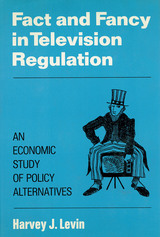 Fact and Fancy in Television Regulation: An Economic Study of Policy Alternatives
Harvey J. Levin
Russell Sage Foundation, 1980 How diverse can, and should, TV programming be? And especially, in what precise ways does governmental regulation of TV affect (or fail to affect) the programs station owners produce—programs which, in the final analysis, shape in such large measure the values of Americans? It is to these timely and beguiling questions that Harvey Levin addresses his dispassionate assessment of the complex relationship between government and the TV industry. Analyzing data drawn from the history of the FCC's regulatory decisions, as well as from interviews with numerous government and industry officials, Professor Levin shows how the present form of restrictive governmental regulation almost always results in higher profits and rents for TV stations, with no concomitant increase in programming diversity. In addition, Professor Levin investigates various other aspects of the media market, from the particular kinds of crucial decisions that are made when, for example, a newspaper owns a TV station, to the kinds of problems that arise when commercial rents are taxed to fund public TV; from the brand of programming we are offered when a monopoly controls a given TV market to the nature of programming in a situation of steady and fair competition. Following a comprehensive assessment, the author makes a compelling case for diversification of station ownership, in order to be "safe rather than sorry." He also argues for the entry of new stations, more extensive support of public TV, and some form of quantitative program requirements—all of which will help bring about greater program diversity. Professor Levin's volume provides us with a fully documented and sharply focused analysis of the theories, policies, and problems of one of the most powerful and misunderstood of contemporary institutions.
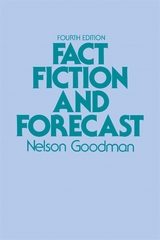 Fact, Fiction, and Forecast: Fourth Edition
Nelson Goodman
Harvard University Press, 1983 Here, in a new edition, is Nelson Goodman’s provocative philosophical classic—a book that, according to Science, “raised a storm of controversy” when it was first published in 1954, and one that remains on the front lines of philosophical debate.
How is it that we feel confident in generalizing from experience in some ways but not in others? How are generalizations that are warranted to be distinguished from those that are not? Goodman shows that these questions resist formal solution and his demonstration has been taken by nativists like Chomsky and Fodor as proof that neither scientific induction nor ordinary learning can proceed without an a priori, or innate, ordering of hypotheses.
In his new foreword to this edition, Hilary Putnam forcefully rejects these nativist claims. The controversy surrounding these unsolved problems is as relevant to the psychology of cognitive development as it is to the philosophy of science. No serious student of either discipline can afford to misunderstand Goodman’s classic argument.
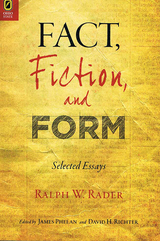 Fact, Fiction, and Form: Selected Essays
Ralph W. Rader
Ohio State University Press, 2011 Ralph W. Rader, along with Sheldon Sacks and Wayne Booth, was one of the three leading figures of the second generation of neo-Aristotelian critics. During his long career in the English Department at the University of California, Berkeley, Rader published scores of essays. Fact, Fiction, and Form: Selected Essays, edited by James Phelan and David H. Richter, collects the most important of these essays, all of them written between the late 1960s and the late 1990s. These critical inquiries, which engage with a remarkable range of literary texts—Moll Flanders, Pamela, Tristram Shandy, “Tintern Abbey,” “My Last Duchess,” Barchester Towers, Lord Jim, Ulysses, and more—are a rich resource for anyone interested in criticism’s ongoing conversations about the following major issues: the concept of form, the genres of the lyric and the novel, the literary dimensions of literary history, the distinction between fiction and nonfiction, the evaluation of literary quality, and the testing of theories and of interpretations. Moreover, the essays collectively develop a distinctive, coherent, and compelling vision of literary form, purpose, and value. Rader’s vision is distinctive and coherent because it is based not on an underlying theory of language, power, history, or culture but rather on the idea that form is the means by which humans respond to fundamental aspects and conditions of their existence in the world. His vision is compelling because it includes a rigorous set of standards for adequate interpretation against which he invites his audience to measure his own readings.
 Fact or Fluke?: A Critical Look at Statistical Evidence
Ronald Meester
Amsterdam University Press, 2022 Statistics is more topical than ever. Numerous decisions depend on statistical considerations: just think of the Corona crisis or decisions about approving new drugs or other products. If researchers announce they have proved some fact using statistical tests, can we then always be sure that their claim is correct? How, and more importantly why, does statistics work? What can we expect from statistics and what not? 'Fact or Fluke?' is not a textbook that explains statistical tests to the reader; instead, it discusses what comes before those tests: the philosophy behind the statistics. Should one carry out tests, or are there other ways to look at statistics?
Ronald Meester and Klaas Slooten use a variety of examples – from court cases to theoretical physics – to present different views on statistics and provide arguments for what they think is the best point of view. This book is meant for anyone who is in some way concerned with, or interested in, statistical evidence: scientific researchers, students, teachers, mathematicians, philosophers, lawyers, managers, and no doubt many others.
Faction and Conversion in a Plural Society: Religious Alignments in the Hindu Kush
Robert Leroy Canfield
University of Michigan Press, 1973 In this work, anthropologist Robert Leroy Canfield discusses several powerful social systems in central Afghanistan and their impact on the geographical distribution of religious sects in the area. Territorial groups, the kinship network, and community fission all play a part in why people live where they do. Canfield did his fieldwork among the residents of the province of Bamian during the years 1966 to 1968.
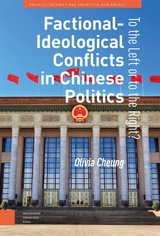 Factional-Ideological Conflicts in Chinese Politics: To the Left or to the Right?
Olivia Cheung
Amsterdam University Press, 2023 This book reconstructs the factional-ideological conflicts surrounding socialist transformation and political reform in China that were played out through ‘factional model-making’, a norm-bound mechanism for elites of the Chinese Communist Party to contest the party line publicly. Dazhai, Anhui, Nanjie, Shekou, Shenzhen, Guangdong and Chongqing were cultivated into factional models by party elites before Xi Jinping came to power in 2012. Although factional model-making undermined party discipline, it often did not threaten regime security and even contributed to regime resilience through strengthening collective leadership and other means. This follows that the suppression of factional model-making under Xi might undermine longer-term regime resilience. However, Xi believes that regime security rests on his strongman rule, not any benefits that factional model-making may contribute. It is in this spirit that he grooms Zhejiang into a party model for his policy programme of common prosperity, which is designed to legitimize his vision of socialism.
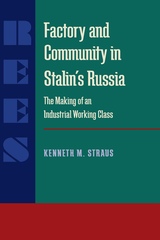 Factory and Community in Stalin’s Russia: The Making of an Industrial Working Class
Kenneth M. Straus
University of Pittsburgh Press, 1998 Kenneth Straus weaves together many threads in Russian social history to develop a new theory of working-class formation in the years of Stalin’s First Five Year Plan. In so doing, he addresses a long-standing debate among historians by suggesting new answers to an old question: Was there social support for the Stalin regime among the Soviet working class during the 1930s, and if so, why?
Straus argues that the keys for interpreting Stalinism lie in occupational specialization, on the one hand, and community organization, on the other. He focuses on the daily life of the new Soviet workers in the factory and community, arguing that the most significant new trends saw peasants becoming open hearth steel workers, housewives becoming auto assembly line workers and machine operatives, and youth training en masse rather than occupations categories in the vocational schools in the factories, the FZU.
Tapping archival material only recently available and a wealth of published sources, Straus presents Soviet social history within a new analytical framework, suggesting that Stalinist forced industrialization and Soviet proletarianization is best understood within a comparative European framework, in which the theories of Marx, Durkheim, and Weber best elucidate both the broad similarities with Western trends and the striking exceptional aspects of the Soviet experience.
FACTS and HVDC: Advances in technology, modelling, and regulatory requirements
Enrique Acha
The Institution of Engineering and Technology, 2025 A flexible AC transmission system (FACTS) provides a structured method to augment the transmission capabilities of conventional electrical energy systems. It is intended to enhance controllability, reliability and transfer capability using power electronic equipment and control techniques. HVDC are high voltage direct current systems. Both systems complement each other, they each have their specific area of application, and they can work together, in a coordinated fashion, for example, to accommodate growing shares of renewable energy such as wind power, which needs to be transferred over long distances from generation sites to demand centres.
 Facts and Visions: Twenty-Four Baccalaureate Sermons
Abbot Lawrence Lowell
Harvard University Press For twenty-four consecutive years the graduating class in Harvard College asked President Lowell to address them at their Baccalaureate Sunday service, a request which he never refused. The ardent friend of all college men everywhere and a devoutly religious man, he preached of the heart kept with diligence. As his religion was universal, there is in his sermons nothing denominational or sectarian. Above all else it was practical, and the principles of right conduct which he drove home year after year he believed should be the commonplaces of every man's life. These sermons are the unpretentious words of a man of action with a strong religious conscience saying farewell to a group of men who had enjoyed extraordinary privileges and owed a corresponding debt to the public. His language is so simple as to be almost deceptive, but the substance is deep, thoughtful, and moving, and as appropriate now as when the addresses were delivered, particularly those delivered during the First World War and post-war periods.
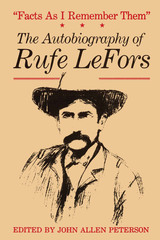 Facts as I Remember Them: The Autobiography of Rufe LeFors
Edited by John Allen Peterson
University of Texas Press, 1986 The rivers of the Texas Panhandle, the Canadian, and the forks of the Red break through the Cap Rock at the eastern edge of the Staked Plains. It’s rough, bleak country, with few trees and a great expanse of sky. Storms that form on the Great Plains and in the Rocky Mountains sweep through with nothing much to slow them down. And the small dusty towns that serve this vast ranchland cling to the waterways as they have for over a hundred years, since their early settlement. Their names aren’t well known now, but they were once focal points in a rugged country where buffalo hunters, trail drivers, outlaws, and ordinary folks alike passed through. Rufe LeFors was one such "ordinary" man. With his father and older brothers, he was among the first to settle this country, drawn to West Texas by tales of open land and good grass. His life story, set down near the end of his long and adventurous life, is the best sort of insider's history, the chronicle of a life lived fully amid the exciting events and rough landscape of the frontier's final years. Rufe LeFors recorded his story over the course of a decade, finishing up in 1941 in his eighty-first year. His memoirs span the period from the War between the States to the early twentieth century, when the Panhandle was still scarcely settled, a true frontier. In his time LeFors was trail driver, pony express rider, and rancher. He traveled for a year with Arrington's Texas Rangers, and he wore the badge of deputy sheriff in the wild west town of Old Mobeetie. He rode a fast horse after claims in the Cherokee Strip, spent time as a horse trader, and finally settled in Lawton, Oklahoma, where, after some twenty years as a deputy, he was elected to the office of sheriff. LeFors knew how to tell a story. Whether it is an account of an outlaw's capture or the rescue of a white girl from prairie fire by a Comanche brave, he weaves into his narrative all the color, drama, and character of the event. His version of the death of Billy the Kid adds another perspective to that much celebrated episode in western history. His encounters with Temple Houston, the governor's flamboyant son, rancher Charles Goodnight, and Ranger Captain Arrington add to our fund of knowledge about those legendary frontier figures. LeFors wanted to get the facts—as he remembered them—straight. With his sharp eye for texture and detail and keen ear for language and timing, he created a narrative that wonderfully captures the flavor of his life and exciting times.
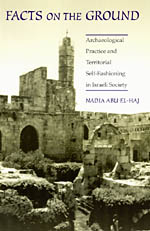 Facts on the Ground: Archaeological Practice and Territorial Self-Fashioning in Israeli Society
Nadia Abu El-Haj
University of Chicago Press, 2002 Archaeology in Israel is truly a national obsession, a practice through which national identity—and national rights—have long been asserted. But how and why did archaeology emerge as such a pervasive force there? How can the practices of archaeology help answer those questions? In this stirring book, Nadia Abu El-Haj addresses these questions and specifies for the first time the relationship between national ideology, colonial settlement, and the production of historical knowledge. She analyzes particular instances of history, artifacts, and landscapes in the making to show how archaeology helped not only to legitimize cultural and political visions but, far more powerfully, to reshape them. Moreover, she places Israeli archaeology in the context of the broader discipline to determine what unites the field across its disparate local traditions and locations.
Boldly uncovering an Israel in which science and politics are mutually constituted, this book shows the ongoing role that archaeology plays in defining the past, present, and future of Palestine and Israel.
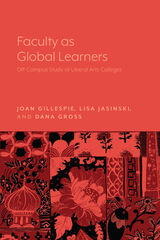 Faculty as Global Learners: Off-Campus Study at Liberal Arts Colleges
Joan Gillespie
Lever Press, 2020 This co-authored collection offers valuable insights about the impact of leading off-campus study on faculty leaders’ teaching, research, service, and overall well-being. Recognizing that faculty leaders are themselves global learners, the book addresses ways that liberal arts colleges can more effectively achieve their strategic goals for students' global learning by intentionally anticipating and supporting the needs of faculty leaders, as they grow and change. Faculty as Global Learners offers key findings and recommendations to stimulate conversations among administrators, faculty, and staff about concrete actions they can explore and steps they can take on their campuses to both support faculty leaders of off-campus programs and advance strategic institutional goals for global learning. This collection includes transferrable pedagogical insights and the perspectives of faculty members who have led off-campus study programs in a variety of disciplines and geographic regions.
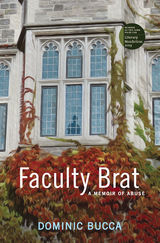 Faculty Brat: A Memoir of Abuse
Dominic Bucca
University of Iowa Press, 2020 At the most prestigious preparatory schools in the United States, the children of educators are referred to as “faculty brats.” Though generally lacking the privilege of the institution’s wealthy students, faculty brats enjoy access to the school’s extensive grounds and facilities and are part of everyday campus life. Dominic Bucca’s art teacher mother married his music teacher stepfather twice, and the young boy wondered if the union might be twice as strong as a result. Instead, this faculty brat quickly discovered that the marriage was twice as flawed. When Dominic was nine years old, his stepfather began sexually abusing him in the faculty housing attached to the boys’ dorm his parents oversaw. Years later, he found escape by reaching out to his biological father, and learned to split his life between two realities.
For nearly twenty-five years, Bucca hid the secret of his stepfather’s abuse from his mother and sisters. When he decided to tell, hoping to prevent his stepfather from continuing to teach young boys, Bucca discovered the limits of both his family and the legal system.
 Faculty of Color in the Health Professions: Stories of Survival and Success
Dena Hassouneh
Dartmouth College Press, 2017 This book provides the first in-depth examination of the experiences of a large sampling of faculty members of color in nursing, medicine, pharmacy, and dentistry schools across the United States. Anchoring her study in grounded theory, Dena Hassouneh draws on extraordinary interviews with one hundred diverse faculty members—together with rich contextual data—to illuminate the deeply entrenched cultural and institutional challenges to equity that they confront. She also presents practical strategies to overcome those challenges. The book documents the ways in which faculty members of color are excluded from full participation in their laboratory or department; yet Hassouneh’s research shows that faculty of color can survive and even thrive. The interviews and data clearly reveal both the social, educational, and departmental contexts that determine satisfaction and success in recruitment and advancement and the impact that faculty of color have had on their students, peers, patients, schools, and communities.
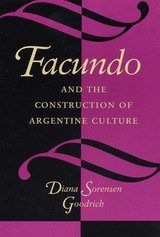 Facundo and the Construction of Argentine Culture
By Diana Sorensen Goodrich
University of Texas Press, 1996 Domingo F. Sarmiento's classic 1845 essay Facundo, Civilizacion y Barbarie opened an inquiry into the nature of Argentinian culture that continues to the present day. In this elegantly written study, Diana Sorensen Goodrich explores the varied, and often conflicting, readings that Facundo has received since its publication and shows how these readings have contributed to the making and remaking of the Argentine nation and its culture. Goodrich's analysis sheds new light on the intersection between canon formation and nation-building. While much has been written about Facundo as a primary text in Latin American letters, this is the first study that locates it within the problematics of canon formation and the cultural, social, and political contexts in which conflicting interpretations are constructed. This new approach to Facundo illuminates the interactions among institutions, cultural ideologies, and political life. This book will be important reading for everyone interested in questions of national identity and the institutionalization of a national tradition.
 Fada: Boredom and Belonging in Niger
Adeline Masquelier
University of Chicago Press, 2019 Niger most often comes into the public eye as an example of deprivation and insecurity. Urban centers have become concentrated areas of unemployment filled with young men trying, against all odds, to find jobs and fill their time with meaningful occupations. At the heart of Adeline Masquelier’s groundbreaking book is the fada—a space where men gather to escape boredom by talking, playing cards, listening to music, and drinking tea. As a place in which new forms of sociability and belonging are forged outside the unattainable arena of work, the fada has become an integral part of Niger’s urban landscape. By considering the fada as a site of experimentation, Masquelier offers a nuanced depiction of how young men in urban Niger engage in the quest for recognition and reinvent their own masculinity in the absence of conventional avenues to self-realization. In an era when fledgling and advanced economies alike are struggling to support meaningful forms of employment, this book offers a timely glimpse into how to create spaces of stability, respect, and creativity in the face of diminished opportunities and precarity.
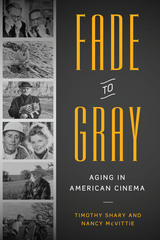 Fade to Gray: Aging in American Cinema
Timothy Shary and Nancy McVittie
University of Texas Press, 2016 Winner, Choice Outstanding Academic Title, 2017 Americans are living longer and reinventing both work and retirement, but Hollywood movies barely hint at this reality of contemporary society. In many popular films, older characters fade into irrelevance, inactivity, or absurdity, or else they stay in the background as wise elders while younger characters provide the action. Most American films do not attempt to portray the rich variety of experiences or the sensitive aging issues that people confront in the years beyond fifty. Fade to Gray offers one of the first extended studies of the portrayal of older people in American cinema from the silent era to the present. Writing in an accessible style for both general audiences and scholars, Timothy Shary and Nancy McVittie examine social attitudes toward aging through an analysis of hundreds of individual films, including such classics as You Can’t Take It With You (1938), Rosemary’s Baby (1968), Grumpy Old Men (1993), and Nebraska (2013). They show how representations of the aging process and depictions of older people embracing or enduring the various experiences of longer lives have evolved over the past century, as well as how film industry practices have both reflected and influenced perceptions of aging in American society. Exposing the social and political motivations for negative cinematic portrayals of the elderly, Fade to Gray also gives visibility to films that provide opportunities for better understanding and appreciation of the aged and the aging process.
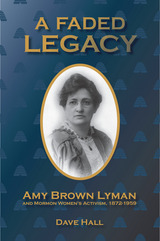 A Faded Legacy: Amy Brown Lyman and Mormon Women's Activism, 1872 - 1959
Dave Hall
University of Utah Press, 2015 To her contemporaries Amy Brown Lyman was a leader, admired for her dynamic personality, her inspiring public addresses, and especially for her remarkable vision of what Mormon women in the Relief Society could achieve. Yet today her name is barely known. This volume brings her work to light, showing how the accomplishments of Lyman and her peers benefitted their own and subsequent generations.
Placing Lyman’s story within a local and national context, award-winning author Dave Hall examines the roots and trajectory of Mormon women’s activism. Born into a polygamist family, Lyman entered the larger sphere of public life at the time when the practice of polygamy was ending and Mormonism had begun assimilating mainstream trends. The book follows her life as she prepared for a career, married, and sought meaning in a rapidly changing society. It recounts her involvement in the Relief Society, the Mormon women’s charity group that she led for many years and sought to transform into a force for social welfare, and it considers the influence of her connections with national and international women’s organizations. The final period of Lyman’s life, in which she resigned from the Relief Society amidst personal tragedy, offers insight into the reasons Mormon women abandoned their activist heritage for a more conservative role, a stance that is again evolving.
Winner of the Mormon History Association's Best First Book Award.
Fadeout: A Dave Brandstetter Mystery
Joseph Hansen
University of Wisconsin Press, 2004 Fadeout is the first of Joseph Hansen's twelve classic mysteries featuring rugged Dave Brandstetter, an insurance investigator who is contentedly gay. When entertainer Fox Olson's car plunges off a bridge in a storm, a death claim is filed, but where is Olson's body? As Brandstetter questions family, fans, and detractors, he grows certain Olson is still alive and that Dave must find him before the would-be killer does. Suspenseful and wry, shrewd and deeply felt, Fadeout remains as fresh today as when it startled readers more than thirty years ago.
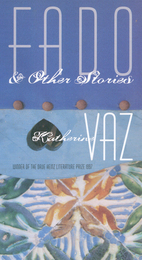 Fado and Other Stories
Katherine Vaz
University of Pittsburgh Press, 1997 Winner of the 1997 Drue Heinz Literature Prize
This collection is filled with narrative and character grounded in the meaning and value the earth gives to human existence. In one story, a woman sleeps with the village priest, trying to gain back the land the church took from her family; in another, relatives in the Azores fight over a plot of land owned by their expatriate American cousin. Even apparently small images are cast in terms of the earth: Milton, one narrator explains, has made apples the object of a misunderstanding by naming them as Eden’s fruit: “In the Bible, no fruit is named in the Garden of Eden - and to this day apples are misunderstood. They were trying to tempt people not into sin but into listening to the earth more closely. . . . their white meal runs wet with the knowledge of the language of the land, but people do not listen.”
Vaz’s beautiful, intensely conscious language often delicately slips her stories into the realm of the fado, the Portuguese song about fate and longing. “Listen for the nightingale that presses its breast against the thorns of the rose,” on character sings, “that the song might be more beautiful.” Such a verse might describe Vaz’s own motive behind her willingness to confront her subject’s ambiguities and her characters’ conflicts - the simultaneous joy and sorrow of some of life’s discoveries, the pain sometimes hidden within passion and pleasure.
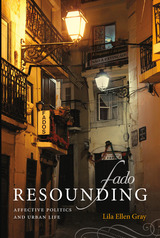 Fado Resounding: Affective Politics and Urban Life
Lila Ellen Gray
Duke University Press, 2013 Fado, Portugal's most celebrated genre of popular music, can be heard in Lisbon clubs, concert halls, tourist sites, and neighborhood bars. Fado sounds traverse the globe, on internationally marketed recordings, as the "soul" of Lisbon. A fadista might sing until her throat hurts, the voice hovering on the break of a sob; in moments of sung beauty listeners sometimes cry. Providing an ethnographic account of Lisbon's fado scene, Lila Ellen Gray draws on research conducted with amateur fado musicians, fadistas, communities of listeners, poets, fans, and cultural brokers during the first decade of the twenty-first century. She demonstrates the power of music to transform history and place into feeling in a rapidly modernizing nation on Europe's periphery, a country no longer a dictatorship or an imperial power. Gray emphasizes the power of the genre to absorb sounds, memories, histories, and styles and transform them into new narratives of meaning and "soul."
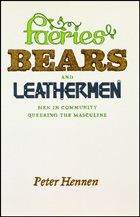 Faeries, Bears, and Leathermen: Men in Community Queering the Masculine
Peter Hennen
University of Chicago Press, 2008 Over time, male homosexuality and effeminacy have become indelibly associated, sometimes even synonymous. In Faeries, Bears, and Leathermen, Peter Hennen contends that this stigma of effeminacy exerts a powerful influence on gay subcultures. Through a comparative ethnographic analysis of three communities, Hennen explores the surprising ways that conventional masculinity is being collectively challenged, subverted, or perpetuated in contemporary gay male culture.
Hennen’s colorful study focuses on a trio of groups: the Radical Faeries, who parody effeminacy by playfully embracing it, donning prom dresses and glitter; the Bears, who strive to appear like “regular guys” and celebrate their larger, hairier bodies; and the Leathermen, who emulate hypermasculine biker culture, simultaneously paying homage to and undermining notions of manliness. Along with a historical analysis of the association between effeminacy and homosexuality, Hennen examines how this connection affects the groups’ sexual practices. Ultimately, he argues, while all three groups adopt innovative approaches to gender issues and sexual pleasure, masculine norms continue to constrain members of each community.
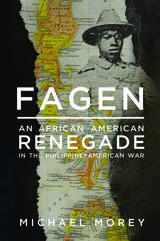 Fagen: An African American Renegade in the Philippine-American War
Michael Morey
University of Wisconsin Press, 2019 In 1898, in an era of racial terror at home and imperial conquest abroad, the United States sent its troops to suppress the Filipino struggle for independence, including three regiments of the famed African American "Buffalo Soldiers." Among them was David Fagen, a twenty-year-old private in the Twenty-Fourth Infantry, who deserted to join the Filipino guerrillas. He led daring assaults and ambushes against his former comrades and commanders—who relentlessly pursued him without success—and his name became famous in the Philippines and in the African American community.
The outlines of Fagen's legend have been known for more than a century, but the details of his military achievements, his personal history, and his ultimate fate have remained a mystery—until now. Michael Morey tracks Fagen's life from his youth in Tampa as a laborer in a phosphate camp through his troubled sixteen months in the army, and, most importantly, over his long-obscured career as a guerrilla officer. Morey places this history in its larger military, political, and social context to tell the story of the young renegade whose courage and defiance challenged the supremacist assumptions of the time.
The Failed Individual: Amid Exclusion, Resistance, and the Pleasure of Non-Conformity
Edited by Katharina Motyl and Regina Schober
Campus Verlag, 2017 The freedom of the individual to aim high is a deeply rooted part of the American ethos but we rarely acknowledge its flip side: failure. If people are responsible for their individual successes, is the same true of their failures? The Failed Individual brings together a variety of disciplinary approaches to explore how people fail in the United States and the West at large, whether economically, politically, socially, culturally, or physically. How do we understand individual failure, especially in the context of the zero-sum game of international capitalism? And what new spaces of resistance, or even pleasure, might failure open up for people and society?
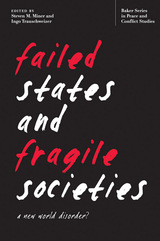 Failed States and Fragile Societies: A New World Disorder?
Ingo Trauschweizer
Ohio University Press, 2014 Since the end of the Cold War, a new dynamic has arisen within the international system, one that does not conform to established notions of the state’s monopoly on war. In this changing environment, the global community must decide how to respond to the challenges posed to the state by military threats, political and economic decline, and social fragmentation. This insightful work considers the phenomenon of state failure and asks how the international community might better detect signs of state decay at an early stage and devise legally and politically legitimate responses. This collection of essays brings military and social historians into conversation with political and social scientists and former military officers. In case studies from the former Yugoslavia, Somalia, Iraq, and Colombia, the distinguished contributors argue that early intervention to stabilize social, economic, and political systems offers the greatest promise, whereas military intervention at a later stage is both costlier and less likely to succeed. Contributors: David Carment, Yiagadeesen Samy, David Curp, Jonathan House, James Carter, Vanda Felbab-Brown, Robert Rotberg, and Ken Menkhaus.
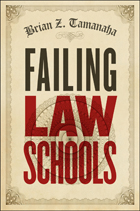 Failing Law Schools
Brian Z. Tamanaha
University of Chicago Press, 2012 On the surface, law schools today are thriving. Enrollments are on the rise, and their resources are often the envy of every other university department. Law professors are among the highest paid and play key roles as public intellectuals, advisers, and government officials. Yet behind the flourishing facade, law schools are failing abjectly. Recent front-page stories have detailed widespread dubious practices, including false reporting of LSAT and GPA scores, misleading placement reports, and the fundamental failure to prepare graduates to enter the profession. Addressing all these problems and more in a ringing critique is renowned legal scholar Brian Z. Tamanaha. Piece by piece, Tamanaha lays out the how and why of the crisis and the likely consequences if the current trend continues. The out-of-pocket cost of obtaining a law degree at many schools now approaches $200,000. The average law school graduate’s debt is around $100,000—the highest it has ever been—while the legal job market is the worst in decades, with the scarce jobs offering starting salaries well below what is needed to handle such a debt load. At the heart of the problem, Tamanaha argues, are the economic demands and competitive pressures on law schools—driven by competition over U.S. News and World Report ranking. When paired with a lack of regulatory oversight, the work environment of professors, the limited information available to prospective students, and loan-based tuition financing, the result is a system that is fundamentally unsustainable. Growing concern with the crisis in legal education has led to high-profile coverage in the Wall Street Journal and the New York Times, and many observers expect it soon will be the focus of congressional scrutiny. Bringing to the table his years of experience from within the legal academy, Tamanaha has provided the perfect resource for assessing what’s wrong with law schools and figuring out how to fix them.
Failing Peace: Gaza and the Palestinian-Israeli Conflict
Sara Roy
Pluto Press, 2006 Discussion of Israeli policy toward Palestinians is often regarded as a taboo subject, with the result that few people - especially in the US - understand the origins and consequences of the conflict. This book provides an indispensable context for understanding why the situation remains so intractable.
The book focuses on the Gaza Strip, an area that remains consistently neglected and misunderstood despite its political centrality. Drawing on more than two thousand interviews and extensive firsthand experience, Sara Roy chronicles the impact of Israeli occupation in Palestine over nearly a generation.
Exploring the devastating consequences of socio-economic and political decline, this is a unique and powerful account of the reality of life in the West Bank and Gaza. Written by one of the world's foremost scholars of the region, it offers an unrivalled breadth of scholarship and insight.
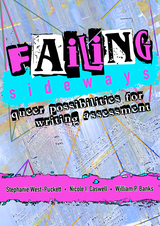 Failing Sideways: Queer Possibilities for Writing Assessment
Stephanie West-Puckett
Utah State University Press, 2023 Failing Sideways is an innovative and fresh approach to assessment that intersects writing studies, educational measurement, and queer rhetorics. While valuing and representing the research, theory, and practice of assessment, authors Stephanie West-Puckett, Nicole I. Caswell, and William P. Banks demonstrate the ways that students, teachers, and other interested parties can find joy and justice in the work of assessment.
A failure-oriented assessment model unsettles some of the most common practices, like rubrics and portfolios, and challenges many deeply held assumptions about validity and reliability in order to ask what could happen if assessment was oriented toward possibility and potential. Working to engage a more capacious writing construct, the authors propose queer validity inquiry (QVI) as a model for assessment that values failure, affect, identity, and materiality. These overlapping lenses help teachers honor parts of writing and learning that writing studies faculty have struggled to hold onto in a world overly focused on quickness and efficiency in schools.
Through programmatic and classroom examples, Failing Sideways privileges what is valued in the classroom but traditionally ignored in assessments. Reimagining what matters in the teaching and learning of writing and using assessment data differently, this book demonstrates what writing can be and could do in a more diverse and just world.
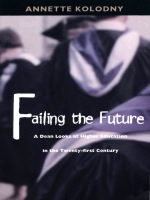 Failing the Future: A Dean Looks at Higher Education in the Twenty-first Century
Annette Kolodny
Duke University Press, 1998 Both revealing and compelling, Annette Kolodny’s Failing the Future: A Dean Looks at Higher Education in the Twenty-first Century is drawn from the author’s experience as a distinguished teacher, a prize-winning scholar of American literature, a feminist thinker, and an innovative administrator at a major public university. In chapters that range from the changing structure of the American family and its impact on both curriculum and university benefits policies to recommendations for overhauling the culture of decision making on campus, this former Dean of the College of Humanities at the University of Arizona explores the present state of higher education and offers a sobering view of what lies ahead.
In this volume Kolodny explains the reasons for the financial crisis in higher education today and boldly addresses the challenges that remain ignored, including rising birthrates, changing demographics both on campus and across the country, the accelerating globalization of higher education and advanced research, and the necessity for greater interdisciplinarity in undergraduate education. Moreover, while sensitive to the complex burdens placed on faculty today, Kolodny nonetheless reveals how the professoriate has allowed itself to become vulnerable to public misperceptions and to lampooning by the media.
Not simply a book about current problems and future challenges, Failing the Future is rich with practical solutions and workable programs for change. Among her many insights, Kolodny offers a thorough defense of the role of tenure and outlines a new set of procedures to ensure its effective implementation; she proposes a structure for an “Antifeminist Intellectual Harassment Policy”; and she provides a checklist of family-sensitive policies universities can offer their staff, faculty, and administrators. Kolodny calls on union leaders, campus communities, policymakers, and the general public to work together in unprecedented partnerships. Her goal, as she states in a closing coda, is to initiate a revitalized conversation about public education.
This book should be required reading for all those concerned with the future of higher education in this country—from college trustees to graduate students entering the professoriate, from faculty to university administrators, from officers of campus-based unions to education policymakers.
 Failing to Win: Perceptions of Victory and Defeat in International Politics
Dominic D. P. Johnson and Dominic Tierney
Harvard University Press, 2006 How do people decide which country came out ahead in a war or a crisis? Why, for instance, was the Mayaguez Incident in May 1975--where 41 U.S. soldiers were killed and dozens more wounded in a botched hostage rescue mission--perceived as a triumph and the 1992-94 U.S. humanitarian intervention in Somalia, which saved thousands of lives, viewed as a disaster? In Failing to Win, Dominic Johnson and Dominic Tierney dissect the psychological factors that predispose leaders, media, and the public to perceive outcomes as victories or defeats--often creating wide gaps between perceptions and reality.
To make their case, Johnson and Tierney employ two frameworks: "Scorekeeping," which focuses on actual material gains and losses; and "Match-fixing," where evaluations become skewed by mindsets, symbolic events, and media and elite spin. In case studies ranging from the 1962 Cuban Missile Crisis and the current War on Terror, the authors show that much of what we accept about international politics and world history is not what it seems--and why, in a time when citizens offer or withdraw support based on an imagined view of the outcome rather than the result on the ground, perceptions of success or failure can shape the results of wars, the fate of leaders, and the "lessons" we draw from history.
 Failure by Design: The California Energy Crisis and the Limits of Market Planning
Georg Rilinger
University of Chicago Press, 2024 A new framework for studying markets as the product of organizational planning and understanding the practical limits of market design.
The Western energy crisis was one of the great financial disasters of the past century. The crisis began in April 2000, when price spikes started to rattle California’s electricity markets. Decades later, some blame economic fundamentals and ignorant politicians, while others accuse the energy sellers who raided the markets. In Failure by Design, sociologist Georg Rilinger offers a different explanation, one that focuses on the practical challenges of market design. The unique physical attributes of electricity made it exceedingly difficult to introduce markets into the coordination of the electricity system, so market designers were brought in to construct the infrastructures that coordinate how market participants interact. An exercise in social engineering, these infrastructures were intended to guide market actors toward behavior that would produce optimal market results and facilitate grid management. Yet, though these experts spent their days worrying about incentive misalignment and market manipulation, they unintentionally created a system riddled with opportunities for destructive behavior. Rilinger’s analysis not only illuminates the California energy crisis but also develops a broader theoretical framework for thinking about markets as the products of organizational planning and the limits of social engineering, contributing broadly to sociological and economic thinking about the nature of markets.
 Failure by Design: The California Energy Crisis and the Limits of Market Planning
Georg Rilinger
University of Chicago Press, 2024 This is an auto-narrated audiobook version of this book.
A new framework for studying markets as the product of organizational planning and understanding the practical limits of market design.
The Western energy crisis was one of the great financial disasters of the past century. The crisis began in April 2000, when price spikes started to rattle California’s electricity markets. Decades later, some blame economic fundamentals and ignorant politicians, while others accuse the energy sellers who raided the markets. In Failure by Design, sociologist Georg Rilinger offers a different explanation, one that focuses on the practical challenges of market design. The unique physical attributes of electricity made it exceedingly difficult to introduce markets into the coordination of the electricity system, so market designers were brought in to construct the infrastructures that coordinate how market participants interact. An exercise in social engineering, these infrastructures were intended to guide market actors toward behavior that would produce optimal market results and facilitate grid management. Yet, though these experts spent their days worrying about incentive misalignment and market manipulation, they unintentionally created a system riddled with opportunities for destructive behavior. Rilinger’s analysis not only illuminates the California energy crisis but also develops a broader theoretical framework for thinking about markets as the products of organizational planning and the limits of social engineering, contributing broadly to sociological and economic thinking about the nature of markets.
 A Failure of Capitalism: The Crisis of ’08 and the Descent into Depression
Richard A. Posner
Harvard University Press, 2009 The financial and economic crisis that began in 2008 is the most alarming of our lifetime because of the warp-speed at which it is occurring. How could it have happened, especially after all that we’ve learned from the Great Depression? Why wasn’t it anticipated so that remedial steps could be taken to avoid or mitigate it? What can be done to reverse a slide into a full-blown depression? Why have the responses to date of the government and the economics profession been so lackluster? Richard Posner presents a concise and non-technical examination of this mother of all financial disasters and of the, as yet, stumbling efforts to cope with it. No previous acquaintance on the part of the reader with macroeconomics or the theory of finance is presupposed. This is a book for intelligent generalists that will interest specialists as well.
Among the facts and causes Posner identifies are: excess savings flowing in from Asia and the reckless lowering of interest rates by the Federal Reserve Board; the relation between executive compensation, short-term profit goals, and risky lending; the housing bubble fuelled by low interest rates, aggressive mortgage marketing, and loose regulations; the low savings rate of American people; and the highly leveraged balance sheets of large financial institutions.
Posner analyzes the two basic remedial approaches to the crisis, which correspond to the two theories of the cause of the Great Depression: the monetarist—that the Federal Reserve Board allowed the money supply to shrink, thus failing to prevent a disastrous deflation—and the Keynesian—that the depression was the product of a credit binge in the 1920s, a stock-market crash, and the ensuing downward spiral in economic activity. Posner concludes that the pendulum swung too far and that our financial markets need to be more heavily regulated.
 The Failure of Capitalist Production: Underlying Causes of the Great Recession
Andrew Kliman
Pluto Press, 2011 The recent financial crisis and Great Recession have been analysed endlessly in the mainstream and academia, but this is the first book to conclude, on the basis of in-depth analyses of official US data, that Marx’s crisis theory can explain these events.
Marx believed that the rate of profit has a tendency to fall, leading to economic crises and recessions. Many economists, Marxists among them, have dismissed this theory out of hand, but Andrew Kliman’s careful data analysis shows that the rate of profit did indeed decline after the post-World War II boom and that free-market policies failed to reverse the decline. The fall in profitability led to sluggish investment and economic growth, mounting debt problems, desperate attempts of governments to fight these problems by piling up even more debt – and ultimately to the Great Recession.
Kliman's conclusion is simple but shocking: short of socialist transformation, the only way to escape the ‘new normal’ of a stagnant, crisis-prone economy is to restore profitability through full-scale destruction of existing wealth, something not seen since the Depression of the 1930s.
 Failure of Constitutional Emergency Powers under the German Republic
Frederick M. Watkins
Harvard University Press From ancient Rome down to the present, most constitutional states have considered it wise to provide some regular means for the suspension of normal commercial procedure in the face of temporary crises. The significance of this aspect of constitutional government is shown with particular clearness in the case of the German Republic. For the nearly fifteen years that the Weimar Constitution remained in effective operation, there was a sincere and generally successful effort to govern the Reich in accordance with liberal democratic principles; but at the same time, Germany was even more seriously subject than most constitutional countries to the strains and stresses of post-war readjustment. Nowhere was the need for emergency action more obvious, and nowhere were the means more readily available for the satisfaction of that need. To analyze and describe this particular aspect of German experience is the purpose of Mr. Watkins's study. It is an outstanding contribution to the history of modern Germany, and at the same time it provides a warning example for other countries.
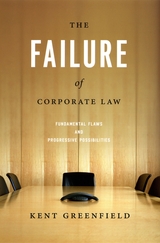 The Failure of Corporate Law: Fundamental Flaws and Progressive Possibilities
Kent Greenfield
University of Chicago Press, 2007 When used in conjunction with corporations, the term “public” is misleading. Anyone can purchase shares of stock, but public corporations themselves are uninhibited by a sense of societal obligation or strict public oversight. In fact, managers of most large firms are prohibited by law from taking into account the interests of the public in decision making, if doing so hurts shareholders. But this has not always been the case, as until the beginning of the twentieth century, public corporations were deemed to have important civic responsibilities.
With The Failure of Corporate Law, Kent Greenfield hopes to return corporate law to a system in which the public has a greater say in how firms are governed. Greenfield maintains that the laws controlling firms should be much more protective of the public interest and of the corporation’s various stakeholders, such as employees. Only when the law of corporations is evaluated as a branch of public law—as with constitutional law or environmental law—will it be clear what types of changes can be made in corporate governance to improve the common good. Greenfield proposes changes in corporate governance that would enable corporations to meet the progressive goal of creating wealth for society as a whole rather than merely for shareholders and executives.
The Failure of Latin America: Postcolonialism in Bad Times
John Beverley
University of Pittsburgh Press, 2019 The Failure of Latin Americais a collection of John Beverley’s previously published essays and pairs them with new material that reflects on questions of postcolonialism and equality within the context of receding continental socialism. Beverley sees an impasse within both the academic postcolonial project and the Bolivarian idea of Latin America. The Pink Tide may have failed to permanently reshape Latin America, but in its failure there remains the possibility of an alternative modernity not bound to global capitalism. Beverley proposes that equality, modified by the postcolonial legacy, is a particularly Latin American possibility that can break the impasse and redefine Latinamericanism.
 The Failure of National Rural Policy: Institutions and Interests
William P. Browne
Georgetown University Press, 2001 Modern farm policy emerged in the United States in 1862, leading to an industrialized agriculture that made the farm sector collectively more successful even as many individual farmers failed. Ever since, a healthy farm economy has been seen as the key to flourishing rural communities, and the problems of rural nonfarmers, former farmers, nonfarm residents, and unfarmed regions were ignored by policymakers. In The Failure of National Rural Policy, William P. Browne blends history, politics, and economics to show that federal government emphasis on farm productivity has failed to meet broader rural needs and actually has increased rural poverty. He explains how strong public institutions, which developed agrarianism, led to narrowed concepts of the public interest. Reviewing past efforts to expand farm policy benefits to other rural residents, Browne documents the fragmentation of farm policy within the agricultural establishment as farm services grew, the evolution of political turf protection, and the resultant difficulties of rural advocacy. Arguing for an integrated theory of governing institutions and related political interests, he maintains that nonfarm rural society can make a realistic claim for public policy assistance. Written informally, each chapter is followed by comments on the implications of its topics and summaries of key points. The book will serve as a stimulating text for students of public policy, national affairs, rural sociology, and community development—as well as anyone concerned with the future of agrarian America.
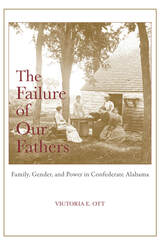 The Failure of Our Fathers: Family, Gender, and Power in Confederate Alabama
Victoria E. Ott
University of Alabama Press, 2023 An in-depth study of non-elite white families in Alabama—from the state’s creation through the end of the Civil War
The Failure of Our Fathers: Family, Gender, and Power in Confederate Alabama examines the evolving position of non-elite white families in Alabama during one of the most pivotal epochs in the state’s history. Drawing on a wide range of personal and public documents reflecting the state’s varied regions and economies, Victoria E. Ott uses gender and family as a lens to examine the yeomanry and poor whites, a constituency that she collectively defines as “common whites,” who identified with the Confederate cause.
Ott provides a nuanced examination of how these Alabamians fit within the antebellum era’s paternalistic social order, eventually identifying with and supporting the Confederate mission to leave the Union and create an independent, slaveholding state. But as the reality of the war slowly set in and the Confederacy began to fray, the increasing dangers families faced led Alabama’s common white men and women to find new avenues to power as a distinct socioeconomic class.
Ott argues that family provided the conceptual framework necessary to understand why common whites supported a war to protect slavery despite having little or no investment in the institution. Going to war meant protecting their families from outsiders who threatened to turn their worlds upside down. Despite class differences, common whites envisioned the Confederacy as a larger family and the state as paternal figures who promised to protect its loyal dependents throughout the conflict. Yet, as the war ravaged many Alabama communities, devotion to the Confederacy seemed less a priority as families faced continued separations, threats of death, and the potential for starvation. The construct of a familial structure that once created a sense of loyalty to the Confederacy now gave them cause to question its leadership. Ott shows how these domestic values rooted in highly gendered concepts ultimately redefined Alabama’s social structure and increased class distinctions after the war.
The Failure of Political Islam
Olivier Roy
Harvard University Press, 1998 Olivier Roy demonstrates that the Islamic Fundamentalism of today is still the Third Worldism of the 1960s: populist politics and mixed economies of laissez-faire for the rich and subsidies for the poor. In Roy’s striking formulation, those marching today beneath Islam’s green banners are the same as the “reds” of yesterday, with similarly dim prospects of success. Richly informed, powerfully argued, and clearly written, this is a book that no one trying to understand Islam can afford to overlook.
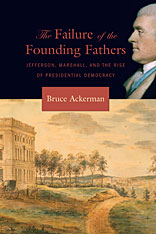 The Failure of the Founding Fathers: Jefferson, Marshall, and the Rise of Presidential Democracy
Bruce Ackerman
Harvard University Press, 2005 The ink was barely dry on the Constitution when it was almost destroyed by the rise of political parties in the United States. As Bruce Ackerman shows, the Framers had not anticipated the two-party system, and when Republicans battled Federalists for the presidency in 1800, the rules laid down by the Constitution exacerbated the crisis. With Republican militias preparing to march on Washington, the House of Representatives deadlocked between Thomas Jefferson and Aaron Burr. Based on seven years of archival research, the book describes previously unknown aspects of the electoral college crisis. Ackerman shows how Thomas Jefferson counted his Federalist rivals out of the House runoff, and how the Federalists threatened to place John Marshall in the presidential chair. Nevertheless, the Constitution managed to survive through acts of statesmanship and luck.
Despite the intentions of the Framers, the presidency had become a plebiscitarian office. Thomas Jefferson gained office as the People's choice and acted vigorously to fulfill his popular mandate. This transformation of the presidency serves as the basis for a new look at Marbury v. Madison, the case that first asserted the Supreme Court's power of judicial review. Ackerman shows that Marbury is best seen in combination with another case, Stuart v. Laird, as part of a retreat by the Court in the face of the plebiscitarian presidency. This "switch in time" proved crucial to the Court's survival, allowing it to integrate Federalist and Republican themes into the living Constitution of the early republic.
Ackerman presents a revised understanding of the early days of two great institutions that continue to have a major impact on American history: the plebiscitarian presidency and a Supreme Court that struggles to put the presidency's claims of a popular mandate into constitutional perspective.
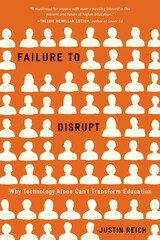 Failure to Disrupt: Why Technology Alone Can’t Transform Education
Justin Reich
Harvard University Press, 2020 A Science “Reading List for Uncertain Times” Selection
“A must-read for anyone with even a passing interest in the present and future of higher education.”
—Tressie McMillan Cottom, author of Lower Ed
“A must-read for the education-invested as well as the education-interested.”
—Forbes
Proponents of massive online learning have promised that technology will radically accelerate learning and democratize education. Much-publicized experiments, often underwritten by Silicon Valley entrepreneurs, have been launched at elite universities and elementary schools in the poorest neighborhoods. But a decade after the “year of the MOOC,” the promise of disruption seems premature.
In Failure to Disrupt, Justin Reich takes us on a tour of MOOCs, autograders, “intelligent tutors,” and other edtech platforms and delivers a sobering report card. Institutions and investors favor programs that scale up quickly at the expense of true innovation. Learning technologies—even those that are free—do little to combat the growing inequality in education. Technology is a phenomenal tool in the right hands, but no killer app will shortcut the hard road of institutional change.
“I’m not sure if Reich is as famous outside of learning science and online education circles as he is inside. He should be…Reading and talking about Failure to Disrupt should be a prerequisite for any big institutional learning technology initiatives coming out of COVID-19.”
—Inside Higher Ed
“The desire to educate students well using online tools and platforms is more pressing than ever. But as Justin Reich illustrates…many recent technologies that were expected to radically change schooling have instead been used in ways that perpetuate existing systems and their attendant inequalities.”
—Science
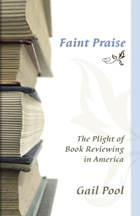 Faint Praise: The Plight of Book Reviewing in America
Gail Pool
University of Missouri Press, 2007
For more than two hundred years, book reviewers have influenced American readers, setting our literary agenda by helping us determine not only what we read but also what we think about what we read. And for nearly as long, critics of these critics have lambasted book reviews for their overpraise, hostility, banality, and bias.
Faint Praise takes a hard and long-overdue look at the institution of book reviewing. Gail Pool, herself an accomplished reviewer and review editor, analyzes the inner workings of this troubled trade to show how it works—and why it so often fails to work well. She reveals why bad reviewing happens despite good intentions and how it is that so many intelligent people who love books can say so many unintelligent things on their behalf.
Reviewers have the power to award prestige to authors, give prominence to topics, and shape opinion and taste; yet most readers have little knowledge of why certain books are selected for review, why certain reviewers are selected to review them, and why they so often praise books that aren’t all that good. Pool takes readers behind the scenes to describe how editors choose books for review and assign them to reviewers, and she examines the additional roles played by publishers, authors, and readers. In describing the context of reviewing, she reveals a culture with little interest in literature, much antipathy to criticism, and a decided weakness for praise. In dissecting the language of reviews, Pool demonstrates how it often boils down to unbelievable hype.
Pool explores the multifaceted world of book reviewing today, contrasting traditional methods of reviewing with alternative book coverage, from Amazon.com to Oprah, and suggesting how the more established practices could be revised. She also explores the divide between service journalism practiced by reviewers versus the alleged high art served up by literary critics—and what this fuzzy boundary between reviewing and criticism really means.
This is the first book to analyze the field in depth, weighing the inherent difficulties of reviewing against the unacceptable practices that undermine the very reasons we read—and need—reviews. Faint Praise is a book not just for those who create and review books but also for everyone who loves books. By demystifying this hidden process, Pool helps everyone understand how to read reviews—and better decide what to read.
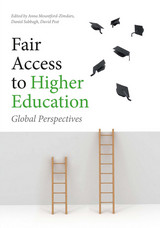 Fair Access to Higher Education: Global Perspectives
Edited by Anna Mountford-Zimdars, Daniel Sabbagh, and David Post
University of Chicago Press, 2014 What does “fairness” mean internationally in terms of access to higher education? Increased competition for places in elite universities has prompted a worldwide discussion regarding the fairness of student admission policies. Despite budget cuts from governments—and increasing costs for students—competition is fierce at the most prestigious institutions. Universities, already under stress, face a challenge in balancing institutional research goals, meeting individual aspirations for upward social mobility, and promoting the democratic ideal of equal opportunity.
Fair Access to Higher Education addresses this challenge from a broad, transnational perspective. The chapters in this volume contribute to our thinking and reflection on policy developments and also offer new empirical findings about patterns of advantage and disadvantage in higher education access. Bringing together insights drawn from a variety of fields, including philosophy, linguistics, social psychology, sociology, and public policy, the book sheds light on how “fairness” in university admissions has been articulated worldwide.
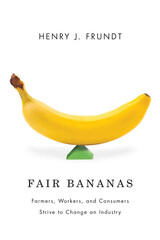 Fair Bananas!: Farmers, Workers, and Consumers Strive to Change an Industry
Henry J. Frundt
University of Arizona Press, 2009 Bananas are the most-consumed fruit in the world. In the United States alone, the public eats about twenty-eight pounds of bananas per person every year. The total value of the international banana trade is nearly five billion dollars annually, with 80 percent of all exported bananas originating in Latin America. There are as many as ten million people involved in growing, packing, and shipping bananas, but American consumers have only recently begun to think about them and about their working conditions. Although European nations have helped create a “fair trade” system for bananas grown in Mediterranean and Caribbean regions, the United States as a country has not developed a similar system for bananas grown in Latin America, where large corporations have dominated trade for more than a century.
Fair Bananas! is one of the first books to examine the issue of “fair-trade bananas.” Specifically, Henry Frundt analyzes whether a farmer-worker-consumer alliance can collaborate to promote a fair-trade label for bananas—much like those for fair-trade coffee and chocolate—that will appeal to North American shoppers. Researching the issue for more than ten years, Henry Frundt has elicited surprising and nuanced insights from banana workers, Latin American labor officials, company representatives, and fair-trade advocates.
Frundt writes with admirable clarity throughout the book, which he has designed for college students who are being introduced to the subject of international trade and for consumers who are interested in issues of development. Frankly, though, Fair Bananas! will appeal to anyone who wants to know more about bananas, including where they come from and how they get from there to here.
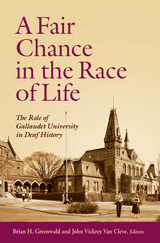 A Fair Chance in the Race of Life: The Role of Gallaudet University in Deaf History
Brian H. Greenwald
Gallaudet University Press, 2008 Despite its prominence as a world cultural center and a locus of research on deaf culture, history, education, and language for more than 150 years, Gallaudet University has only infrequently been the focal point of historical study. Eminent historians Brian H. Greenwald and John Vickrey Van Cleve have remedied this scarcity with A Fair Chance in the Race of Life: The Role of Gallaudet University in Deaf History. In this collection, a remarkable cast of scholars examine the university and its various roles through time, many conducting new research in the Gallaudet University Archives, an unsurpassed repository of primary sources of deaf history.
Pulitzer-Prize-winning historian James M. McPherson sets the stage in his essay “A Fair Chance in the Race of Life,” President Abraham Lincoln’s statement when he chartered the first college for deaf students. The papers that follow scrutinize Gallaudet’s long domination by hearing presidents, its struggle to find a place within higher education, its easy acquiescence to racism, its relationship with the federal government, and its role in creating, shaping, and nurturing the deaf community.
These studies do more than simply illuminate the university, however. They also confront broad issues that deal with the struggles of social conformity versus cultural distinctiveness, minority cohesiveness, and gender discrimination. “Deaf” themes, such as the role of English in deaf education, audism, and the paternalism of hearing educators receive analysis as well.
Fair Copy
Rebecca Hazelton
Ohio State University Press, 2012 Fair Copy, byRebecca Hazelton, is a meditation on the difficulties of distinguishing the real from the false, the copy from the original. It is in part an exploration of the disparity between our conception of love as either true or false and the messy reality that it can sometimes be both. If “true” love is not to be found, is an approximation a “fair” substitute? These poems repeatedly question the veracity of memory—sometimes toying with the seductiveness of nostalgia while at other times pleading for the real story. Here, the fairy tale and the everyday nervously coexist, the bride is an uneasy molecule, and happiness comes in the form of a pill. Composed of acrostics from lines by Emily Dickinson, the collection retains a direct and recurrent tie to Dickinson’s work, even while Hazelton deftly branches off into new sonic, rhythmic, and conceptual territories.
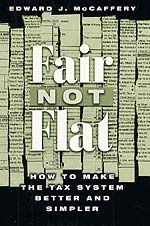 Fair Not Flat: How to Make the Tax System Better and Simpler
Edward J. McCaffery
University of Chicago Press, 2002 Everyone knows that the current tax system is unfair. Some of the richest people in America pay no tax, while a huge share of the tax burden falls on the rest of us. A mere glance at the tax code confirms that it is far too complex, with volumes of rules that no ordinary person could possibly comprehend. What is to be done? Some conservatives have called for a so-called flat tax. But a flat tax is not necessarily a simple tax, and "flat" means "more" for most taxpayers: a rise in middle-class taxes to finance tax cuts for the rich. Is there another choice?
In clear, easy-to-understand language, Edward J. McCaffery proposes a straightforward and fair alternative. A "fair not flat" tax that is consistent and progressive would tax spending, not income and savings. And if it were collected at its lower levels through a national sales tax, most people would not have to file a return. A supplemental tax on spending for the wealthiest individuals would make the national sales tax progressive. Under McCaffery's system, a family of four would pay no tax on their first $20,000 in spending, and 15 percent on the next $60,000. Only the few families who spend more than $80,000 a year would be subject to the supplemental tax. Necessities would be taxed less than ordinary and luxury items. No one would be taxed directly on savings. The estate and gift or so-called death tax would be abolished, for the simple reason that dead people don't spend. The "fair not flat" tax would fall on heirs when and as they spend their good fortune. Perhaps best of all, most Americans would not have to fill out tax returns.
Simpler, more efficient, fairer, and more reflective of America's current social values, McCaffery's "fair not flat" tax could help get us out of the tax mess that politicians and special interests have gotten us into, improving the whole country in the process. Read Fair Not Flat to find out how.
“In Fair Not Flat, Mr. McCaffery lays out the case for a consumption tax. He does so in a reader-friendly way, presenting his argument with very few footnotes, equations or technical terms. The consumption of the book, so to speak, is not at all taxing. And its argument is well worth pondering.”—Bruce Bartlett, Wall Street Journal
Fair Rosamond: A Study of the Development of a Literary Theme
Virgil B. Heltzel
Northwestern University Press, 1947 In Fair Rosamond Virgil B. Heltzel traces the character of Rosamond Clifford, known as “Fair Rosamond”—which has its origins as a theme in medieval literature—through its use in poetry and plays and novels, from the Renaissance through the early twentieth century. Heltzel’s book retains its importance today for scholars tracing certain thematic structures through all periods of literature.
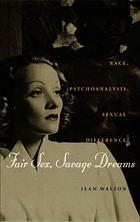 Fair Sex, Savage Dreams: Race, Psychoanalysis, Sexual Difference
Jean Walton
Duke University Press, 2001 In Fair Sex, Savage Dreams Jean Walton examines the work of early feminist psychoanalytic writing to decipher in it the unacknowledged yet foundational role of race. Focusing on the 1920s and 1930s, a time when white women were actively refashioning Freud’s problematic accounts of sexual subjectivity, Walton rereads in particular the writing of British analysts Joan Riviere and Melanie Klein, modernist poet H.D., the eccentric French analyst Marie Bonaparte, and anthropologist Margaret Mead.
Charting the fantasies of racial difference in these women’s writings, Walton establishes that race—particularly during this period—was inseparable from accounts of gender and sexuality. While arguing that these women remained notably oblivious to the racial meanings embedded in their own attempts to rearticulate feminine sexuality, Walton uses these very blindspots to understand how race and sex are deeply imbricated in the constitution of subjectivity. Challenging the notion that subjects acquire gender identities in isolation from racial ones, she thus demonstrates how white-centered psychoanalytic theories have formed the basis for more contemporary feminist and queer explorations of fantasy, desire, power, and subjectivity.
Fair Sex, Savage Dreams will appeal to scholars of psychoanalysis, literary and cinematic modernism, race studies, queer theory, feminist theory, and anthropology.
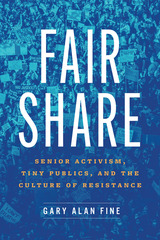 Fair Share: Senior Activism, Tiny Publics, and the Culture of Resistance
Gary Alan Fine
University of Chicago Press, 2023 A deeply researched ethnographic portrait of progressive senior activists in Chicago who demonstrate how a tiny public wields collective power to advocate for broad social change.
If you've ever been to a protest or been involved in a movement for social change, you have likely experienced a local culture, one with slogans, jargon, and shared commitments. Though one might think of a cohort of youthful organizers when imagining protest culture, this powerful ethnography from esteemed sociologist Gary Alan Fine explores the world of senior citizens on the front lines of progressive protests. While seniors are a notoriously important—and historically conservative—political cohort, the group Fine calls “Chicago Seniors Together” is a decidedly leftist organization, inspired by the model of Saul Alinsky. The group advocates for social issues, such as affordable housing and healthcare, that affect all sectors of society but take on a particular urgency in the lives of seniors. Seniors connect and mobilize around their distinct experiences but do so in service of concerns that extend beyond themselves. Not only do these seniors experience social issues as seniors—but they use their age as a dramatic visual in advocating for political change.
In Fair Share, Fine brings readers into the vital world of an overlooked political group, describing how a “tiny public” mobilizes its demands for broad social change. In investigating this process, he shows that senior citizen activists are particularly savvy about using age to their advantage in social movements. After all, what could be more attention-grabbing than a group of passionate older people determinedly shuffling through snowy streets with canes, in wheelchairs, and holding walkers to demand healthcare equity, risking their own health in the process?
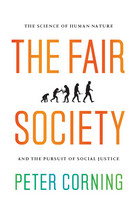 The Fair Society: The Science of Human Nature and the Pursuit of Social Justice
Peter Corning
University of Chicago Press, 2011 We’ve been told, again and again, that life is unfair. But what if we’re wrong simply to resign ourselves to this situation? What if we have the power—and more, the duty—to change society for the better?
We do. And our very nature inclines us to do so. That’s the provocative argument Peter Corning makes in The Fair Society. Drawing on the evidence from our evolutionary history and the emergent science of human nature, Corning shows that we have an innate sense of fairness. While these impulses can easily be subverted by greed and demagoguery, they can also be harnessed for good. Corning brings together the latest findings from the behavioral and biological sciences to help us understand how to move beyond the Madoffs and Enrons in our midst in order to lay the foundation for a new social contract—a Biosocial Contract built on a deep understanding of human nature and a commitment to fairness. He then proposes a sweeping set of economic and political reforms based on three principles of fairness—equality, equity, and reciprocity—that together could transform our society and our world.
At this crisis point for capitalism, Corning reveals that the proper response to bank bailouts and financial chicanery isn’t to get mad—it’s to get fair.
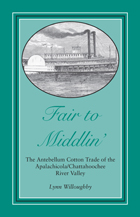 Fair to Middlin': The Antebellum Cotton Trade of the Apalachicola/Chattahoochee River Valley
Lynn Willoughby
University of Alabama Press, 2009 Explores the livelihood of the regional antebellum economy surrounding the Apalachicola/Chattahoochee River valley and the resulting global impact of this industry
This study focuses on the port of Apalachicola, Florida and the business men who lived the trade, flourishing amongst the poor conditions of transportation, communication, money, and banking. Cotton businessmen located along the waterway and on the coast neatly divided the labour necessary to market the region's major source of income.
Early regional economics revolved around and grew from the rivers that served as the primary form of transportation, and each patchwork of economy in the antebellum South relied on a different river system and its major transportation artery. Few people truly understand and realize how important cotton was to the world's economy, and no other American export came close to the importance of cotton. This power and success allowed the South to function self-sufficiently, eliminating the need to rely on other regions for goods. It was not until the introduction of the railroad system that these individual river economies blurred and faded into one another, gradually uniting to one integrated national economy.
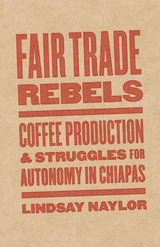 Fair Trade Rebels: Coffee Production and Struggles for Autonomy in Chiapas
Lindsay Naylor
University of Minnesota Press, 2019 Reassessing interpretations of development with a new approach to fair trade
Is fair trade really fair? Who is it for, and who gets to decide? Fair Trade Rebels addresses such questions in a new way by shifting the focus from the abstract concept of fair trade—and whether it is “working”—to the perspectives of small farmers. It examines the everyday experiences of resistance and agricultural practice among the campesinos/as of Chiapas, Mexico, who struggle for dignified livelihoods in self-declared autonomous communities in the highlands, confronting inequalities locally in what is really a global corporate agricultural chain.
Based on extensive fieldwork, Fair Trade Rebels draws on stories from Chiapas that have emerged from the farmers’ interaction with both the fair-trade–certified marketplace and state violence. Here Lindsay Naylor discusses the racialized and historical backdrop of coffee production and rebel autonomy in the highlands, underscores the divergence of movements for fairer trade and the so-called alternative certified market, traces the network of such movements from the highlands and into the United States, and evaluates existing food sovereignty and diverse economic exchanges. Putting decolonial thinking in conversation with diverse economies theory, Fair Trade Rebels evaluates fair trade not by the measure of its success or failure but through a unique, place-based approach that expands our understanding of the relationship between fair trade, autonomy, and economic development.
 The Fair Trade Revolution
Edited by John Bowes
Pluto Press, 2011 Fair Trade has come a long way in the last 20 years. The Fair Trade Revolution celebrates the movement's achievement and takes up the challenge of improving more lives through fair dealing with producers. Fair Trade is now mainstream, with large companies like Cadbury's and supermarkets such as Sainsbury's producing and stocking many Fair Trade products. The authors of this collection, many of whom were responsible for the initial success of Fair Trade, emphasise the importance of ensuring that farmers and other producers remain the main beneficiaries. Punchy chapters, illustrated with many real-world examples, cover all the important issues including the tensions between large and small operators, the impact of recession, environmental policy and the danger of large operators embracing Fair Trade more in word than in practice. Written by the leading lights of the Fair Trade movement, including Harriet Lamb (Executive Director of the Fairtrade Foundation) and Bruce Crowther (Establisher of the world's first Fair Trade Town) this book will inspire activists and consumers to keep making the right choices.
 The Fair Trade Scandal: Marketing Poverty to Benefit the Rich
Ndongo Sylla
Ohio University Press This critical account of the fair trade movement explores the vast gap between the rhetoric of fair trade and its practical results for poor countries, particularly those of Africa. In the Global North, fair trade often is described as a revolutionary tool for transforming the lives of millions across the globe. The growth in sales for fair trade products has been dramatic in recent years, but most of the benefit has accrued to the already wealthy merchandisers at the top of the value chain rather than to the poor producers at the bottom.
Ndongo Sylla has worked for Fairtrade International and offers an insider’s view of how fair trade improves?—?or doesn’t?—?the lot of the world’s poorest. His methodological framework first describes the hypotheses on which the fair trade movement is grounded before going on to examine critically the claims made by its proponents. By distinguishing local impact from global impact, Sylla exposes the inequity built into the system and the resulting misallocation of the fair trade premium paid by consumers.
The Fair Trade Scandal is an empirically based critique of both fair trade and traditional free trade; it is the more important for exploring the problems of both from the perspective of the peoples of the Global South, the ostensible beneficiaries of the fair trade system.
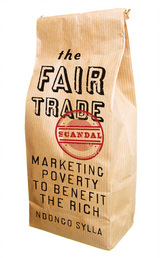 The Fair Trade Scandal: Marketing Poverty to Benefit the Rich
Ndongo Sylla
Ohio University Press, 2014 This critical account of the fair trade movement explores the vast gap between the rhetoric of fair trade and its practical results for poor countries, particularly those of Africa. In the Global North, fair trade often is described as a revolutionary tool for transforming the lives of millions across the globe. The growth in sales for fair trade products has been dramatic in recent years, but most of the benefit has accrued to the already wealthy merchandisers at the top of the value chain rather than to the poor producers at the bottom.
Ndongo Sylla has worked for Fairtrade International and offers an insider’s view of how fair trade improves—or doesn’t—the lot of the world’s poorest. His methodological framework first describes the hypotheses on which the fair trade movement is grounded before going on to examine critically the claims made by its proponents. By distinguishing local impact from global impact, Sylla exposes the inequity built into the system and the resulting misallocation of the fair trade premium paid by consumers. The Fair Trade Scandal is an empirically based critique of both fair trade and traditional free trade; it is the more important for exploring the problems of both from the perspective of the peoples of the Global South, the ostensible beneficiaries of the fair trade system.
The Fair Trade Scandal: Marketing Poverty to Benefit the Rich
Ndongo Samba Sylla
Pluto Press, 2014 The Fair Trade Scandal takes aim at the Fair Trade consumer movement which many assume to be entirely benign. Through a razor-sharp analysis based on insider knowledge, Ndongo Sylla shows that there is a big gap between the rhetoric of Fair Trade and its practical results.
Sylla shows empirically that Fair Trade excludes those who need it the most and that its benefits are essentially captured by the wealthiest groups in the supply chain. Based on his experience of working for Fairtrade International, Sylla shows the flaws in the Fair Trade system which compromise its ethical mission.
The Fair Trade Scandal is both a provocative and deeply informative exploration of the Fair Trade phenomenon, suitable for specialists and non-specialists alike.
Fairbanks: A Gold Rush Town That Beat the Odds
Dermot Cole
University of Alaska Press, 2008 The turbulent history of Fairbanks, Alaska is far less well-known than most urban histories. With this volume, Dermot Cole chronicles the rollicking backstory of a city that owes its beginnings to a cargo boat accident and the Klondike gold rush. Cole engagingly recounts how Fairbanks and its hardy residents survived floods, fires, harsh weather, and economic crises to see the city flourish into the prosperous transportation hub and government seat it is today. Fairbanksis ultimately a fascinating historical saga of one of the last cities to be established on the American frontier.
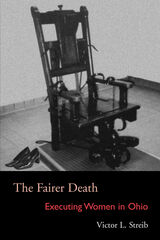 The Fairer Death: Executing Women in Ohio
Victor L. Streib
Ohio University Press, 2006 Women on death row are such a rarity that, once condemned, they may be ignored and forgotten. Ohio, a typical, middle-of-the-road death penalty state, provides a telling example of this phenomenon. The Fairer Death: Executing Women in Ohio explores Ohio’s experience with the death penalty for women and reflects on what this experience reveals about the death penalty for women throughout the nation. Victor Streib’s analysis of two centuries of Ohio death penalty legislation and adjudication reveals no obvious exclusion of women or even any recognition of an issue of sex bias. In this respect, Ohio’s justice system exemplifies the subtle and insidious nature of this cultural disparity. Professor Streib provides detailed descriptions of the cases of the four women actually executed by Ohio since its founding and of the cases of the eleven women sentenced to death in Ohio in the current death penalty era (1973–2005). Some of these cases had a profound impact on death penalty law, but most were routine and drew little attention. A generation later, reversals and commutations have left only one woman on Ohio’s death row. Although Streib focuses specifically on Ohio, the underlying premise is that Ohio is, in many ways, a typical death penalty state. The Fairer Death provides insight into our national experience, provoking questions about the rationale for the death penalty and the many disparities in its administration.
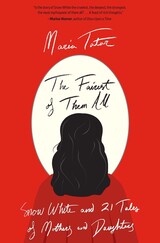 The Fairest of Them All: Snow White and 21 Tales of Mothers and Daughters
Maria Tatar
Harvard University Press, 2020 “With her trademark brio and deep-tissue understanding, Maria Tatar opens the glass casket on this undying story, which retains its power to charm twenty-one times, and counting.”
—Gregory Maguire, author of Wicked
The story of the rivalry between a beautiful, innocent girl and her cruel and jealous mother has been endlessly repeated and refashioned all over the world. The Brothers Grimm gave this story the name by which we know it best, and in 1937 Walt Disney sweetened their somber version to make the first feature-length, animated fairy tale, Snow White and the Seven Dwarfs. Since then, the Disney film has become our cultural touchstone—the innocent heroine, her evil stepmother, the envy that divides them, and a romantic rescue from domestic drudgery and maternal persecution. But each culture has its own way of telling this story of jealousy and competition. An acclaimed folklorist, Maria Tatar brings to life a global melodrama of mother-daughter rivalries that play out in unforgettable variations across countries and cultures.
“Fascinating…A strange, beguiling history of stories about beauty, jealousy, and maternal persecution.”
—Wall Street Journal
“Is the story of Snow White the cruelest, the deepest, the strangest, the most mythopoeic of them all?…Tatar trains a keen eye on the appeal of the bitter conflict between women at the heart of the tale…a feast of rich thoughts…An exciting and authoritative anthology from the wisest good fairy in the world of the fairy tale.”
—Marina Warner
“The inimitable Maria Tatar offers us a maze of mothers and daughters and within that glorious tangle an archetype with far more meaning than we imagine when we say ‘Snow White.’”
—Honor Moore
“Shocking yet familiar, these stories…retain the secret whisper of storytelling. This is a properly magical, erudite book.”
—Literary Review
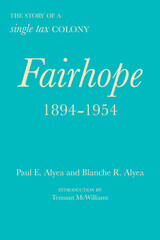 Fairhope, 1894–1954: The Story of a Single Tax Colony
Paul E. Alyea and Blanche R. Alyea, With a New Introduction by Tennant McWilliams
University of Alabama Press, 2022 The remarkable and improbable story of the utopian single-tax social experiment that gave rise to one of the most unique and colorful communities along the Gulf Coast
On November 15, 1894, a small group of men and women met on a remote stretch of Mobile Bay’s eastern shore to establish a colony. It was a decidedly utopian undertaking in a period characterized by many similar social experiments and ideal communities, most of them failures. This group, which gathered at “Stapleton’s pasture” to found Fairhope, hoped to demonstrate the benefits of the single tax as a means of curing social and economic evils, making a practical test of the doctrines of economist Henry George.
Today, the wealth of parks, public and private schools, art galleries, and restaurants, combined with quaint shops and residential areas and a vibrant nautical life, all attest to Fairhope’s unique position among many older communities in the same region. Its residents represent a diverse array of interests and talents, and with a strong civic regard for individualism and creativity, Fairhope is also a haven for painters, potters, writers, and musicians.
Paul E. and Blanche R. Alyea’s Fairhope, 1894–1954, first published in 1954, is the history of this unique and improbable community and the single-tax social experiment that gave rise to it. This new edition offers an introduction by historian and Fairhope resident Tennant McWilliams, giving invaluable context and entertaining anecdotes not just regarding Fairhope’s founding but about the Alyeas themselves—all to the abiding value of their story for today’s residents and visitors.
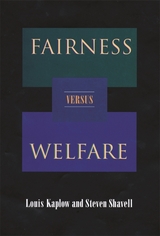 Fairness versus Welfare
Louis Kaplow and Steven Shavell
Harvard University Press, 2002 By what criteria should public policy be evaluated? Fairness and justice? Or the welfare of individuals? Debate over this fundamental question has spanned the ages.
Fairness versus Welfare poses a bold challenge to contemporary moral philosophy by showing that most moral principles conflict more sharply with welfare than is generally recognized. In particular, the authors demonstrate that all principles that are not based exclusively on welfare will sometimes favor policies under which literally everyone would be worse off. The book draws on the work of moral philosophers, economists, evolutionary and cognitive psychologists, and legal academics to scrutinize a number of particular subjects that have engaged legal scholars and moral philosophers.
How can the deeply problematic nature of all nonwelfarist principles be reconciled with our moral instincts and intuitions that support them? The authors offer a fascinating explanation of the origins of our moral instincts and intuitions, developing ideas originally advanced by Hume and Sidgwick and more recently explored by psychologists and evolutionary theorists. Their analysis indicates that most moral principles that seem appealing, upon examination, have a functional explanation, one that does not justify their being accorded independent weight in the assessment of public policy.
Fairness versus Welfare has profound implications for the theory and practice of policy analysis and has already generated considerable debate in academia.
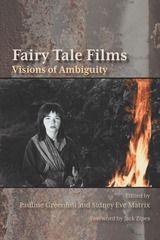 Fairy Tale Films: Visions of Ambiguity
Pauline Greenhill
Utah State University Press, 2010 This ISBN refers to the ebook edition of this text, available directly from the publisher. It has erroneously been listed as paperback by some online vendors. The true paperback edition is indeed available at online vendors. Paste this ISBN into the search box: 9780874217810. In this, the first collection of essays to address the development of fairy tale film as a genre, Pauline Greenhill and Sidney Eve Matrix stress, "the mirror of fairy-tale film reflects not so much what its audience members actually are but how they see themselves and their potential to develop (or, likewise, to regress)." As Jack Zipes says further in the foreword, “Folk and fairy tales pervade our lives constantly through television soap operas and commercials, in comic books and cartoons, in school plays and storytelling performances, in our superstitions and prayers for miracles, and in our dreams and daydreams. The artistic re-creations of fairy-tale plots and characters in film—the parodies, the aesthetic experimentation, and the mixing of genres to engender new insights into art and life— mirror possibilities of estranging ourselves from designated roles, along with the conventional patterns of the classical tales.”
Here, scholars from film, folklore, and cultural studies move discussion beyond the well-known Disney movies to the many other filmic adaptations of fairy tales and to the widespread use of fairy tale tropes, themes, and motifs in cinema.
Fairy Tale Fun!
American Library Association
American Library Association, 2012
 Fairy Tales and After: From Snow White to E. B. White
Roger Sale
Harvard University Press, 1978 Roger Sale invites us to discover anew some of the great works of children's literature, works that have been read and loved but seldom given the benefit of serious literary assessment. It takes a critic of special gifts—receptiveness, discrimination, clarity of perception, independence of judgment—to discuss these books as illuminatingly as Sale does.
This is not a survey but a very personal book: Sale writes about stories and books with which he feels an imaginative sympathy. As it happens, they include a great many of the classic children's texts, works as disparate as “Beauty and the Beast” and Alice, The Wind in the Willows and Babar, “The Snow Queen” and Peter Rabbit, the Jungle Book and the Oz books. He conveys a fresh sense of what is special and memorable about each of them.
While avoiding conventional literary history, he sketches the circumstances of the author's life when they provide insight into the works. Unlike Bettelheim and others, Sale is not concerned with the “uses” of children's literature. He writes for adults, with the conviction that adults can find delight in these books. Many already do, and perhaps with his stimulus, many more will.
 Fairy Tales from Before Fairy Tales: The Medieval Latin Past of Wonderful Lies
Jan M. Ziolkowski
University of Michigan Press, 2009 When did fairy tales begin? What qualifies as a fairy tale? Is a true fairy tale oral or literary? Or is a fairy tale determined not by style but by content? To answer these and other questions, Jan M. Ziolkowski not only provides a comprehensive overview of the theoretical debates about fairy tale origins but includes an extensive discussion of the relationship of the fairy tale to both the written and oral sources. Ziolkowski offers interpretations of a sampling of the tales in order to sketch the complex connections that existed in the Middle Ages between oral folktales and their written equivalents, the variety of uses to which the writers applied the stories, and the diverse relationships between the medieval texts and the expressions of the same tales in the "classic" fairy tale collections of the nineteenth century. In so doing, Ziolkowski explores stories that survive in both versions associated with, on the one hand, such standards of the nineteenth-century fairy tale as the Brothers Grimm, Hans Christian Andersen, and Carlo Collodi and, on the other, medieval Latin, demonstrating that the literary fairy tale owes a great debt to the Latin literature of the medieval period. Jan M. Ziolkowski is the Arthur Kingsley Porter Professor of Medieval Latin at Harvard University.
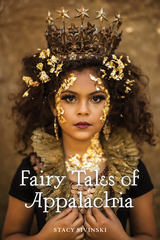 Fairy Tales of Appalachia
Stacy Sivinski
University of Tennessee Press, 2023 While taking a graduate course in Appalachian literature at the University of Tennessee, Stacy Sivinski was surprised to discover that much of the folklore she had heard while growing up in Schuyler, Virginia, was rarely represented in popular published collections. In particular, they lacked the strong female heroines she had come to know, and most anthologies were full of Jack Tales—stories that focus on the adventures of the character from “Jack and the Beanstalk.” Feminist critics have long discussed the gender inequalities and stereotypes that fairy tales often promote. With Fairy Tales of Appalachia, Sivinski asks whether such conclusions are inevitable and invites a fresh analysis of these regional tales with a contemporary sense of wonder.
These tales, carefully and thoughtfully transcribed by Sivinski, have been passed down through Appalachia’s oral histories over decades and even centuries. This wonderful selection was mainly drawn from the Archives of Appalachia at East Tennessee State University and special collections at Berea College. Drawing on the work of other regional archivists and folklorists, Sivinski grapples with issues of gender balance in Appalachian storytelling. The problem, Sivinski posits, does not rest with the fairy tale genre itself but in the canonization process, in which
women’s contributions have been diminished as oral traditions become transcribed.
Appalachian women have historically demonstrated resilience, wit, and adaptability, and it is time that more collections of regional folklore reorient themselves to make this fact more apparent. Stories are living, breathing narratives, meant not just to be read but to be read aloud. This timely selection of unique stories, along with beautiful, evocative illustrations, makes Fairy Tales of Appalachia an intriguing addition to the much-contested “fairy tale canon.”
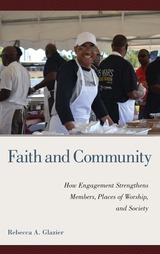 Faith and Community: How Engagement Strengthens Members, Places of Worship, and Society
Rebecca A. Glazier
Temple University Press, 2024 Places of worship are important anchor institutions in communities, helping to create social capital through discussion groups, soup kitchens, and neighborhood clean-ups. While congregations face increasing pressures, from declining attendance to political polarization, community engagement is an overall positive for their members and for democracy.
Faith and Community shows the benefits of religious people taking action in their communities. Through more than a decade of multi-method data collection, Rebecca Glazier surveyed over 4,000 congregants and nearly 500 clergy in Little Rock, Arkansas to gather opinions from members and leaders on community issues and engagement. Together with interviews and case studies, her findings indicate that active congregants are happier and more civically involved.
Faith and Community provides valuable insights into the relationship between religion and community engagement. The data illustrates how community engagement benefits individuals, congregations, and democracy and offers one solution to what ails religion in America today.
Faith and Doubt as Partners in Mormon History
Gregory A. Prince
Utah State University Press, 2014 Volume 19, The Leonard J. Arrington Lecture Series The Special Collections and Archives of Utah State University's Merrill-Cazier Library houses the personal and historical collection of Leonard J. Arrington, renowned scholar of the American West. The Leonard J. Arrington Mormon History Lecture annually hosts the presentation of current research by a leading scholar. Among the lecturers have been such notable historians as Thomas G. Alexander, Richard L. Bushman, Sarah Barringer Gordon, Howard Lamar, Jan Shipps, Donald Worster, and Pulitzer Prize-winner Laurel Thatcher Ulrich.
 Faith And Faithfulness: Basic Themes in Christian Ethics
Gilbert C. Meilaender
University of Notre Dame Press, 1992 Meilaender suggests that Christians should not try to develop an autonomous ethic; neither, however, need they deny the common ground that exists with those who stand in other traditions. He then discusses human nature as creaturely, sinful, and justified--using these categories to think about such topics as the relation of humans to their environment, the meaning of personhood, and the meaning of original sin.
"Meilaender has an unusual ability to treat complex topics with clarity, charm, and insight. In this book, he masterfully explores how certain central Christian themes must be held in tension together. He argues for a distinctively Christian ethics that is, nonetheless, open to general ethics."-Theological Studies
"Present times are blessed with a number of readily accessible (easy to get and easy to read) books by rigorous academic authors who temporarily set aside their technical vocabulary to gift us with their insights. Faith and Faithfulness is such a book; it takes up and brilliantly answers questions a thoughtful but busy Christian nonphilosopher might have."-New Oxford Review
----------
"Meilaender has an unusual ability to treat complex topics with clarity, charm, and insight. In this book, he masterfully explores how certain central Christian themes must be held in tension together. He argues for a distinctively Christian ethics that is, nonetheless, open to general ethics." -Theological Studies "Present times are blessed with a number of readily accessible (easy to get and easy to read) books by rigorous academic authors who temporarily set aside their technical vocabulary to gift us with their insights. Faith and Faithfulness is such a book; it takes up and brilliantly answers questions a thoughtful but busy Christian nonphilosopher might have." -New Oxford Review
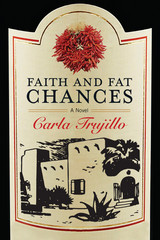 Faith and Fat Chances: A Novel
Carla Trujillo
Northwestern University Press, 2015 Finalist, 2012 PEN/Bellwether Prize for Socially Engaged Fiction
Carla Trujillo brings to life another side of the fabled city of Santa Fe in this rollicking novel set in Dogtown, a dilapidated neighborhood on the outskirts of town. Home to a hardscrabble community of working people struggling to make a living on meager means, Dogtown is worlds apart from the tourists, artists, and upscale eateries just a stone’s throw away. The close-knit neighborhood thrives in its own way, until an entrepreneur arrives with a plan to cast out its occupants and construct a winery in its place. Led by Dogtown’s unofficial mayor, Pepa Romero—an irreverent healer with old-world wisdom and new-age knowledge—the citizens of Dogtown revolt. Using everything at their disposal, including spying, supernatural powers, the law, and individual cunning, they set in motion a thrilling and at times hilarious chain of events that culminates in a storm of epic proportions. With an unforgettable cast of characters, Faith and Fat Chances illuminates the ingenuity and resilience of people fighting to preserve their way of life.
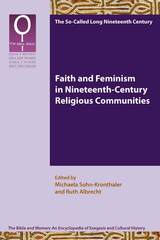 Faith and Feminism in Nineteenth-Century Religious Communities
Michaela Sohn-Kronthaler
SBL Press, 2019 Explore a diversity of feminist readings of the Bible
This latest volume in the Bible and Women series is concerned with documenting, through word and image, both well-known and largely unknown women and their relationship to the Bible from the period of the late eighteenth century up to the beginning of the twentieth century. The essays in this collection illustrate the broad range of treatment of the Holy Scripture. Paul Chilcote, Marion Ann Taylor, Christiana de Groot, Elizabeth M. Davis, and Pamela S. Nadell offer perspectives on the Anglo-American sphere during this period. Marina Cacchi, Adriano Valerio, Inmaculada Blasco Herranz, and Alexei Klutschewski and Eva Maria Synek illuminate the areas of southern and eastern Europe. Angela Berlis, Ruth Albrecht, Doris Brodbeck, Ute Gause, and Michaela Sohn-Kronthaler examine women from the German-speaking world and their texts. Bernhard Schneider, Magda Motté, Katharina Büttner-Kirschner, and Elfriede Wiltschnigg treat the subject area of religious literature and art.
Features
- Insight into how women participated in academic exegesis and applied biblical figures as models for structuring their own lives
- Exploration of genres used by women, including letters, diaries, autobiographical records, stories, novels, songs, poems, and specialized exegetical treatises and commentaries on individual books of the Bible
- Detailed analyses of women’s interpretations ranging from those that sought to confirm traditions to those that challenged them
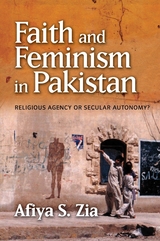 Faith and Feminism in Pakistan: Religious Agency or Secular Autonomy?
Afiya S. Zia
Sussex Academic Press, 2022 Are secular aims, politics, and sensibilities impossible, undesirable and impracticable for Muslims and Islamic states? Should Muslim women be exempted from feminist attempts at liberation from patriarchy and its various expressions under Islamic laws and customs? Considerable literature on the entanglements of Islam and secularism has been produced in the post-9/11 decade and a large proportion of it deals with the "Woman Question". Many commentators critique "the secular and "Western feminism," and the racialising backlash that accompanied the occupation of Muslim countries during the "War on Terror" military campaign launched by the U.S. government after the September 11 attacks in 2001. Implicit in many of these critical works is the suggestion that it is Western secular feminism that is the motivating driver and permanent collaborator along with other feminists, secularists and human rights activists in Muslim countries that sustains the West's actual and metaphorical "war on Islam and Muslims."Faith and Feminism;addresses this post-9/11 critical trope and its implications for women's movements in Muslim contexts. The relevance of secular feminist activism is illustrated with reference to some of the nation-wide, working-class women's movements that have surged throughout Pakistan under religious militancy: polio vaccinators, health workers, politicians, peasants and artists have been directly targeted, even assassinated, for their service and commitment to liberal ideals. Afiya Zia contends that Muslim women's piety is no threat against the dominant political patriarchy, but their secular autonomy promises transformative changes for the population at large, and thereby effectively challenges Muslim male dominance. This book is essential reading for those interested in understanding the limits of Muslim women's piety and the potential in their pursuit for secular autonomy and liberal freedoms.
 Faith and Force: A Christian Debate about War
David L. Clough and Brian Stiltner
Georgetown University Press, 2007 "This book began in an argument between friends surprised to find themselves on opposite sides of the debate about whether the United States and the United Kingdom should invade Iraq in 2003. Situated on opposite sides of the Atlantic, in different churches, and on different sides of the just war/pacifist fence, we exchanged long emails that rehearsed on a small scale the great national and international debates that were taking place around us. We discovered the common ground we shared, as well as some predictable and some surprising points of difference....When the initial hostilities ended, our conversation continued, and we felt the urgency of contributing to a wider Christian debate about whether and when war could be justified."
—From the Preface So began a dynamic collaboration that developed into a civil but provocative debate over matters of war and peace that is Faith and Force. From the ancient battles between Greek city-states to the Crusades to the World Wars of the twentieth-century to the present-day wars in Afghanistan and Iraq and the Middle East, aggressors and defenders alike have claimed the mantle of righteousness and termed their actions just. But can the carnage of war ever be morally grounded? And if so, how? These are the questions that David L. Clough, a Methodist proponent of pacifism, and Brian Stiltner, a Catholic theologian and just war adherent, have vowed to answer—together. With one voice, Clough and Stiltner outline and clarify issues of humanitarian intervention, weapons proliferation, and preventative war against rogue states. Their writing is grounded in Christian tradition and provides a fresh and illuminating account of the complexities and nuances of the pacifist and just war positions. In each chapter Clough and Stiltner engage in debate on the issues, demonstrating a respectful exchange of ideas absent in much contemporary political discourse—whether on television or in the classroom. The result is a well-reasoned, challenging repartee that searches for common ground within the Christian tradition and on behalf of the faithful promotion of justice—yet one that also recognizes genuine differences that cannot be bridged easily. Intended for a broad audience, Faith and Force is the perfect foil to the shrill screeching that surrounds partisan perspectives on military power and its use. To help with using the book in a classroom context, the authors have provided Questions for Reflection and Discussion for each chapter. You can download these questions in PDF format at press.georgetown.edu.
Faith and Fury: Eli Farmer on the Frontier, 1794–1881
Riley B. Case
Indiana Historical Society Press, 2018 Some of America’s political and social identity today can be traced to the early frontier. After 1801 religion exploded across settlements in the Old Northwest and Kentucky. Not only were souls saved through camp meetings, but regular people also began applying the words “equal” and “independent” to themselves. The life of Eli P. Farmer, a circuit-riding preacher, politician, farmer, and businessman, is instructive. His autobiography includes accounts of Native Americans, brawls, flatboats, settlers, and revival meetings. Setting his story within the context of the Second Great Awakening, author Riley B. Case shows how Farmer’s life personified this religious movement, which gave birth to American evangelicalism, as well as values that would become idyllic to many Americans: self-sufficiency and individualism.
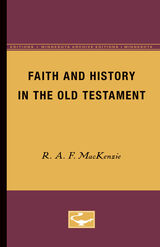 Faith and History in the Old Testament
R.A.F. MacKenzie
University of Minnesota Press, 1963 Faith and History in the Old Testament was first published in 1963. Minnesota Archive Editions uses digital technology to make long-unavailable books once again accessible, and are published unaltered from the original University of Minnesota Press editions. This absorbing and readable account of the religion of ancient Israel is presented against the background of other cultures of the time. Father MacKenzie traces the development of Israel's belief and draws upon modern knowledge of the cultures of the ancient Near East to illuminate the history. But the main stress is on the religious meaning which the Israelites themselves perceived in the events they experienced, a meaning which is accepted and extended in different ways by modern Jews and by Christians. The author explains, in non-technical style, the distinctive features of the faith of the Old Testament as evident in such themes as covenant, creation, retribution, the pursuit of wisdom, and the hope of salvation. At the outset, he defines the study of theology and places the study of Chrisson with that of Israel. He analyzes Israel's concept of God and the character of the covenant between God and the people of Israel, discusses the Israelite literature on the creation of earth and its creatures, and considers the interrelationship between myth and history. He discusses the search for wisdom in Israel, the public prayers, and the concept of a promise from the deity. In conclusion, he presents the interpretation by the Old Testament authors of these distinctive features of Israel's religion. The book is intended for lay people interested in modern Bible interpretation, as well as for priests, ministers, and rabbis who wish a general survey of the Old Testament. It is suitable for use as a text or supplementary reading in religion or theology courses.
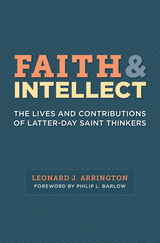 Faith and Intellect: The Lives and Contributions of Latter-day Saint Thinkers
Leonard J Arrington
Signature Books, 2019 Joseph Smith was not the first to found a Christian denomination, but his addition of a new book of scripture on par with the Bible set him and his movement apart. Even before 1830, Smith was both dismissed and admired, embraced and rejected. But most observers agree that he has rightfully earned a significant place in American religious history. Many of the followers he attracted in his day and after have also helped to shape LDS thought. This volume highlights the lives and contributions of Smith, his successor Brigham Young, and eleven others, including Lowell Bennion, Claudia L. Bushman, Hugh Nibley, Chieko Okazaki, B. H. Roberts, James E. Talmage, Laurel Thatcher Ulrich, and Emmeline B. Wells. All together, the women and men profiled here span the nineteenth and twentieth centuries and illuminate what the LDS Church has meant, and continues to mean, to its most thoughtful members.
 Faith and Meaning in the Southern Uplands
Loyal Jones
University of Illinois Press, 1999 Never have so many missionaries been sent to save so many Christians as is the case in the Southern Uplands. The area has long been perceived by American Christians in contradictory ways: on the one hand, as an unchurched area with people who have little religion or an inadequate faith; on the other, as part of the Bible Belt, packed with small breakaway fundamentalist churches and wild-eyed believers.
In Faith and Meaning, one of Appalachian religion's most eloquent spokesmen reveals a people devoted to and thoughtful about their religion, and profoundly influenced by it. Loyal Jones's three decades of conversations and interviews, supplemented by documents such as sermons, testimonies, and articles of faith, articulate Southern Upland views on basic issues of the human condition—faith, God, the world, the Word, and the devil—as well as on community issues such as racial integration and women in the church. In their own voices these people describe their beliefs, their churches, and their lives, exposing a deep conviction tempered with humanity and humor.
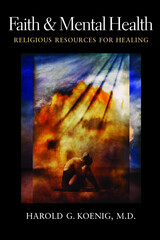 Faith and Mental Health: Religious Resources for Healing
Harold G. Koenig
Templeton Press, 2005 Dr. Harold Koenig opens a window on mental health, providing an unprecedented source of practical information about the relationship between religion and mental health. He examines how Christianity and other world religions deliver mental health services today, and he makes recommendations, based on research, expertise, and experience, for new programs to meet local needs. Meticulously researched and documented, Faith and Mental Health includes - Research on the relationship between religion and positive emotions, psychiatric illnesses, and severe and persistent mental disorders
- Ways in which religion has influenced mental health historically, and how now and in the future it can be involved with mental health
- A comprehensive description and categorization of Christian and non-Christian faith-based organizations that provide mental health resources
- Resources for religious professionals and faith communities on how to design effective programs
Presenting a combination of the history and current research of mental health and religion along with a thorough examination of faith-based organizations operating in the field, this book is a one-of-a-kind resource for the healthcare community; its valuable research and insights will benefit medical and religious professionals, and anyone concerned with the future of mental health care.
Faith and Political Philosophy: The Correspondence Between Leo Strauss and Eric Voegelin, 1934-1964
Edited & Intro by Peter Emberley & Barry Cooper
University of Missouri Press, 2004 Faith and Political Philosophy consists of fifty-three letters between Leo Strauss and Eric Voegelin, two of the most important political theorists of the twentieth century. In this correspondence, Strauss and Voegelin explore the nature of their similarities and differences, offering insightful observations about one another's work, about the state of the discipline, and about the influences working on them. The letters shed light on many assumptions made in their published writings, often with an openness that removes all vestiges of uncertainty.
Faith and Rationality: Reason and Belief in God
Alvin Plantinga
University of Notre Dame Press, 1984 Faith and Rationality investigates the rich implications of what the contributors call "Calvinistic" or "Reformed epistemology." This is the view of knowledge--enunciated by Calvin, further developed by Barth--that sees belief in God as its own foundation; in the contributors' terms, it is properly "basic" in itself.
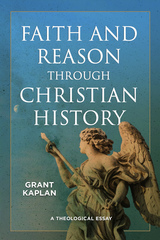 Faith and Reason through Christian History: A Theological Essay
Grant Kaplan
Catholic University of America Press, 2022 It is impossible to understand the history of Christian theology without taking into account the relationship between faith and reason. Many works give an overview of faith and reason, or outline key principles, while others put forward a thesis about how one should understand the relationship between faith and reason. In this theological essay, Grant Kaplan revisits the key figures and debates that shape how faith and reason relate. Divided into three parts, Kaplan invites readers into a conversation rather than a drive-by. Readers will encounter the words and arguments of some of Christianity’s greatest thinkers, some well-known (Augustine, Aquinas, Newman) and others nearly forgotten. Readings of these figures bring them to life in an accessible manner.
In Faith and Reason through Christian History, the roughly fifty figures treated are given sufficient room to breathe. Rather than simply summarizing their thought, Kaplan traces their arguments through key texts. This book will appeal to a range of audiences: theologians and philosophers, instructors, graduate students, seminarians, lay study groups, and undergraduate theology majors. No book today accomplishes what this book does!
Faith and Resistance: The Politics of Love and War in Lebanon
Sarah Marusek
Pluto Press, 2018 Exploring the rise of Shi’i activism in Lebanon and the broader Middle East, in Faith and Resistance Sarah Marusek offers a timely analysis of the social and political evolution of Islamic movements. These movements, she shows, have long existed in opposition to a number of different forces. And while that opposition has often been full of contradictions, the growing popularity of such movements has nonetheless led to increasing economic and political powers. Marusek shows here how resistance groups reconcile the acquisition of power with their larger anti-colonial aspirations.
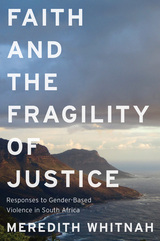 Faith and the Fragility of Justice: Responses to Gender-Based Violence in South Africa
Meredith Whitnah
Rutgers University Press, 2025 South Africa has repeatedly made international headlines because of its high rates of gender-based violence. In the midst of a wide range of responses to the problem, an important voice has been largely absent. Why are the religious groups that had famously protested the racial violence of apartheid faltering in their response to gendered violence in the democracy? Faith and the Fragility of Justice answers this question through a deep dive into the public discourse of three Protestant Christian organizations that had been adamant about a theological mandate to challenge apartheid, but have varied in their responses to gender-based violence in the democracy. The central argument of the book is that the organizations’ theological convictions intersect with their posture toward various social groups to shape their actions. In making this argument, Meredith Whitnah demonstrates that religious beliefs are a central dimension of institutional processes that sustain or challenge social inequality and violence.
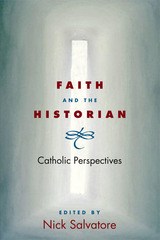 Faith and the Historian: CATHOLIC PERSPECTIVES
Edited by Nick Salvatore
University of Illinois Press, 2006 Faith and the Historian collects essays from eight experienced historians discussing the impact of being "touched" by Catholicism on their vision of history. That first graduate seminar, these essays suggest, did not mark the inception of one's historical sensibilities; rather, that process had deeper, and earlier, roots. The authors--ranging from "cradle to the grave" Catholics to those who haven’t practiced for forty years, and everywhere in between--explicitly investigate the interplay between their personal lives and beliefs and the sources of their professional work. A variety of heartfelt, illuminating, and sometimes humorous experiences emerge from these stories of intelligent people coming to terms with their Catholic backgrounds as they mature and enter the academy. Contributors include: Philip Gleason, David Emmons, Maureen Fitzgerald, Joseph A. McCartin, Mario T. Garcia, Nick Salvatore, James R. Barrett, and Anne M. Butler.
Faith and the Pursuit of Health: Cardiometabolic Disorders in Samoa
Hardin, Jessica
Rutgers University Press, 2019 Faith and the Pursuit of Health explores how Pentecostal Christians manage chronic illness in ways that sheds light on health disparities and social suffering in Samoa, a place where rates of obesity and related cardiometabolic disorders have reached population-wide levels. Pentecostals grapple with how to maintain the health of their congregants in an environment that fosters cardiometabolic disorders. They find ways to manage these forms of sickness and inequality through their churches and the friendships developed within these institutions. Examining how Pentecostal Christianity provides many Samoans with tools to manage day-to-day issues around health and sickness, Jessica Hardin argues for understanding the synergies between how Christianity and biomedicine practice chronicity.
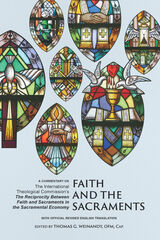 Faith and the Sacraments: A Commentary on The International Theological Commission's The Reciprocity of Faith and Sacraments in the Sacramental Economy: With Official Revised English Translation
International Theological Comission
Catholic University of America Press, 2022 In September of 2014 thirty new members were appointed for a five-year term to the Vatican’s International Theological Commission. These theologians, clerical and lay, were chosen from twenty-six different countries and from five continents. The commission was charged with composing three documents of contemporary theological importance, one of which was that of the relationship between faith and the sacraments. This finished document was published, with the approval of the Congregation for the Doctrine of the Faith and by Pope Francis in Spanish in early 2020 under the title: La Reciprocidad entre Fe y Sacramentos en la Economía Sacramental. A subsequent English translation was published thereafter under the title The Reciprocity Between Faith and Sacraments in the Sacramental Economy.
This present volume contains the text of the English translation. There follows an introduction by a member of the ITC, Thomas G. Weinandy, OFM, Cap., and subsequently followed by six explanatory and interpretive commentaries on various chapters of the document. Dr. John Yocum considers the contemporary relevance of the topic. Dr. Christopher Ruddy examines the dialogical nature of the sacramental economy of salvation. Dr. Jennifer Holmes Martin discusses the relationship between faith and the sacraments of initiation. There are two commentaries for section four concerning faith and the sacrament of marriage. Professor John Grabowski treats the strictly theological issues relating to faith and marriage. Canonist Timothy Cavanaugh takes up the canonical issues regarding faith and its relationship to enacting a valid sacramental marriage. Dr. Daniel Keating rounds off the commentaries by surveying the conclusion of the document, that is, the present need for evangelization so as to enliven the faith of the faithful, and the present relevance of the new ecclesial movements within the Church today.
These commentaries are aimed at aiding priests and seminarians as they address or prepare to address the pastoral and theological concerns they encounter or will encounter on a daily basis. This volume could also be used in parish adult education groups as well, wherein the laity could better understand the relationship between faith and the sacraments.
Faith and Violence: Christian Teaching and Christian Practice
Thomas Merton
University of Notre Dame Press, 1968 This is an incisive and fascinating insight into the many problems facing America and the world.
“Although it comes from a man who has chosen a life of silence and contemplation, this is an impassioned book, showing that the cloister may be a retreat from but not necessarily an escape from the world, if one is genuinely committed to the Christian faith. Merton’s chief concern is not with the haphazard violence of oppressed individuals that is expressed in riots but with what he calls ‘white-collar violence, the systematically organized bureaucratic and technological destruction of man.' . . . His thinking is radical, but unless one is committed to the belief that the status quo is the will of God, what he proposes deserves serious consideration.” —Pulpit Digest
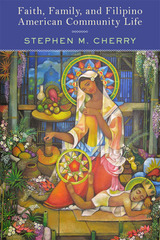 Faith, Family, and Filipino American Community Life
Cherry, Stephen M
Rutgers University Press, 2014 Stephen M. Cherry draws upon a rich set of ethnographic and survey data, collected over a six-year period, to explore the roles that Catholicism and family play in shaping Filipino American community life. From the planning and construction of community centers, to volunteering at health fairs or protesting against abortion, this book illustrates the powerful ways these forces structure and animate not only how first-generation Filipino Americans think and feel about their community, but how they are compelled to engage it over issues deemed important to the sanctity of the family.
Revealing more than intimate accounts of Filipino American lives, Cherry offers a glimpse of the often hidden but vital relationship between religion and community in the lives of new immigrants, and allows speculation on the broader impact of Filipino immigration on the nation. The Filipino American community is the second-largest immigrant community in the United States, and the Philippines is the second-largest source of Catholic immigration to this country. This ground-breaking study outlines how first-generation Filipino Americans have the potential to reshape American Catholicism and are already having an impact on American civic life through the engagement of their faith.
 Faith, Family, and Flag: Branson Entertainment and the Idea of America
Joanna Dee Das
University of Chicago Press, 2025 Sons of Britches. The Great American Chuckwagon Dinner Show. The Haygoods. The Grand Jubilee. These are just a couple of the many shows performed in Branson, MO, where the seemingly innocent entertainment fuels American conservatism.
Branson, Missouri, the Ozark Mountain mecca of wholesome entertainment, has been home to countless stage shows espousing patriotism and Christianity, welcoming over ten million visitors a year. Some consider it “God’s Country” and others “as close to Hell as anything on Earth.” For Joanna Dee Das, Branson is a political, religious, and cultural harbinger of a certain enduring dream of what America is. She takes Branson more seriously than the light-hearted fun it advertises—and maybe we should too.
For Das, Branson’s performers offer visions of the American Dream that embody a set of values known as the three Fs: faith, family, and flag. Branson boosters insist that these are universal values that welcome all people; the city aims to capture as many tourists as possible. But over the past several decades, faith, family, and flag have become markers of contemporary conservatism. The shows and culture of Branson, for all their fun and laughter, have been a galvanizing political force for white, working-and-middle class, Christian Americans. For social and economic conservatives alike, Branson is practically proof-of-concept for America as they want it to be.
Faith, Family, and Flag is a comprehensive history of the Branson entertainment industry, within the context of America’s long culture wars. Das reveals how and why a town known for popular entertainment, a domain associated most often with the political left (“Hollywood liberals”), came to be so important to the political right and its vision for America.
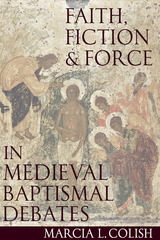 Faith, Force and Fiction in Medieval Baptismal Debates
Marcia L. Colish
Catholic University of America Press, 2014 Drawing on a wide and interdisciplinary range of sources that goes well beyond the writings of theologians and canonists to include liturgical texts and practices, the rulings of popes and church councils, saints' lives, chronicles, imaginative literature, and poetry, Faith, Fiction and Force in Medieval Baptismal Debates illuminates the emergence and fortunes of these three controversies and the historical contexts that situate their development. Each debate has its own story line, its own turning points, and its own seminal figures whose positions informed its course. The thinkers involved in each case were, and regarded one another as being, members of the orthodox western Christian communion. Thus, another finding of this book is that Christian orthodoxy in the Middle Ages was able to encompass and accept disagreements both wide and deep on a sacrament seen as fundamental to Christian identity, faith and practice.
The Faith Healer of Olive Avenue: Stories
Manuel Muñoz and Cherríe Moraga
Northwestern University Press, 2025 The luminous second collection that cemented Muñoz as a key voice of and for California’s Central Valley
From the divergent paths of triplet brothers to a grieving father confronting his mistreatment of his son, these stories interweave a recurring cast of neighborhood characters, many of them in search of escape or release. Lauded for its empathetic portrayals of communities often ignored, The Faith Healer of Olive Avenue won a Whiting Award and an O. Henry Award; it was shortlisted for the Frank O’Connor International Short Story Award as one of the best collections published in English worldwide. A new foreword by author and activist Cherríe Moraga gives testament to Muñoz’s status as “the cartographer of a people.”
 Faith, Hope, and Jobs: Welfare-to-Work in Los Angeles
Stephen V. Monsma and J. Christopher Soper
Georgetown University Press, 2006 A front-burner issue on the public policy agenda today is the increased use of partnerships between government and nongovernmental entities, including faith-based social service organizations. In the wake of President Bush's faith-based initiative, many are still wondering about the effectiveness of these faith-based organizations in providing services to those in need, and whether they provide better outcomes than more traditional government, secular nonprofit, and for-profit organizations. In Faith, Hope, and Jobs, Stephen V. Monsma and J. Christopher Soper study the effectiveness of 17 different welfare-to-work programs in Los Angeles County—a county in which the U.S. government spends 14% of its entire welfare budget—and offer groundbreaking insight into understanding what works and what doesn't. Monsma and Soper examine client assessment of the programs, their progress in developing attitudes and resources important for finding self-supporting employment, and their experience in finding actual employment. The study reveals that the clients of the more explicitly faith-based programs did best in gaining in social capital and were highly positive in evaluating the religious components of their programs. For-profit programs tended to do the best in terms of their clients finding employment. Overall, the religiously active respondents tended to experience better outcomes than those who were not religiously active but surprisingly, the religiously active and non-active tended to do equally well in faith-based programs. Faith, Hope, and Jobs concludes with three sets of concrete recommendations for public policymakers, social service program managers, and researchers.
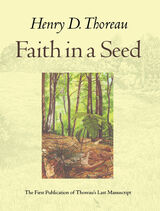 Faith in a Seed: The Dispersion Of Seeds And Other Late Natural History Writings
Henry D. Thoreau; Edited by Bradley P. Dean; Foreword by Gary Paul Nabhan; Introduction by Robert D. Richardson
Island Press, 1993 Faith in a Seed contains the hitherto unpublished work The Dispersion of Seeds, one of Henry D. Thoreau's last important research and writing projects, and now his first new book to appear in 125 years. With the remarkable clarity and grace that characterize all of his writings, Thoreau describes the ecological succession of plant species through seed dispersal. The Dispersion of Seeds, which draws on Charles Darwin's theory of natural selection, refutes the then widely accepted theory that some plants spring spontaneously to life, independent of roots, cuttings, or seeds. As Thoreau wrote: "Though I do not believe a plant will spring up where no seed has been, I have great faith in a seed. Convince me that you have a seed there, and I am prepared to expect wonders." Henry D. Thoreau's Faith in a Seed, was first published in hardcover in 1993 by Island Press under the Shearwater Books imprint, which unifies scientific views of nature with humanistic ones. This important work, the first publication of Thoreau's last manuscript, is now available in paperback. Faith in a Seed contains Thoreau's last important research and writing project, The Dispersion of Seeds, along with other natural history writings from late in his life. Edited by Bradley P. Dean, professor of English at East Carolina University and editor of the Thoreau Society Bulletin, these writings demonstrate how a major American author at the height of his career succeeded in making science and literature mutually enriching.
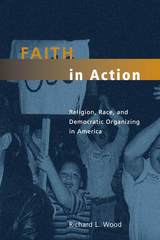 Faith in Action: Religion, Race, and Democratic Organizing in America
Richard L. Wood
University of Chicago Press, 2002 Over the past fifteen years, associations throughout the U.S. have organized citizens around issues of equality and social justice, often through local churches. But in contrast to President Bush's vision of faith-based activism, in which groups deliver social services to the needy, these associations do something greater. Drawing on institutions of faith, they reshape public policies that neglect the disadvantaged.
To find out how this faith-based form of community organizing succeeds, Richard L. Wood spent several years working with two local groups in Oakland, California—the faith-based Pacific Institute for Community Organization and the race-based Center for Third World Organizing. Comparing their activist techniques and achievements, Wood argues that the alternative cultures and strategies of these two groups give them radically different access to community ties and social capital.
Creative and insightful, Faith in Action shows how community activism and religious organizations can help build a more just and democratic future for all Americans.
 Faith in Disguise: A Novella
Mayra Santos-Febres; translated from the Spanish by John A. Mundell
Vanderbilt University Press, 2026 Told from the perspective of Martín Tirado, a white Puerto Rican digital historian working at the University of Chicago, Fe en disfraz details the sexual relationship between Martín and his boss, Fe Verdejo, an Afro-Venezuelan historian and museologist who is putting together an exhibition on black women freed from slavery in Latin America at the University of Chicago. Martín himself becomes an interpreter and scribe of black women’s voices through the recounting of Fe’s work and their sexual encounters. Functioning as chapter-length interludes, historical documents that Fe sends him to review from a mysterious collection—many of which Santos-Febres admits in the author’s note that she compiled or made up—interject the twenty-first-century narrative. These interludes detail white men’s sexual subjugation and humiliation of black and mixed-race women during slavery across various sites of Latin America as testaments of white supremacist power and desire.
Meanwhile, the sadomasochist bent of Fe and Martín’s interracial sexual encounters, where Fe sets the rules of engagement and manipulates Martín to her whims, brings this historical archive into the present moment and inverts the racial and gender hierarchy of social relations in Latin America, past and present. Mayra Santos-Febres’s novella is one of the most descriptive pieces of literature to demonstrate the afterlife of slavery, especially in the context of Latin America. Its availability in English for the first time will bring a new readership and engagement to this complicated text.
 Faith in Fiction: The Emergence of Religous Literature in America
David S. Reynolds
Harvard University Press, 1981 The first full-length study of early religious fiction from the Revolution to the Civil War, this book explores a long forgotten genre of writing. Ranging over the fiction of some 250 American writers, Reynolds provides an overview of the bestsellers of their time and the popular culture of the period. The literary movement he traces began as a cautiously allegorical one, and he finds that it evolved into a fairly realistic genre by the mid-nineteenth century. This shift from the metaphysical to the earthly was abetted by the authors' uses of a variety of appealing modes: the oriental and visionary tale, historical fiction on biblical themes, and the domestic novel.
Reynolds' study addresses several questions: When did religion first appear in American fiction, and why was the novel increasingly chosen as the appropriate literary mode of popular inspiration? How could theology become entertainment? In what sense does the rhetorical strategy of this fiction reflect changing ways of religious discussion? How can the sermons, essays, or memoirs of the early writers help us to understand the themes and techniques of their fiction?
Faith in Human Rights: Support in Religious Traditions for a Global Struggle
Robert Traer
Georgetown University Press, 1991 In this first comprehensive study of the problem of a universal definition of human rights, Robert Traer argues that contemporary theological discourse contains an affirmation of faith that unites members of world religious traditions with secular humanists in a common struggle to establish human rights as the basis for human dignity. Scholars of religion, law, and comparative religious ethics, as well as human rights advocates will find it an invaluable guide.
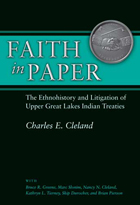 Faith in Paper: The Ethnohistory and Litigation of Upper Great Lakes Indian Treaties
Charles E. Cleland
University of Michigan Press, 2014 Faith in Paper is about the reinstitution of Indian treaty rights in the Upper Great Lakes region during the last quarter of the 20th century. The book focuses on the treaties and legal cases that together have awakened a new day in Native American sovereignty and established the place of Indian tribes on the modern political landscape. In addition to discussing the historic development of Indian treaties and their social and legal context, Charles E. Cleland outlines specific treaties litigated in modern courts as well as the impact of treaty litigation on the modern Indian and non-Indian communities of the region. Faith in Paper is both an important contribution to the scholarship of Indian legal matters and a rich resource for Indians themselves as they strive to retain or regain rights that have eroded over the years. Charles E. Cleland is Michigan State University Emeritus Professor of Anthropology and Curator of Anthropology and Ethnology. He has been an expert witness in numerous Native American land claims and fishing rights cases and written a number of other books on the subject, including Rites of Conquest: The History and Culture of Michigan's Native Americans; The Place of the Pike (Gnoozhekaaning): A History of the Bay Mills Indian Community; and (as a contributor) Fish in the Lakes, Wild Rice, and Game in Abundance: Testimony on Behalf of Mille Lacs Ojibwe Hunting and Fishing Rights.
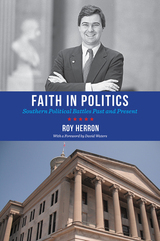 Faith in Politics: Southern Political Battles Past and Present
Roy Herron
University of Tennessee Press, 2021 Roy Herron graduated with highest honors from the University of Tennessee at Martin, then studied New Testament and Ethics in Scotland before earning Divinity and Law degrees from Vanderbilt University. But he came home to West Tennessee and served the Volunteer State in both the Tennessee House and Senate. For four decades, Herron served as a legislator, attorney, teacher, and Methodist minister. In that work, he published op-ed essays and articles in Tennessee’s leading newspapers and publications from The Japan Times to The Wall Street Journal on various topics including constitutional liberties, economic justice, health care, politics, and more.
This informative volume collects the most powerful of these writings, adding helpful updates and contemporary insights. With an engaging, conversational style, Herron addresses voter ID laws, drunk-driving statutes, women’s rights and many recurring, contemporary issues. Whether describing the challenges facing his elderly mother as she attempted to exercise her right to vote, or the struggles of working women and men facing illnesses without health insurance, Herron demonstrates an earnestness and thoughtfulness all too rare in politics.
These nearly fifty essays and articles provide evidence that Herron’s Democratic Party and Christianity are not mutually exclusive. Indeed, Herron describes how faith brought him to politics and to fighting for justice, jobs, and constitutional freedoms for all citizens. Faith in Politics is a veritable guidebook on how faith and spirituality should affect decision making and advocacy in public life.
ROY HERRON was a Tennessee State Representative from 1987 to 1997 and State Senator from 1997 to 2013. He wrote Things Held Dear: Soul Stories for My Sons and God and Politics: How Can a Christian Be in Politics? He coauthored, with Cotton Ivy, Tennessee Political Humor: Some of These Jokes You Voted For. He lawyers and writes in West Tennessee and Nashville.
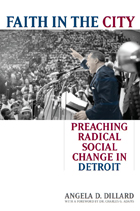 Faith in the City: Preaching Radical Social Change in Detroit
Angela D. Dillard
University of Michigan Press, 2009 “The dynamics of Black Theology were at the center of the ‘Long New Negro Renaissance,’ triggered by mass migrations to industrial hubs like Detroit. Finally, this crucial subject has found its match in the brilliant scholarship of Angela Dillard. No one has done a better job of tracing those religious roots through the civil rights–black power era than Professor Dillard.” —Komozi Woodard, Professor of History, Public Policy & Africana Studies at Sarah Lawrence College and author of A Nation within a Nation: Amiri Baraka (LeRoi Jones) and Black Power Politics “Angela Dillard recovers the long-submerged links between the black religious and political lefts in postwar Detroit. . . . Faith in the City is an essential contribution to the growing literature on the struggle for racial equality in the North.” —Thomas J. Sugrue, University of Pennsylvania, author of The Origins of the Urban Crisis: Race and Inequality in Postwar Detroit Spanning more than three decades and organized around the biographies of Reverends Charles A. Hill and Albert B. Cleage Jr., Faith in the City is a major new exploration of how the worlds of politics and faith merged for many of Detroit’s African Americans—a convergence that provided the community with a powerful new voice and identity. While other religions have mixed politics and creed, Faith in the City shows how this fusion was and continues to be particularly vital to African American clergy and the Black freedom struggle. Activists in cities such as Detroit sustained a record of progressive politics over the course of three decades. Angela Dillard reveals this generational link and describes what the activism of the 1960s owed to that of the 1930s. The labor movement, for example, provided Detroit’s Black activists, both inside and outside the unions, with organizational power and experience virtually unmatched by any other African American urban community. Angela D. Dillard is Associate Professor of Afroamerican and African Studies at the University of Michigan. She specializes in American and African American intellectual history, religious studies, critical race theory, and the history of political ideologies and social movements in the United States.
 Faith in the Furnace of Doubt: Dana Gioia's Poetics of Belief
Joshua Hren
Catholic University of America Press, 2025 Dana Gioia’s characters and verses cry from the depths, their faith tried—and purified—in the furnace of doubt. Enchanted by Gioia’s visionary poetics, the reader discovers that deep faithfulness comes only by way of the via negativa: profundity is preceded by privation; suffering is the school of sure hope; a lover who cannot conquer evil’s great absence has never—has he?—ever really loved.
Gioia’s poetry is an ideal site for thoughtful exposition of spiritual searching undertaken in a contemporary idiom. Faith in the Furnace of Doubt: Dana Gioia's Poetics of Belief draws on the wisdom of St. Augustine and Søren Kierkegaard, René Girard and Jacques Maritain (all of whom Gioia cites as influences) to make intelligible the mystical unveilings and complex movements of faith and doubt that mark Gioia’s poems—from his early verse “The Burning Ladder” to his magnum opus in-progress “The Underworld.”
This first full-length, in-depth study of Gioia’s poetry grants extended interpretation of the meanings a Catholic vision makes manifest. Hren conducts a close reading of poems whose spiritual charges are better grasped when read by the lights of those theologians, philosophers, and poets who have—to paraphrase T.S. Eliot—raided the inarticulate: from Dante to St. Teresa of Avila, from Gerard Manley Hopkins to Nietzsche, from Dionysius the Areopagite to Dostoevsky, from St. John of the Cross to St. John Henry Newman. Gioia’s litanies take all comers to the frayed edges of belief—a cliff that extends over the limits of language, the abyss of unknowing. Maybe at its highest, under the muse of divine madness, poetry can coax us across to the Word, the Lord of language, the “choreographer / of entrances and exits” who speaks all the worries and wonders we’ve left—for all those “midnight / whispers traveling the wires”—unsaid.
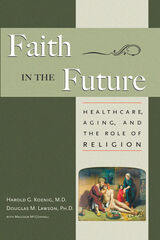 Faith In The Future: Healthcare, Aging and the Role of Religion
Harold Koenig
Templeton Press, 2012 After an interview in Newsweek about his book Spirituality in Patient Care and his research in religion and health, Dr. Harold Koenig became the international voice on spirituality, health, and aging. In this book, Faith in the Future, he is joined by two other experts on aging and human development. They present a compelling look at one of the most severe issues in today’s society: health care in America. How will we provide quality healthcare to older adults needing it during the next thirty to fifty years? Who will provide this care? How will it be funded? How can we establish systems of care now to be in place as demographic and health-related economic pressures mount? Alongside the sobering reality of our country’s challenges, there are reasons for optimism. Innovative programs created and maintained by volunteers and religious congregations are emerging as pivotal factors in meeting healthcare needs. Summarizing decades of scientific research and providing numerous inspirational examples and role models, the authors present practical steps that individuals and institutions may emulate for putting faith into action. <
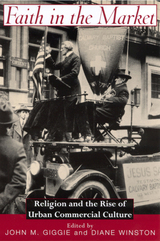 Faith in the Market: Religion and the Rise of Urban Commercial Culture
Edited by John M. Giggie and Diane Winston
Rutgers University Press, 2002 Scholars have long assumed that industrialization and the growth of modern cities signaled a decline of religious practice among urban dwellers - that urban commercial culture weakened traditional religious ties by luring the faithful away from their devotional practice. Spanning many disciplines, the essays in this volume challenge this notion of the "secular city" and examine how members of metropolitan houses of worship invented fresh expressions of religiosity by incorporating consumer goods, popular entertainment, advertising techniques, and marketing into their spiritual lives. Faith in the Market explores phenomena from Salvation Army "slum angels" to the "race movies" of the mid-twentieth century, from Catholic teens' modest dress crusades to Black Muslim artists. The contributors-integrating gender, performance, and material culture studies into their analyses-reveal the many ways in which religious groups actually embraced commercial culture to establish an urban presence. Although the city streets may have proved inhospitable to some forms of religion, many others, including evangelicalism, Catholicism, and Judaism, assumed rich and complex forms as they developed in vital urban centers.
Faith in the public realm: Controversies, policies and practices
Edited by Adam Dinham, Robert Furbey, and Vivien Lowndes
Bristol University Press, 2009 Based on primary research, this book explores the controversies, policies and practices of 'public faith', questioning perceptions of a fixed divide between religious and secular participants in public life and challenging prevailing concepts of a monolithic 'neutral' public realm. It takes an in-depth look at the distinctiveness of faith groups' contribution, but also probes the conflicts and dilemmas that arise, assessing the role and capacity of faith groups within specific public policy contexts, including education, regeneration, housing and community cohesion.'Faith in the public realm' will be of interest to students, academics, policy-makers and practitioners in the public and voluntary sectors, and in faith communities themselves.
Faith in the World: Post-Secular Readings of Hannah Arendt
Ludger Hagedorn and Rafael Zawisza
Campus Verlag, 2021 Explores the relationship between Hannah Arendt’s thought and theology.
This volume is a manifold approach to a less evident and much-neglected undercurrent in the work of Hannah Arendt, namely her ambiguous relation to the Judeo-Christian religious heritage. It contains discussions about strictly theological motives—like salvation or original sin—but it also explores topics such as forgiveness, love, natality, and the world within the religious aura.
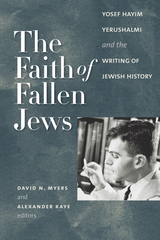 The Faith of Fallen Jews: Yosef Hayim Yerushalmi and the Writing of Jewish History
Edited by David N. Myers and Alexander Kaye
Brandeis University Press, 2013 From his first book, From Spanish Court to Italian Ghetto, to his well-known volume on Jewish memory, Zakhor, to his treatment of Sigmund Freud in Freud’s Moses, Yosef Hayim Yerushalmi (1932–2009) earned recognition as perhaps the greatest Jewish historian of his day, whose scholarship blended vast erudition, unfettered creativity, and lyrical beauty. This volume charts his intellectual trajectory by bringing together a mix of classic and lesser-known essays from the whole of his career. The essays in this collection, representative of the range of his writing, acquaint the reader with his research on early modern Spanish Jewry and the experience of crypto-Jews, varied reflections on Jewish history and memory, and Yerushalmi’s enduring interest in the political history of the Jews. Also included are a number of little-known autobiographical recollections, as well as his only published work of fiction.
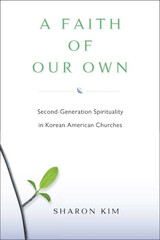 A Faith Of Our Own: Second-Generation Spirituality in Korean American Churches
Kim, Sharon
Rutgers University Press, 2010 Second-generation Korean Americans, demonstrating an unparalleled entrepreneurial fervor, are establishing new churches with a goal of shaping the future of American Christianity.
A Faith of Our Own investigates the development and growth of these houses of worship, a recent and rapidly increasing phenomenon in major cities throughout the United States.
Immigration historians have depicted the second-generation as a transitional generation--on the steady march toward the inevitable decline of ethnic identity and allegiance. Sharon Kim suggests an alternative path. By harnessing religion and innovatively creating hybrid religious institutions, second-generation Korean Americans are assertively defining and shaping their own ethnic and religious futures. Rather than assimilating into mainstream American evangelical churches or inheriting the churches of their immigrant parents, second-generation pastors are creating their own hybrid third space--new autonomous churches that are shaped by multiple frames of reference.
Including data gathered over ten years at twenty-two churches, A Faith of Our Own is the most comprehensive study of this topic that addresses generational, identity, political, racial, and empowerment issues.
 Faith on the Margins: Catholics and Catholicism in the Dutch Golden Age
Charles H. Parker
Harvard University Press, 2008 In the wake of the 1572 revolt against Spain, the new Dutch Republic outlawed Catholic worship and secularized all church property. Calvinism prevailed as the public faith, yet Catholicism experienced a resurgence in the first half of the seventeenth century, with membership rivaling that of the Calvinist church. In a wide-ranging analysis of a marginalized yet vibrant religious minority, Charles Parker examines this remarkable revival.
It had little to do with the traditional Dutch reputation for tolerance. A keen sense of persecution, combined with a vigorous program of reform, shaped a movement that imparted meaning to Catholics in a Protestant republic. A pastoral organization known as the Holland Mission emerged to establish a vigorous Catholic presence. A chronic shortage of priests enabled laymen and women to exercise an exceptional degree of leadership in local congregations. Increased interaction between clergy and laity reveals a picture that differs sharply from the standard account of the Counter-Reformation's clerical dominance and imposition of church reform on a reluctant populace.
There were few places in early modern Europe where a proscribed religious minority was so successful in remaining a permanent fixture of society. Faith on the Margins casts light on the relationship between religious minorities and hostile environments.
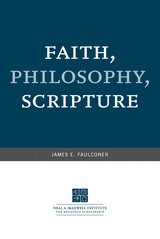 Faith, Philosophy, Scripture
James E. Faulconer
Neal A. Maxwell Institute for Religious Scholarship, 2010 Faith, Philosophy, Scripture is a collection of 10 essays resulting from Professor James E. Faulconer s work as a philosopher and his abiding faith as a Latter-day Saint. Faith is the starting point, and philosophy is its supplement rather than competitor. Faulconer writes, The confidence of my faith, a confidence that came by revelation, has allowed me to hear the questions of philosophy without fear, and philosophy has never asked me to give up my faith, though it has asked questions about it. These essays ask what it means to remember (as our faith often calls us to do), how faith and reason are related to each other, what the place of theology is in revealed religion, and how we should think about scripture. The intent behind the book is to help the reader see how faith, philosophy, and scripture can be part of a whole life, each helping make sense of the others, with faith as the ground and center of them all.
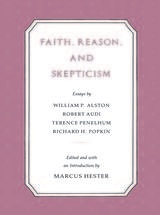 Faith Reason Skepticism
edited by Marcus Hester
Temple University Press, 1992 This book of original essays provides a dialogue between four of the most distinguished scholars now working on problems of faith, reason, and skepticism. In their essays, William P. Alston, Robert Audi, Terence Penelhum, and Richard H. Popkin address both the corrosive and the constructive influences of skepticism on Christian and Jewish concepts of faith. The authors treat questions of perennial interest in philosophy of religion: the bases of human knowledge of God, the place of reason in religious belief, the difference between religious beliefs and those based on common sense, and the reconcilability of skepticism with religious belief.
In terms of current epistemology, Alston explores the implications of reliabilism for Christian knowledge of God. Audi develops a concept of non-doxastic faith, which contrasts with flat-out beliefs, arguing that such faith can support a full range of Christian attitudes and ethics. Penelhum contends that religious beliefs cannot be defended in the same way as beliefs of common sense, and thus natural theology is essential. Popkin demonstrates, in a richly historical study, that Jewish skepticism of the seventeenth and eighteenth centuries was used and can be used to neutralize questionable metaphysical theology while leaving a mysticism and spirituality without creed or institution. The essays are preceded by an Editor's Introduction and the volume concludes with a unifying dialogue between the four authors.
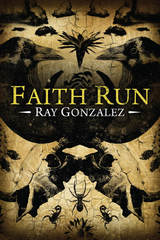 Faith Run
Ray Gonzalez
University of Arizona Press, 2009 Faith Run offers the most recent work by the well-known poet Ray Gonzalez. The poetry here is—at once—perhaps his most personal and most universal. At the heart of these lyrical, sometimes ethereal, poems is a deep sense of the mystery and even the divinity of our human lives. Although Gonzalez invokes the names of many poets who have come before him, including Walt Whitman, Pablo Neruda, Robert Frost, Charles Wright, Allen Ginsberg, and Federico García Lorca, he writes in his own singular voice, one sculpted by the scorched and windblown landscapes of the American Southwest, by the complications of life in a borderland, by the voices of ancestors. With the confident touch of a master craftsman, he creates a new world out of the world we think we know. In his poems, the personal suddenly becomes the cosmic, the mundane unexpectedly becomes the sublime.
For Gonzalez, it seems, we humans can transcend the ordinary—just as these poems transcend genre and create a poetic realm of their own—but we never actually leave behind our rooted, earthbound lives. Although our landscape may be invisible to us, we never escape its powerful magnetism. Nor do we ever abandon our ancestors. No matter how fast or far we run, we can never outrun them. Like gravity, their influence is inexorable.
These poems enchant with their language, which often leaps unexpectedly from worldly to otherworldly in the same stanza, but they cling and linger in our memories—not unlike the voices of friends and relatives.
 The Faithful: A History of Catholics in America
James M. O'Toole
Harvard University Press, 2010 Shaken by the ongoing clergy sexual abuse scandal, and challenged from within by social and theological division, Catholics in America are at a crossroads. But is today’s situation unique? And where will Catholicism go from here? With the belief that we understand our present by studying our past, James O’Toole offers a bold and panoramic history of the American Catholic laity.
O’Toole tells the story of this ancient church from the perspective of ordinary Americans, the lay believers who have kept their faith despite persecution from without and clergy abuse from within. It is an epic tale, from the first settlements of Catholics in the colonies to the turmoil of the scandal-ridden present, and through the church’s many American incarnations in between. We see Catholics’ complex relationship to Rome and to their own American nation. O’Toole brings to life both the grand sweep of institutional change and the daily practice that sustained believers. The Faithful pays particular attention to the intricacies of prayer and ritual—the ways men and women have found to express their faith as Catholics over the centuries.
With an intimate knowledge of the dilemmas and hopes of today’s church, O’Toole presents a new vision and offers a glimpse into the possible future of the church and its parishioners. Moving past the pulpit and into the pews, The Faithful is an unmatched look at the American Catholic laity. Today’s Catholics will find much to educate and inspire them in these pages, and non-Catholics will gain a newfound understanding of their religious brethren.
|
|
